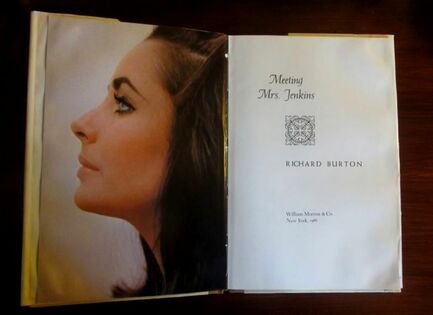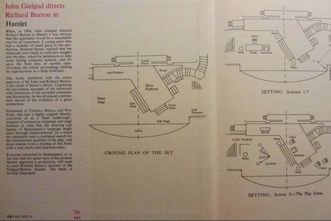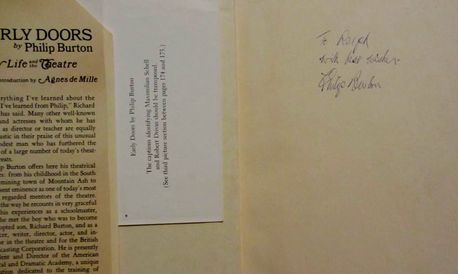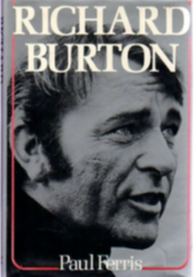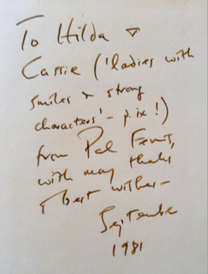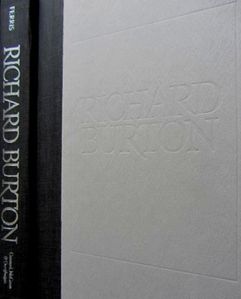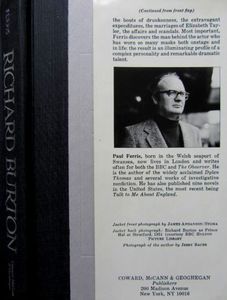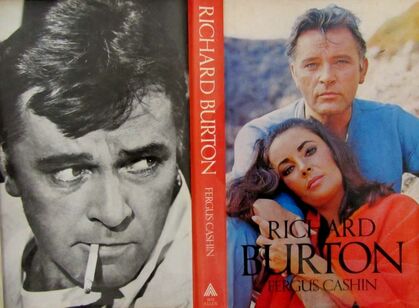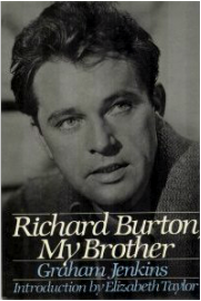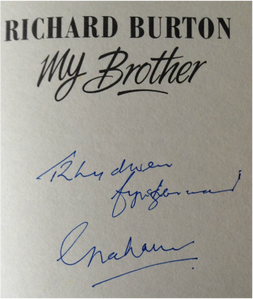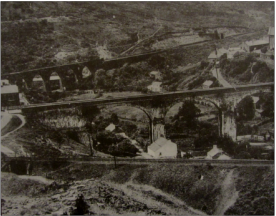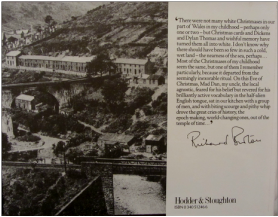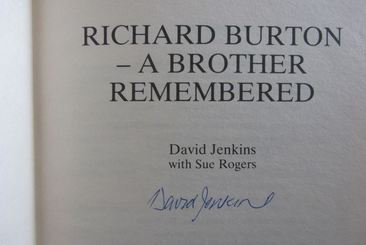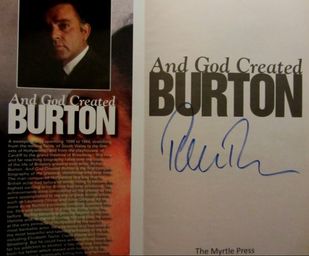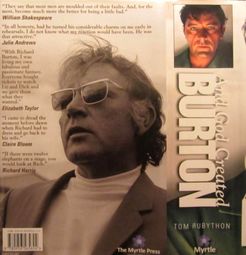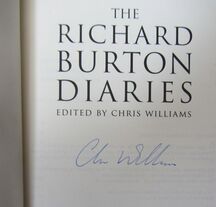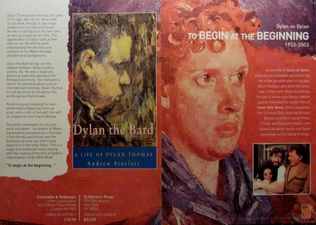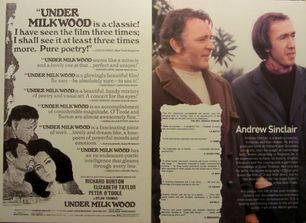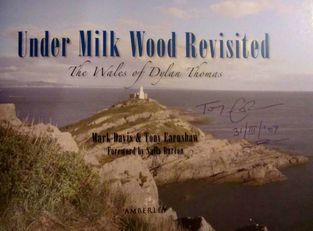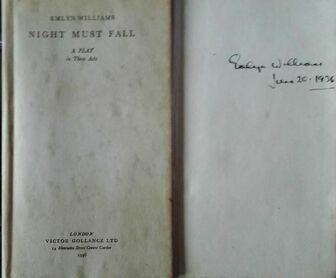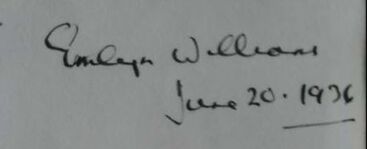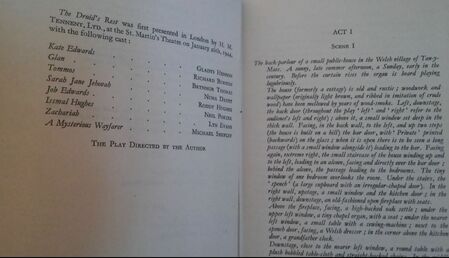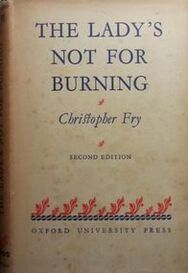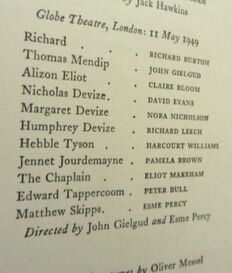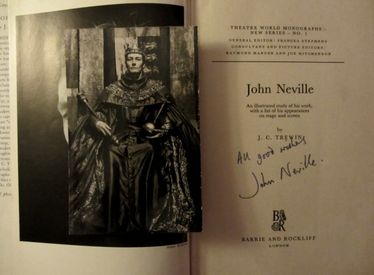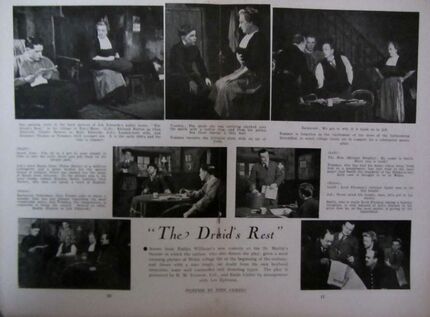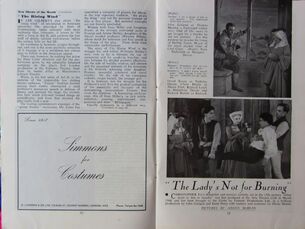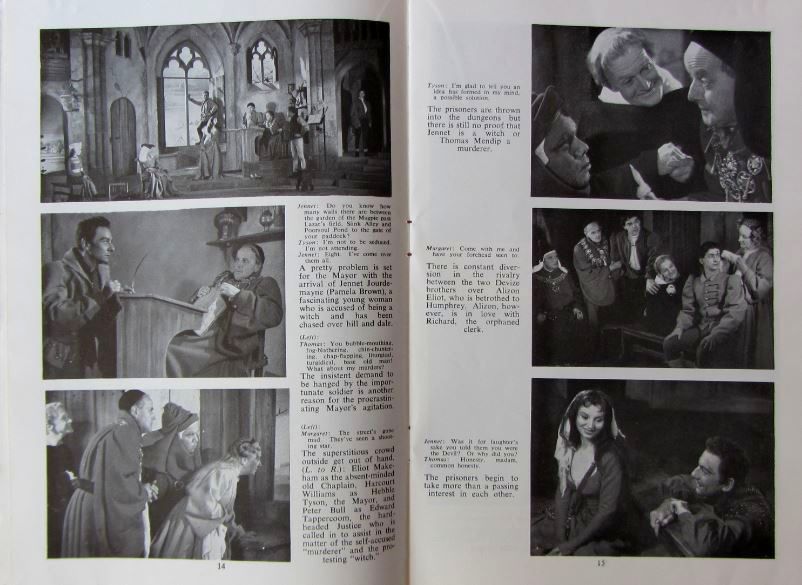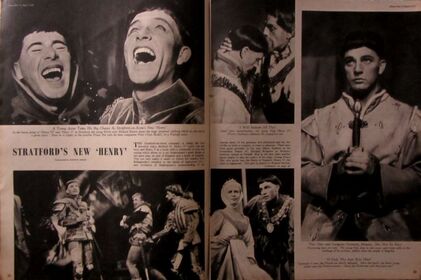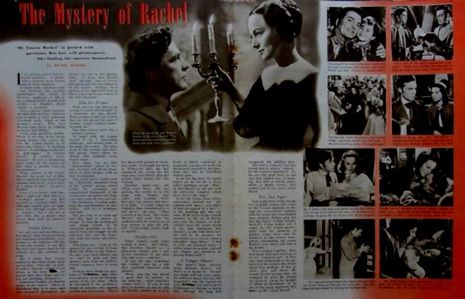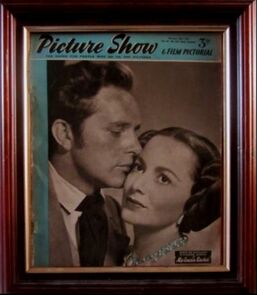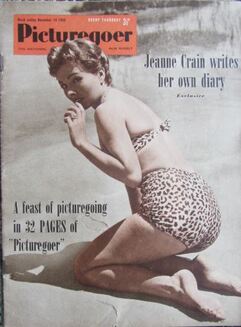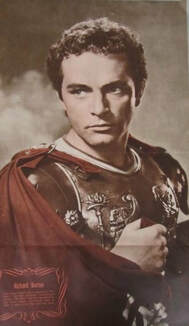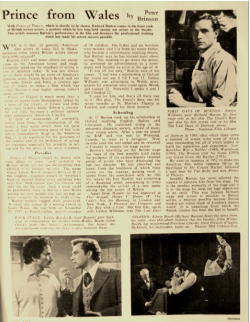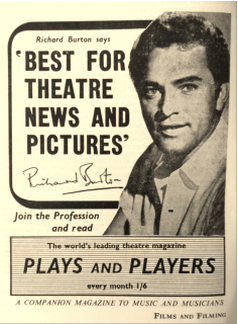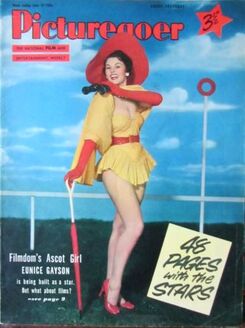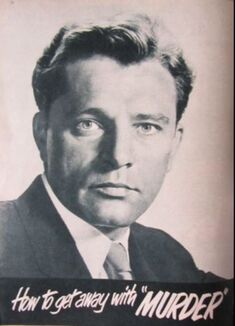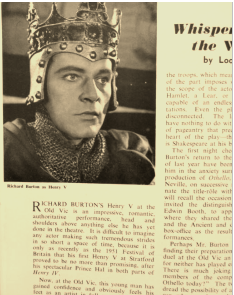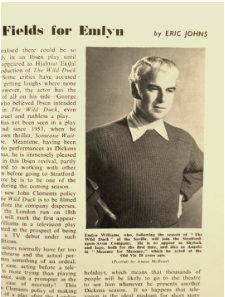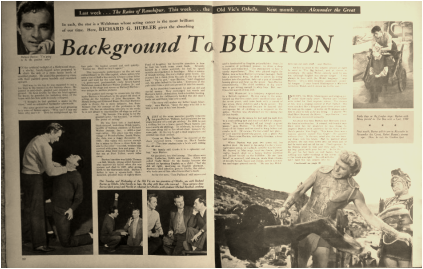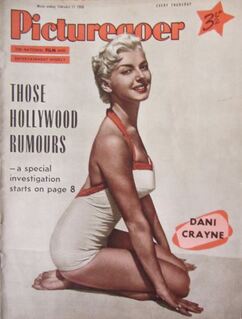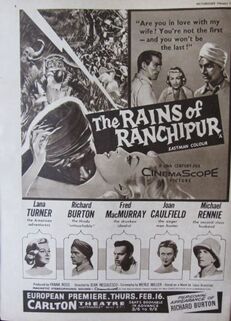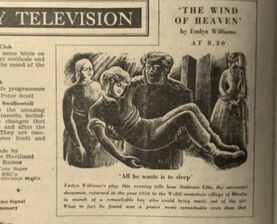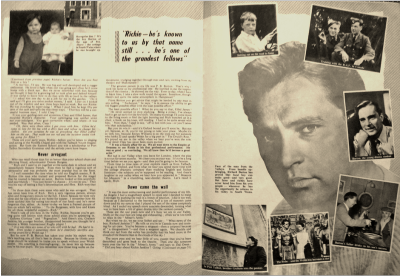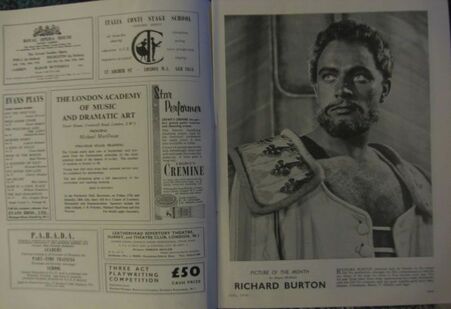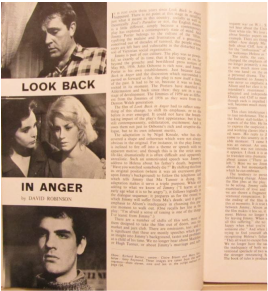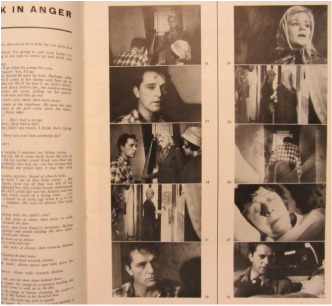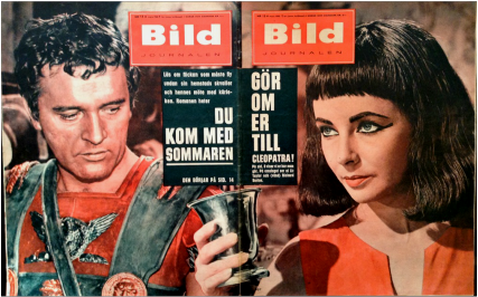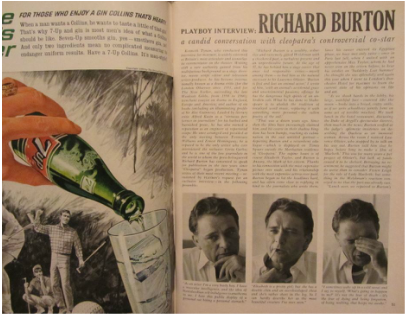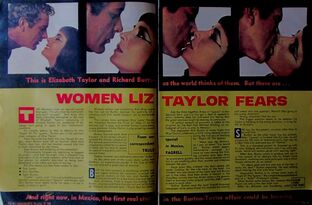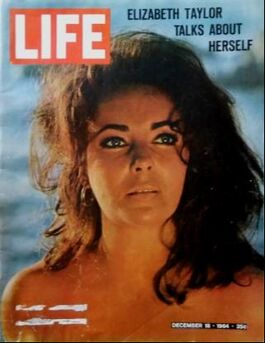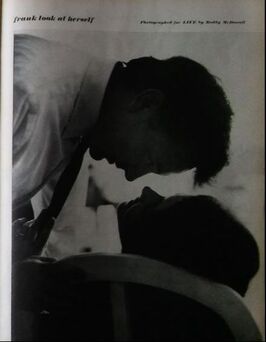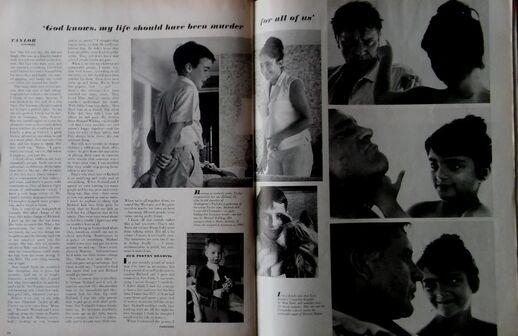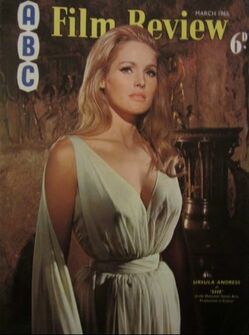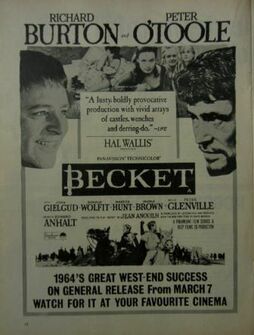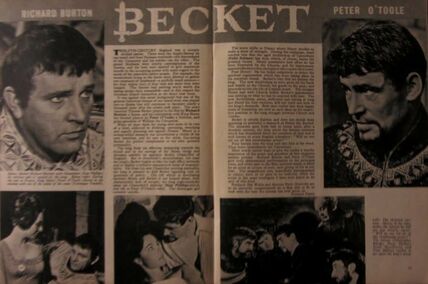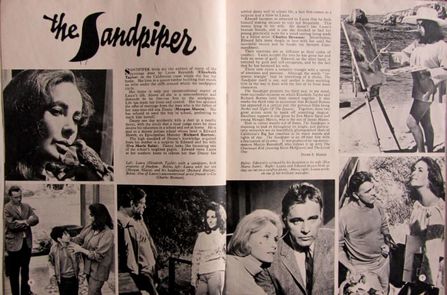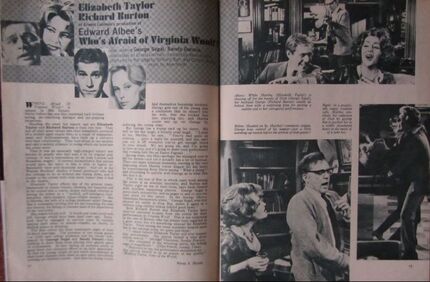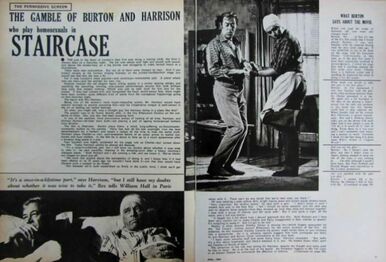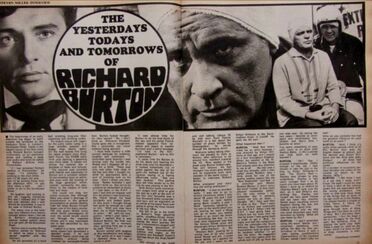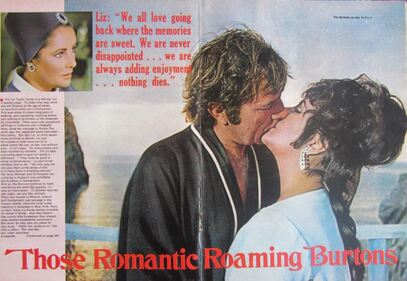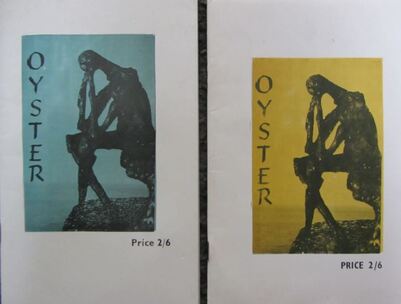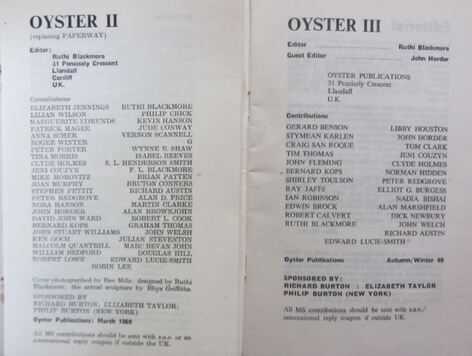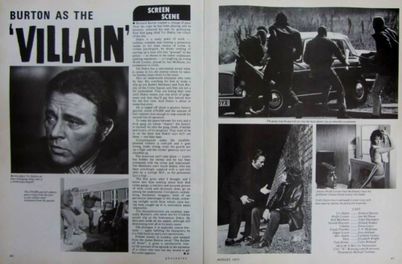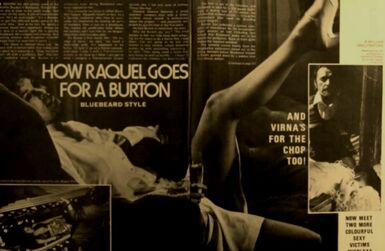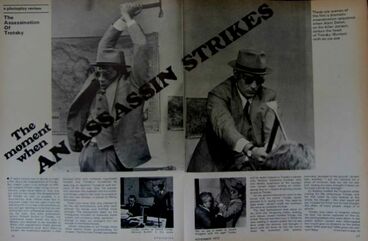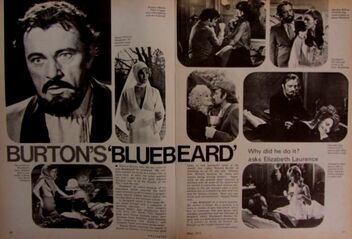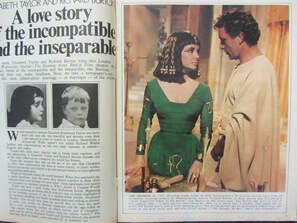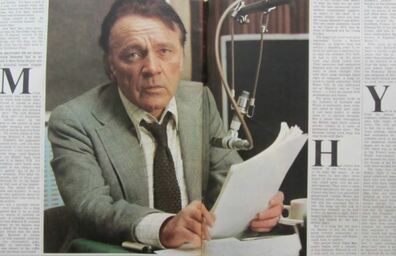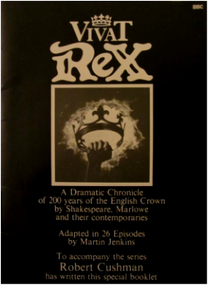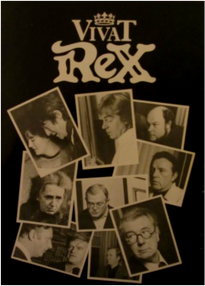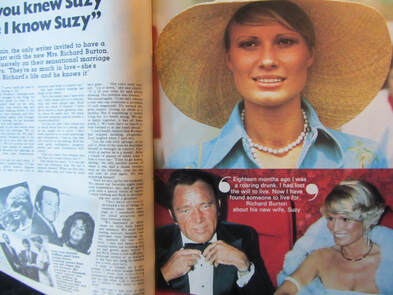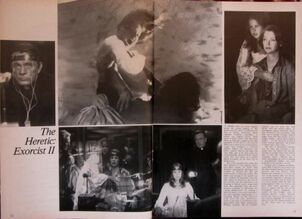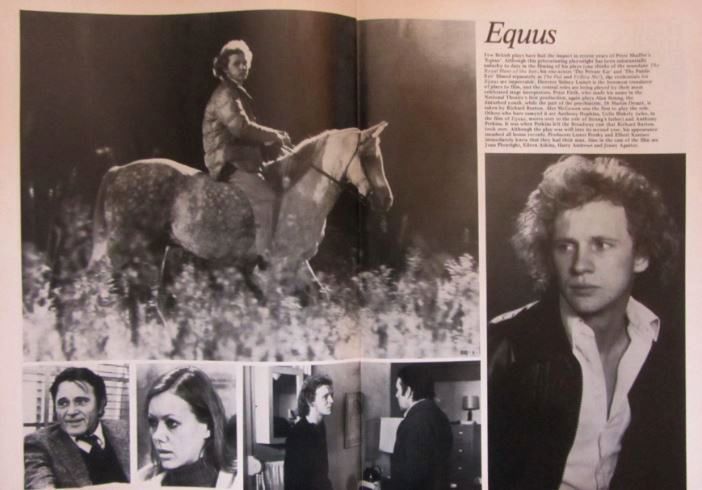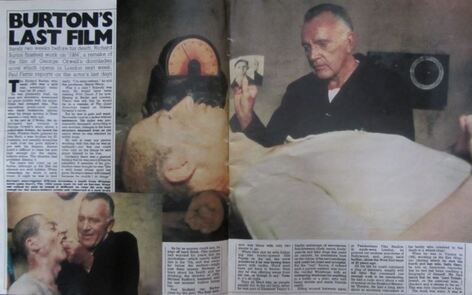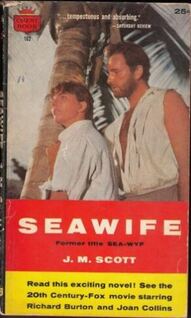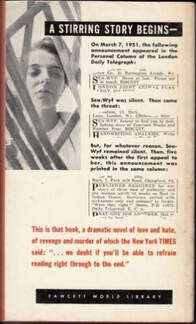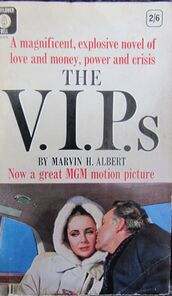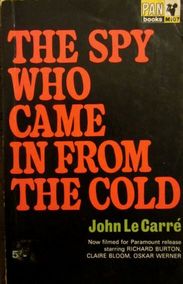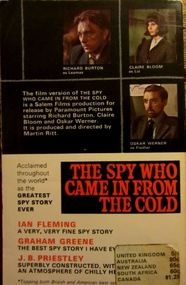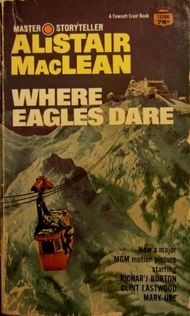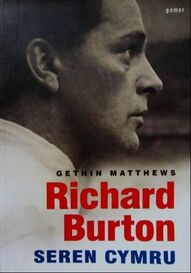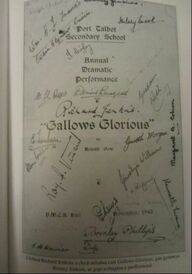A Selected Richard Burton Bibliography
Richard Burton, 'A Christmas Story'
William Heinemann Limited, First Edition, 1964
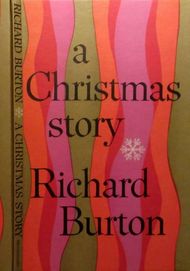
Throughout his life Richard Burton's first love, even more so than acting, was literature and writing, and from his childhood until his death he meticulously kept notebooks and diaries, extracts of which first appeared in Melvyn Bragg's 1988 biography entitled, 'Rich' The Life Of Richard Burton'. All of Burton's diaries, journals and notebooks have since appeared in their entirety in the marvellous book, 'The Richard Burton Diaries', which was edited by Professor Chris Williams and published by the Yale University Press in 2012.
During Richard Burton's career he was often asked to write for, or contribute to, numerous articles for newspapers and magazines. He graciously did, his subjects covering a diverse array of topics, ranging from Sir Winston Churchill, Hamlet, films and filming and his love of Welsh rugby.
'A Christmas Story' was Richard Burton's first published short story. Written very much in the style of his own literary hero, Dylan Thomas, 'A Christmas Story' is a charming, semi-autobiographical account of a Christmas Eve of Richard Burton's childhood. Although very similar in style to that of Dylan Thomas's 'A Child's Christmas In Wales', it is nonetheless, very 'Burton', or perhaps that should be, very 'Jenkins'.
The copy of 'A Christmas Story' which is held in the Richard Burton Museum collection is a first edition copy, complete with the original dust-jacket, which was first published in 1964 by William Heinemann Limited and printed by the Western Printing Services Limited, based in Bristol.
The synopsis of the story, taken from the cover notes, reads;
"Richard Burton has been quoted as saying that he would rather be a writer than an actor. A Christmas Story is singular proof that the ambition is not misplaced. It is a truly memorable tale that will seize and hold the heart of every reader.
Autobiographical in tone, the story is told from the point of view of an eight-year-old boy living in such a Welsh mining town as the one in which Mr. Burton himself spent his childhood. It has a great sense of place, of community and of character, and strength and humour. No one will soon forget Sister and Mad Dan, nor Mrs.Tabor T. B. And 'Tommy Elliott's farm' is likely to become everybody's idea of what not to get for Christmas."
Contemporary reviews of Richard Burton's 'A Christmas Story' which appeared in various American publications of the time, read;
" A moving report of his eighth Christmas, when he longed for a very special present..." Book Week
" Richard Burton might have held his own with such fellow Welshmen as Dylan Thomas and Emlyn Williams...Seasonal and touching and related with literary grace..." Newark News
" Wry humour and a feeling for place and dialogue quicken a story autobiographical in tone..." A. L. A. Booklist
" The story has a vein of real Welsh poetry in it..." Washington News
" The same tenderness which the actor has displayed in dramatic portrayal is seen in this little story. The prose shows a sense of words as well as of emotional experience..." Savannah News
The jacket design and illustrations for this delightful short story were provided by artist Linda Fruhauf.
The back cover features a photographic portrait of Richard Burton in the role of Hamlet from the 1964 Gielgud stage production as photographed by Henry Grossman.
During Richard Burton's career he was often asked to write for, or contribute to, numerous articles for newspapers and magazines. He graciously did, his subjects covering a diverse array of topics, ranging from Sir Winston Churchill, Hamlet, films and filming and his love of Welsh rugby.
'A Christmas Story' was Richard Burton's first published short story. Written very much in the style of his own literary hero, Dylan Thomas, 'A Christmas Story' is a charming, semi-autobiographical account of a Christmas Eve of Richard Burton's childhood. Although very similar in style to that of Dylan Thomas's 'A Child's Christmas In Wales', it is nonetheless, very 'Burton', or perhaps that should be, very 'Jenkins'.
The copy of 'A Christmas Story' which is held in the Richard Burton Museum collection is a first edition copy, complete with the original dust-jacket, which was first published in 1964 by William Heinemann Limited and printed by the Western Printing Services Limited, based in Bristol.
The synopsis of the story, taken from the cover notes, reads;
"Richard Burton has been quoted as saying that he would rather be a writer than an actor. A Christmas Story is singular proof that the ambition is not misplaced. It is a truly memorable tale that will seize and hold the heart of every reader.
Autobiographical in tone, the story is told from the point of view of an eight-year-old boy living in such a Welsh mining town as the one in which Mr. Burton himself spent his childhood. It has a great sense of place, of community and of character, and strength and humour. No one will soon forget Sister and Mad Dan, nor Mrs.Tabor T. B. And 'Tommy Elliott's farm' is likely to become everybody's idea of what not to get for Christmas."
Contemporary reviews of Richard Burton's 'A Christmas Story' which appeared in various American publications of the time, read;
" A moving report of his eighth Christmas, when he longed for a very special present..." Book Week
" Richard Burton might have held his own with such fellow Welshmen as Dylan Thomas and Emlyn Williams...Seasonal and touching and related with literary grace..." Newark News
" Wry humour and a feeling for place and dialogue quicken a story autobiographical in tone..." A. L. A. Booklist
" The story has a vein of real Welsh poetry in it..." Washington News
" The same tenderness which the actor has displayed in dramatic portrayal is seen in this little story. The prose shows a sense of words as well as of emotional experience..." Savannah News
The jacket design and illustrations for this delightful short story were provided by artist Linda Fruhauf.
The back cover features a photographic portrait of Richard Burton in the role of Hamlet from the 1964 Gielgud stage production as photographed by Henry Grossman.
Richard Burton, 'Meeting Mrs. Jenkins'
William Morrow & Company, First Edition, 1966

A first edition copy of the second of the two delightful, semi-autobiographical books which Richard Burton had published in his lifetime.
Richard Burton and Elizabeth Taylor had been married for just over a year when 'Meeting Mrs. Jenkins', was first published in the March 1965 issue of Vogue magazine under the uninspiring title of 'Burton Writes of Taylor'. The publishers decided that it was such a beautiful piece of writing that it should be made more accessible to the general public by being released in book-form, in much the same way 'A Christmas Story' had been published the year before.
Unlike 'A Christmas Story', this second book would be illustrated with colour photographs. Photographer William Klein was hired and captured some stunning images of Elizabeth Taylor on-set in a Paris film studio during the filming of the Metro-Goldwyn-Mayer production of 'The Sandpiper'.
The publishers cover notes for this American first edition copy read;
" In all fairness there should be a law against the lop-sided distribution of talent" wrote Roy Newquist of The Chicago American in reviewing 'A Christmas Story'.
" Not only does Richard Burton possess the most magnetic theatre presence of today, plus the beauteous person of Elizabeth Taylor, but he now turns out to be a first-rate writer."
Richard Burton was born Richard Jenkins. Accordingly, it is the 'beauteous' Elizabeth Taylor Burton of whom he now writes.
In three swift scenes - a house in Bel Air; a restaurant five years later, neither its name nor country or continent remembered; and finally Paris, first the Champs Elysees and then Fouquet's - he achieves a remarkable portrait of both her person and her personality. It is witty. It is by turns fiery and tender, funny and rueful. it is always memorable."
This first-edition American copy was published and printed by William Morrow & Company, New York, on beige boards with gilt lettering. This copy is complete with the original dust-jacket, designed by Lydia Fruhauf who had incidentally illustrated Richard Burton's 'A Christmas Story', published the year before.
Richard Burton and Elizabeth Taylor had been married for just over a year when 'Meeting Mrs. Jenkins', was first published in the March 1965 issue of Vogue magazine under the uninspiring title of 'Burton Writes of Taylor'. The publishers decided that it was such a beautiful piece of writing that it should be made more accessible to the general public by being released in book-form, in much the same way 'A Christmas Story' had been published the year before.
Unlike 'A Christmas Story', this second book would be illustrated with colour photographs. Photographer William Klein was hired and captured some stunning images of Elizabeth Taylor on-set in a Paris film studio during the filming of the Metro-Goldwyn-Mayer production of 'The Sandpiper'.
The publishers cover notes for this American first edition copy read;
" In all fairness there should be a law against the lop-sided distribution of talent" wrote Roy Newquist of The Chicago American in reviewing 'A Christmas Story'.
" Not only does Richard Burton possess the most magnetic theatre presence of today, plus the beauteous person of Elizabeth Taylor, but he now turns out to be a first-rate writer."
Richard Burton was born Richard Jenkins. Accordingly, it is the 'beauteous' Elizabeth Taylor Burton of whom he now writes.
In three swift scenes - a house in Bel Air; a restaurant five years later, neither its name nor country or continent remembered; and finally Paris, first the Champs Elysees and then Fouquet's - he achieves a remarkable portrait of both her person and her personality. It is witty. It is by turns fiery and tender, funny and rueful. it is always memorable."
This first-edition American copy was published and printed by William Morrow & Company, New York, on beige boards with gilt lettering. This copy is complete with the original dust-jacket, designed by Lydia Fruhauf who had incidentally illustrated Richard Burton's 'A Christmas Story', published the year before.
The complete texts to both 'A Christmas Story' and 'Meeting Mrs. Jenkins' can be found on the 'Richard Burton The Writer' page of this website
Ruth Waterbury, 'Richard Burton - His Intimate Story'
Pyramid Books, First Edition, 1965
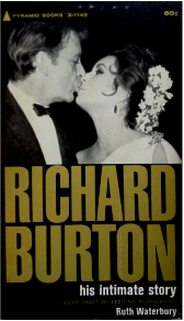
An American first edition copy, published in paperback, of possibly the earliest Richard Burton biography ever published which was written by Ruth Waterbury and simply entitled, 'Richard Burton - His Intimate Story'.
This edition was published by Pyramid Books, based on Madison Avenue, New York, in March 1965 and is described in the cover notes, in typical American hyperbole, with the words;
"The most exciting man in the world - compelling actor, indefatigable lover, a legend of stage, screen and boudoir, Richard Burton has blazed a trail of fame and scandal around the world.
What is he like - really? A great artist and vital human being...or a shallow Don Juan? Here are the revealing answers in exciting detail, an up-to-the-minute, frank portrait of the life and career - and many loves - of the man behind the flaming headlines.
Here is the first full-length inside story of the world's most electrifying actor - and most publicized lover. What made Burton the man he is...and the larger-than-life figure they say he is? Here is Burton's life - his women - and the fierce flame that burns in him, as the artist and as the man".
This edition is illustrated with eight pages of black and white photographs and features a cover designed by the Paul Bacon Studio. The original price of this paperback edition on publication in the United States was just sixty cents.
Ruth Waterbury was a former editor of 'Photoplay' and 'Silver Screen' film magazines and had been writing articles about the Hollywood movie industry since the 1920's and had also been assistant to the legendary Hollywood gossip columnist Louella Parsons.
Ruth Waterbury was also an early biographer of Elizabeth Taylor, and her book 'Elizabeth Taylor- Her Life, Loves And Future' was first published in 1964, a year earlier than this Richard Burton biography.
This edition was published by Pyramid Books, based on Madison Avenue, New York, in March 1965 and is described in the cover notes, in typical American hyperbole, with the words;
"The most exciting man in the world - compelling actor, indefatigable lover, a legend of stage, screen and boudoir, Richard Burton has blazed a trail of fame and scandal around the world.
What is he like - really? A great artist and vital human being...or a shallow Don Juan? Here are the revealing answers in exciting detail, an up-to-the-minute, frank portrait of the life and career - and many loves - of the man behind the flaming headlines.
Here is the first full-length inside story of the world's most electrifying actor - and most publicized lover. What made Burton the man he is...and the larger-than-life figure they say he is? Here is Burton's life - his women - and the fierce flame that burns in him, as the artist and as the man".
This edition is illustrated with eight pages of black and white photographs and features a cover designed by the Paul Bacon Studio. The original price of this paperback edition on publication in the United States was just sixty cents.
Ruth Waterbury was a former editor of 'Photoplay' and 'Silver Screen' film magazines and had been writing articles about the Hollywood movie industry since the 1920's and had also been assistant to the legendary Hollywood gossip columnist Louella Parsons.
Ruth Waterbury was also an early biographer of Elizabeth Taylor, and her book 'Elizabeth Taylor- Her Life, Loves And Future' was first published in 1964, a year earlier than this Richard Burton biography.
Richard L. Sterne, 'John Gielgud Directs Richard Burton In Hamlet - A Journal Of Rehearsals'
Heinemann Publishing Limited, First Edition, 1968
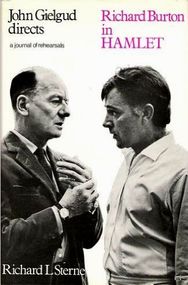
A first edition copy, published in hardback, of actor, Richard L. Sterne's insightful and in-depth memoir entitled, 'John Gielgud Directs Richard Burton In Hamlet - A Journal Of Rehearsals'.
This edition was first published by Heinemann Educational Books Limited, based in Charles Street, London, and was printed and bound on black boards with gilt lettering by Bookprint Limited based in Crawley, Sussex in 1968.
This copy was published by Heinemann Publishing Limited and was issued with the ISBN 435-518352-4.
The price of this book on its first publication in 1968 was thirty shillings.
This informative memoir is Illustrated with black and white photographs taken during the rehearsals and production of this ground-breaking and controversial adaption of Shakespeare's play, courtesy of Friedman-Adeles, and is complete with the original dust-jacket which was designed by Ivor Kaplin.
The cover notes describe this fascinating book perfectly with the synopsis;
'When, in 1964, John Gielgud directed Richard Burton in 'Hamlet' it was obvious that the experience would be a remarkable one for all concerned. A young actor who had a number of small parts in the production, Richard Sterne, realised that the rehearsals were likely to yield new insights into the play, asked for permission to take notes during rehearsal sessions, and hit upon the bold idea of secretly tape-recording the whole proceedings (hiding his tape-recorder in a large briefcase).
This book, published with the entire approval of Sir John and Richard Burton, is the result of Sterne's efforts. Combining his eye-witness accounts of the rehearsals with transcripts of the recorded comments and discussions, he has produced a permanent record of the evolution of a great production.
Performed in Toronto, Boston and New York, this was a highly original 'Hamlet', conceived as a 'final run-through', stripped of extraneous trappings and stage business in order that the meaning and beauty of Shakespeare's language might shine through unencumbered. As a result, the rehearsals were a continual search for the fundamental qualities of the play, and these emerge from a reading of this book with a new clarity and impressiveness.
Everyone interested in Shakespeare, or in the way that two great stars of the modern theatre approach a production, will want to read Richard Sterne's account of the Gielgud / Burton 'Hamlet'. The book is lavishly illustrated'.
This edition was first published by Heinemann Educational Books Limited, based in Charles Street, London, and was printed and bound on black boards with gilt lettering by Bookprint Limited based in Crawley, Sussex in 1968.
This copy was published by Heinemann Publishing Limited and was issued with the ISBN 435-518352-4.
The price of this book on its first publication in 1968 was thirty shillings.
This informative memoir is Illustrated with black and white photographs taken during the rehearsals and production of this ground-breaking and controversial adaption of Shakespeare's play, courtesy of Friedman-Adeles, and is complete with the original dust-jacket which was designed by Ivor Kaplin.
The cover notes describe this fascinating book perfectly with the synopsis;
'When, in 1964, John Gielgud directed Richard Burton in 'Hamlet' it was obvious that the experience would be a remarkable one for all concerned. A young actor who had a number of small parts in the production, Richard Sterne, realised that the rehearsals were likely to yield new insights into the play, asked for permission to take notes during rehearsal sessions, and hit upon the bold idea of secretly tape-recording the whole proceedings (hiding his tape-recorder in a large briefcase).
This book, published with the entire approval of Sir John and Richard Burton, is the result of Sterne's efforts. Combining his eye-witness accounts of the rehearsals with transcripts of the recorded comments and discussions, he has produced a permanent record of the evolution of a great production.
Performed in Toronto, Boston and New York, this was a highly original 'Hamlet', conceived as a 'final run-through', stripped of extraneous trappings and stage business in order that the meaning and beauty of Shakespeare's language might shine through unencumbered. As a result, the rehearsals were a continual search for the fundamental qualities of the play, and these emerge from a reading of this book with a new clarity and impressiveness.
Everyone interested in Shakespeare, or in the way that two great stars of the modern theatre approach a production, will want to read Richard Sterne's account of the Gielgud / Burton 'Hamlet'. The book is lavishly illustrated'.
The front-end papers and a few of the photographic images which grace this first edition copy of 'John Gielgud Directs Richard Burton in Hamlet'.
Philip Burton, 'Early Doors - My Life And The Theatre '
The Dial Press Incorporated, Signed First Edition, 1969
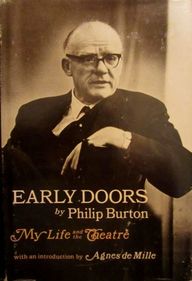
A very rare and special edition of the American first edition copy of Philip Burton's highly important autobiography entitled, 'Early Doors - My Life And The Theatre'.
This copy was published and printed on beige cloth boards with black lettering by the Dial Press Incorporated based on Third Avenue, New York in 1969 and is complete with the original dust- jacket.
Included in this volume are twenty-four pages of photographs, many of which feature Richard Burton. The dust-jacket was designed by Thomas Clemens for The Dial Press and the cover portrait of Philip Burton was photographed by Alan Grossman.
In extracts, taken from the publishers cover notes, it is noted that;
"Everything I've learned about the theatre, I've learned from Philip", Richard Burton has said. Many other well-known actors and actresses with whom he has worked as director or teacher are equally enthusiastic in their praise of this unusual and modest man who has furthered the careers of a large number of today's theatrical greats.
Philip Burton offers here his theatrical memoirs; from his childhood in the South Wales mining town of Mountain Ash to his present eminence as one of today's most highly regarded mentors of the theatre. Along the way he recounts in very graceful prose his experiences as a schoolmaster, where he met the boy who was to become his adopted son, Richard Burton, and as a producer, writer, director, actor, and instructor in the theatre and for the British Broadcasting Corporation. He is presently President and Director of the American Musical and Dramatic Academy, a unique institution dedicated to the training of professional actors.
In addition to recalling his experiences on both sides of the footlights Mr. Burton tells us of his friendships with some of the foremost literary and theatrical figures of our times, and he presents his personal analysis of particular plays in stimulating and sometimes surprising interpretations.
'Early Doors' is a delightful reminiscence which will provide the reader with a memorable and rewarding insight into the background and personality of a distinguished man of the theatre".
As Agnes de Mille, the American Theatre choreographer and niece of acclaimed Hollywood director Cecil B. DeMille, writes in her preface to this biography;
"The last chapters of this book are pure gold for anyone concerned with the theatre arts. But throughout the whole there are scattered terse bits of philosophic wisdom he learned under fire on the battlefront, not just about the theatre - about life and people. they're true, they're economic, and they're unforgettable. The earlier chapters, the progress toward learning, are very touching indeed. Other people we can name have had possibly greater success. But I think none have had more joy, and this blessed happiness in work he has known all along the way. This is a wonderful thing....
"Reader turn the page."
Prior to proudly being added to the Richard Burton Museum collection, this first edition copy of Philip Burton's biography, 'Early Doors', was the property of the Estate of Canadian literary scholar and Dylan Thomas expert, Professor Ralph Maud.
Professor Ralph Maud, whose many works feature on the 'Dylan Thomas Treasury' page of this website, sadly passed away in 2014. It is to Professor Maud whom this copy was signed and dedicated to by his friend, the author of this marvellous memoir, Philip Burton.
This copy was published and printed on beige cloth boards with black lettering by the Dial Press Incorporated based on Third Avenue, New York in 1969 and is complete with the original dust- jacket.
Included in this volume are twenty-four pages of photographs, many of which feature Richard Burton. The dust-jacket was designed by Thomas Clemens for The Dial Press and the cover portrait of Philip Burton was photographed by Alan Grossman.
In extracts, taken from the publishers cover notes, it is noted that;
"Everything I've learned about the theatre, I've learned from Philip", Richard Burton has said. Many other well-known actors and actresses with whom he has worked as director or teacher are equally enthusiastic in their praise of this unusual and modest man who has furthered the careers of a large number of today's theatrical greats.
Philip Burton offers here his theatrical memoirs; from his childhood in the South Wales mining town of Mountain Ash to his present eminence as one of today's most highly regarded mentors of the theatre. Along the way he recounts in very graceful prose his experiences as a schoolmaster, where he met the boy who was to become his adopted son, Richard Burton, and as a producer, writer, director, actor, and instructor in the theatre and for the British Broadcasting Corporation. He is presently President and Director of the American Musical and Dramatic Academy, a unique institution dedicated to the training of professional actors.
In addition to recalling his experiences on both sides of the footlights Mr. Burton tells us of his friendships with some of the foremost literary and theatrical figures of our times, and he presents his personal analysis of particular plays in stimulating and sometimes surprising interpretations.
'Early Doors' is a delightful reminiscence which will provide the reader with a memorable and rewarding insight into the background and personality of a distinguished man of the theatre".
As Agnes de Mille, the American Theatre choreographer and niece of acclaimed Hollywood director Cecil B. DeMille, writes in her preface to this biography;
"The last chapters of this book are pure gold for anyone concerned with the theatre arts. But throughout the whole there are scattered terse bits of philosophic wisdom he learned under fire on the battlefront, not just about the theatre - about life and people. they're true, they're economic, and they're unforgettable. The earlier chapters, the progress toward learning, are very touching indeed. Other people we can name have had possibly greater success. But I think none have had more joy, and this blessed happiness in work he has known all along the way. This is a wonderful thing....
"Reader turn the page."
Prior to proudly being added to the Richard Burton Museum collection, this first edition copy of Philip Burton's biography, 'Early Doors', was the property of the Estate of Canadian literary scholar and Dylan Thomas expert, Professor Ralph Maud.
Professor Ralph Maud, whose many works feature on the 'Dylan Thomas Treasury' page of this website, sadly passed away in 2014. It is to Professor Maud whom this copy was signed and dedicated to by his friend, the author of this marvellous memoir, Philip Burton.
Professor Ralph Maud's personally owned copy of 'Early Doors', signed and dedicated, 'To Ralph, with best wishes, Philip Burton'.
'Acting In The Sixties' Edited by Hal Burton
British Broadcasting Corporation Books, First Edition, 1970
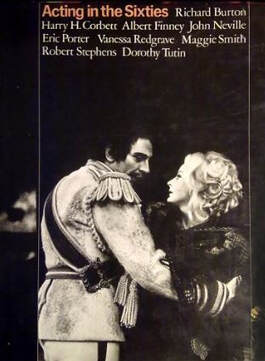
A first edition copy, in hardback, of the British Broadcasting Corporation publication, 'Acting in the Sixties'.
The book is a collection of transcribed interviews with eminent stage and screen actors who came to prominence during that decade. The book was edited by theatre and screen director and producer, Hal Burton.
The actors who feature in this collection include Richard Burton, interviewed by theatre critic Kenneth Tynan, as well as Harry H. Corbett, Albert Finney, John Neville, Eric Porter, Vanessa Redgrave, Maggie Smith, Robert Stephens and Dorothy Tutin.
The chapter dedicated to Richard Burton features photographs from his performances in; 'Who's Afraid of Virginia Woolf?', 'Doctor Faustus', 'The Druid's Rest', 'The Lady's Not For Burning', 'The Boy With A Cart', performances from theatre productions at Stratford and the Old Vic, 'The Last Days of Dolwyn', 'Cleopatra', 'Becket', 'Look Back in Anger' and 'The Taming of the Shrew'.
This first edition copy of 'Acting in the Sixties' was published by the B.B.C. on cream cloth boards with gilt lettering to the spine in 1970 with the ISBN. 563-08576-2, and was printed by the Broadwater Press Limited based in Welwyn Garden City, Hertfordshire. This copy is complete with the original dust-jacket which features photographs of Maggie Smith, Robert Stephens, Albert Finney, Vanessa Redgrave and Dorothy Tutin.
The cover notes for this excellent publication read;
"For the British theatre, the 1960's were a period of both experiment and realisation. The National Theatre came into being and the Royal Shakespeare Company expanded; theatre centres were set up outside London; playwrights experimented freely; and directors brought a fresh approach to production. At the same time the impact of television made itself felt not only on the theatre but particularly on the cinema.
The actor who works within this changing field is not vastly different from his predecessors, but his material has changed and his life is more competitive and exacting.
This book is based on a series of programmes originally shown on BBC television. Following on 'Great Acting', it is devoted to a younger generation of actors and actresses; Richard Burton and Albert Finney were natural choices to talk about acting for the films, Eric Porter and Harry H. Corbett for television, Dorothy Tutin and Vanessa Redgrave are outstanding leading ladies, and Maggie Smith, herself a superb comedienne, and Robert Stephens have been with the National Theatre since it began; finally John Neville, a leading actor, has been vitally concerned with the theatre outside London. As a group they are representative of all that is best in English acting during the 1960's."
The book is a collection of transcribed interviews with eminent stage and screen actors who came to prominence during that decade. The book was edited by theatre and screen director and producer, Hal Burton.
The actors who feature in this collection include Richard Burton, interviewed by theatre critic Kenneth Tynan, as well as Harry H. Corbett, Albert Finney, John Neville, Eric Porter, Vanessa Redgrave, Maggie Smith, Robert Stephens and Dorothy Tutin.
The chapter dedicated to Richard Burton features photographs from his performances in; 'Who's Afraid of Virginia Woolf?', 'Doctor Faustus', 'The Druid's Rest', 'The Lady's Not For Burning', 'The Boy With A Cart', performances from theatre productions at Stratford and the Old Vic, 'The Last Days of Dolwyn', 'Cleopatra', 'Becket', 'Look Back in Anger' and 'The Taming of the Shrew'.
This first edition copy of 'Acting in the Sixties' was published by the B.B.C. on cream cloth boards with gilt lettering to the spine in 1970 with the ISBN. 563-08576-2, and was printed by the Broadwater Press Limited based in Welwyn Garden City, Hertfordshire. This copy is complete with the original dust-jacket which features photographs of Maggie Smith, Robert Stephens, Albert Finney, Vanessa Redgrave and Dorothy Tutin.
The cover notes for this excellent publication read;
"For the British theatre, the 1960's were a period of both experiment and realisation. The National Theatre came into being and the Royal Shakespeare Company expanded; theatre centres were set up outside London; playwrights experimented freely; and directors brought a fresh approach to production. At the same time the impact of television made itself felt not only on the theatre but particularly on the cinema.
The actor who works within this changing field is not vastly different from his predecessors, but his material has changed and his life is more competitive and exacting.
This book is based on a series of programmes originally shown on BBC television. Following on 'Great Acting', it is devoted to a younger generation of actors and actresses; Richard Burton and Albert Finney were natural choices to talk about acting for the films, Eric Porter and Harry H. Corbett for television, Dorothy Tutin and Vanessa Redgrave are outstanding leading ladies, and Maggie Smith, herself a superb comedienne, and Robert Stephens have been with the National Theatre since it began; finally John Neville, a leading actor, has been vitally concerned with the theatre outside London. As a group they are representative of all that is best in English acting during the 1960's."
'The Screenplay of Dylan Thomas' Under Milk Wood'
Lorrimer Publishing Limited, First Edition, 1972
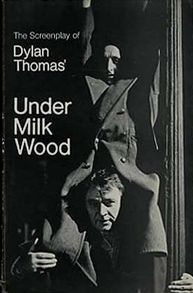
A first edition copy, published in paperback, of Andrew Sinclair's screenplay for his 1972 Timon Films production of the Dylan Thomas play, 'Under Milk Wood', which starred Richard Burton, Elizabeth Taylor and Peter O' Toole.
This copy was published by Lorrimer Publishing Limited of Dean Street, London in association with J.M. Dent and Sons in 1972 and was printed and bound by Villiers Publications Limited, London and issued with the ISBN 900855-55-X.
This edition features an extensive introduction written by director Andrew Sinclair entitled, 'Milk Wood and Magic', a full cast list for the 1972 film and is illustrated throughout with black and white still images from the film.
Alexander Walker, writing for The Evening Standard, said of 'Under Milk Wood';
"Under Milk Wood got a great public ovation. It soaks in beauty from it's Fishguard landscape. It's verse is spoken with the freshness that the cast might get from their first drink of the day".
The cover also features two black and white images of Richard Burton, alongside Ryan Davies, on the front cover and is pictured with Elizabeth Taylor and Peter O' Toole on the reverse. Both images were taken from Andrew Sinclair's 1972 adaption of 'Under Milk Wood'.
This edition is included in the Richard Burton 'Books And Magazines' section of this website as it relates more to the 1972 film adaption rather than Dylan Thomas's original play.
This copy was published by Lorrimer Publishing Limited of Dean Street, London in association with J.M. Dent and Sons in 1972 and was printed and bound by Villiers Publications Limited, London and issued with the ISBN 900855-55-X.
This edition features an extensive introduction written by director Andrew Sinclair entitled, 'Milk Wood and Magic', a full cast list for the 1972 film and is illustrated throughout with black and white still images from the film.
Alexander Walker, writing for The Evening Standard, said of 'Under Milk Wood';
"Under Milk Wood got a great public ovation. It soaks in beauty from it's Fishguard landscape. It's verse is spoken with the freshness that the cast might get from their first drink of the day".
The cover also features two black and white images of Richard Burton, alongside Ryan Davies, on the front cover and is pictured with Elizabeth Taylor and Peter O' Toole on the reverse. Both images were taken from Andrew Sinclair's 1972 adaption of 'Under Milk Wood'.
This edition is included in the Richard Burton 'Books And Magazines' section of this website as it relates more to the 1972 film adaption rather than Dylan Thomas's original play.
Lester David and Jhan Robbins, 'Richard & Elizabeth'
Arthur Barker Limited, First Edition, 1977
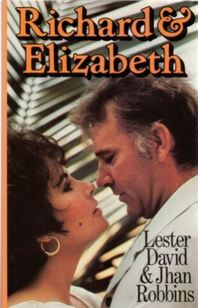
A first edition copy of the U.K. edition of the Lester David and Jhan Robbins biography, 'Richard & Elizabeth'.
This U.K. edition was published by Arthur Barker Limited, London, a subsidiary of Weidenfeld Publishers and was printed on brown cloth boards with gilt lettering on the spine by Cox and Wyman Limited of London and Reading in 1977.
This copy is illustrated with centre pages of black and white photographs and is complete with the original dust-jacket, designed by Grant Bradford.
This edition of 'Richard & Elizabeth' was issued with the ISBN 0-213-16660-7.
In their combined careers, Lester David and Jhan Robbins had interviewed and had books and articles published relating to some of the most influential and interesting people of the twentieth century. Lester David began his freelance writing career on 'The Brooklyn Eagle' in 1935 and wrote regularly for publications such as 'Good Housekeeping' and 'The Ladies Home Journal' and was also the biographer of Senator Ted Kennedy and Presidential First Lady, Pat Nixon.
Jhan Robbins, also a freelance writer, had, during his early career, been published in 'Reader's Digest' and 'McCalls' and was also the author of various biographies whose various subjects included the actors, James Stewart and Helen Hayes and American President Harry Truman. Jhan Robbins died in 1996 at the age of seventy-six, followed a year later by Lester David at the age of eighty-three.
This U.K. edition was published by Arthur Barker Limited, London, a subsidiary of Weidenfeld Publishers and was printed on brown cloth boards with gilt lettering on the spine by Cox and Wyman Limited of London and Reading in 1977.
This copy is illustrated with centre pages of black and white photographs and is complete with the original dust-jacket, designed by Grant Bradford.
This edition of 'Richard & Elizabeth' was issued with the ISBN 0-213-16660-7.
In their combined careers, Lester David and Jhan Robbins had interviewed and had books and articles published relating to some of the most influential and interesting people of the twentieth century. Lester David began his freelance writing career on 'The Brooklyn Eagle' in 1935 and wrote regularly for publications such as 'Good Housekeeping' and 'The Ladies Home Journal' and was also the biographer of Senator Ted Kennedy and Presidential First Lady, Pat Nixon.
Jhan Robbins, also a freelance writer, had, during his early career, been published in 'Reader's Digest' and 'McCalls' and was also the author of various biographies whose various subjects included the actors, James Stewart and Helen Hayes and American President Harry Truman. Jhan Robbins died in 1996 at the age of seventy-six, followed a year later by Lester David at the age of eighty-three.
Lester David and Jhan Robbins, 'Richard & Elizabeth'
Funk & Wagnalls, American First Edition, 1977
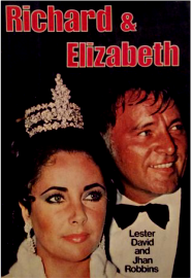
An American first edition copy, published in hardback, of journalists Lester David and Jhan Robbins detailed biography entitled, 'Richard And Elizabeth'.
This edition was published by Funk and Wagnalls, based in New York, in 1977 and issued with the ISBN 0-308-10294-0.
This edition is illustrated with black and white photographs and is complete with the original dust-jacket.
The cover notes to this absorbing and fascinating book read;
"There have been other sensational romances and marriages in our time but the lives of no other couple were so wildly and impetuously entwined as those of Elizabeth Taylor and Richard Burton. Yet in 1976, after a passionate relationship lasting fifteen years - years of loving, clashing, separating, reuniting, all played on a world stage in the grand scale - they were divorced and each remarried.
To find out why this famous marriage collapsed and to get the inside story of their life together, two veteran journalists interviewed more than two hundred relatives, friends, fellow actors and actresses, and co-workers. They come up with some surprising answers as well as with a host of entertaining and fresh new anecdotes and intimate details never before revealed.
In the early 1960's, the Taylor - Burton affair scandalized the world - and made bigger headlines than did the Cuban missile crisis. Going deeply into the chaotic marriage that followed, the authors describe the couple's incredible lifestyle.Their battles were as monumental as their stature in show business, often fought before friends and even strangers. The authors discuss candidly Burton's drinking - "Booze nearly killed me," he admits - and how he squandered his great gifts to the point where ominous comparisons were being made to John Barrymore's last years. They tell how Elizabeth did everything she could to stop his decline but failed, and how ultimately the marriage ended.
Then, written off as a has-been, Burton undertook a cold turkey cure and came back gloriously to the stage and to Elizabeth. But astonishingly, after only a few months, the Burtons separated once more and now it is over - this love so profound that Elizabeth once said, "I gave everything away...my soul, my being, everything." What happened? Will they be happy apart?
In probing the lives of this famous couple and describing their mad, glittering life, Lester David and Jhan Robbins not only show us two superstars in action but also provide a commentary on our society which expects our celebrities to entertain us off-stage as well as on."
The dust-jacket to this American edition of 'Richard And Elizabeth was designed by Judith Woracek. The book itself was dedicated to Richard Burton and Elizabeth Taylor by the authors with the words, "We shall not look upon their like again."
This edition was published by Funk and Wagnalls, based in New York, in 1977 and issued with the ISBN 0-308-10294-0.
This edition is illustrated with black and white photographs and is complete with the original dust-jacket.
The cover notes to this absorbing and fascinating book read;
"There have been other sensational romances and marriages in our time but the lives of no other couple were so wildly and impetuously entwined as those of Elizabeth Taylor and Richard Burton. Yet in 1976, after a passionate relationship lasting fifteen years - years of loving, clashing, separating, reuniting, all played on a world stage in the grand scale - they were divorced and each remarried.
To find out why this famous marriage collapsed and to get the inside story of their life together, two veteran journalists interviewed more than two hundred relatives, friends, fellow actors and actresses, and co-workers. They come up with some surprising answers as well as with a host of entertaining and fresh new anecdotes and intimate details never before revealed.
In the early 1960's, the Taylor - Burton affair scandalized the world - and made bigger headlines than did the Cuban missile crisis. Going deeply into the chaotic marriage that followed, the authors describe the couple's incredible lifestyle.Their battles were as monumental as their stature in show business, often fought before friends and even strangers. The authors discuss candidly Burton's drinking - "Booze nearly killed me," he admits - and how he squandered his great gifts to the point where ominous comparisons were being made to John Barrymore's last years. They tell how Elizabeth did everything she could to stop his decline but failed, and how ultimately the marriage ended.
Then, written off as a has-been, Burton undertook a cold turkey cure and came back gloriously to the stage and to Elizabeth. But astonishingly, after only a few months, the Burtons separated once more and now it is over - this love so profound that Elizabeth once said, "I gave everything away...my soul, my being, everything." What happened? Will they be happy apart?
In probing the lives of this famous couple and describing their mad, glittering life, Lester David and Jhan Robbins not only show us two superstars in action but also provide a commentary on our society which expects our celebrities to entertain us off-stage as well as on."
The dust-jacket to this American edition of 'Richard And Elizabeth was designed by Judith Woracek. The book itself was dedicated to Richard Burton and Elizabeth Taylor by the authors with the words, "We shall not look upon their like again."
Paul Ferris, 'Richard Burton'
Weidenfeld & Nicolson Limited, Signed First Edition, 1981
A first edition copy, published in hardback, of the wonderful Paul Ferris biography simply entitled, 'Richard Burton'.
This first edition was published by Weidenfeld and Nicolson Limited and was printed and bound on red cloth boards with silver gilt lettering by Butler and Tanner Limited, London, in 1981 and issued with the ISBN 0-297-77966-4.
This edition is illustrated with sixteen pages of black and white photographs.
The front cover portrait of Richard Burton was photographed by Gianni Bozzacchi and the book jacket was designed by Andrew Kay.
The book itself was designed by Joyce Chester.
The cover notes to this excellent biography read;
"He was a film star in the days before film stars ceased to be magical creatures", writes Paul Ferris. 'Studio publicists turned out potted biographies that hinted at his wild, Celtic nature. Newspapers gobbled them up. Burton gave interviews and improved on the facts out of devilment, nostalgia or simply boredom. His past became larger than life. It was hardly surprising, since his present, too, in the years of his rampant relationship with Elizabeth Taylor, came to look like a press agent's invention. The film industry thrives on exaggeration, and the Welsh are among the least straightforward of people; it is a deadly mixture.'
Born Richard Jenkins in 1925, a coalminer's son, he was given a new name and a push in the right direction by a fond schoolmaster, Philip Burton; his protege did better than he could have hoped and worse than he might have feared. His fiery talents made him the most acclaimed actor of his generation before he was thirty, a Celtic Olivier; while twenty years later he could look back on the world's most famous marriage, on wealth, notoriety and a second career making films that ranged from brilliant to mediocre to bad beyond belief. Now something of a changed man, he is still only fifty-five. Burton's story is heroic and flawed in turn but never less than the result of a remarkable nature in action. This biography, meticulously researched by Paul Ferris in Britain and America, will increase respect for Burton's talents and regret for his lost years."
This first edition copy, complete with the original dust-jacket, designed by Andrew Kay, was previously owned by two of Richard Burton's sisters, namely Hilda and Catherine (Cassie), and has been signed and dedicated to them both by the author Paul Ferris with a note which reads.. 'To Hilda and Cassie (Ladies with smiles and strong characters - p.ix!) from Paul Ferris, with many thanks and best wishes - September 1981'.
The 'p.ix' to which Paul Ferris was referring to on the signed front page of this first edition is page nine of the text to the introduction in which he thanks each of Richard Burton's sisters by name who spoke to him during his research for this outstanding book.
This first edition was published by Weidenfeld and Nicolson Limited and was printed and bound on red cloth boards with silver gilt lettering by Butler and Tanner Limited, London, in 1981 and issued with the ISBN 0-297-77966-4.
This edition is illustrated with sixteen pages of black and white photographs.
The front cover portrait of Richard Burton was photographed by Gianni Bozzacchi and the book jacket was designed by Andrew Kay.
The book itself was designed by Joyce Chester.
The cover notes to this excellent biography read;
"He was a film star in the days before film stars ceased to be magical creatures", writes Paul Ferris. 'Studio publicists turned out potted biographies that hinted at his wild, Celtic nature. Newspapers gobbled them up. Burton gave interviews and improved on the facts out of devilment, nostalgia or simply boredom. His past became larger than life. It was hardly surprising, since his present, too, in the years of his rampant relationship with Elizabeth Taylor, came to look like a press agent's invention. The film industry thrives on exaggeration, and the Welsh are among the least straightforward of people; it is a deadly mixture.'
Born Richard Jenkins in 1925, a coalminer's son, he was given a new name and a push in the right direction by a fond schoolmaster, Philip Burton; his protege did better than he could have hoped and worse than he might have feared. His fiery talents made him the most acclaimed actor of his generation before he was thirty, a Celtic Olivier; while twenty years later he could look back on the world's most famous marriage, on wealth, notoriety and a second career making films that ranged from brilliant to mediocre to bad beyond belief. Now something of a changed man, he is still only fifty-five. Burton's story is heroic and flawed in turn but never less than the result of a remarkable nature in action. This biography, meticulously researched by Paul Ferris in Britain and America, will increase respect for Burton's talents and regret for his lost years."
This first edition copy, complete with the original dust-jacket, designed by Andrew Kay, was previously owned by two of Richard Burton's sisters, namely Hilda and Catherine (Cassie), and has been signed and dedicated to them both by the author Paul Ferris with a note which reads.. 'To Hilda and Cassie (Ladies with smiles and strong characters - p.ix!) from Paul Ferris, with many thanks and best wishes - September 1981'.
The 'p.ix' to which Paul Ferris was referring to on the signed front page of this first edition is page nine of the text to the introduction in which he thanks each of Richard Burton's sisters by name who spoke to him during his research for this outstanding book.
Paul Ferris, 'Richard Burton'
Coward, McCann & Geoghegan, First Edition, 1981
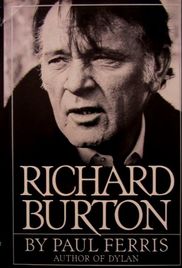
An American first edition copy of the marvellous Paul Ferris biography simply entitled, 'Richard Burton', dating from 1981.
This copy was published for the American market in hardback by Coward, McCann and Geoghegan Publishers, based in New York in 1981 and is complete with the original, yet differently designed, American dust-jacket.
This copy was published on grey and black cloth boards with silver gilt lettering and is beautifully embossed with 'Richard Burton' on the front cover.
This American, first edition copy was issued with the ISBN 698-11106-0.
The front cover photograph was taken by James Andanson and the photograph of Paul Ferris which appears on the rear of the dust-jacket was taken by Jerry Bauer.
This American edition is illustrated with the same sixteen pages of black and white photographs as the first edition U.K. copy.
The text from the in-depth cover notes reads;
"Some have called him the greatest actor of his time. Others have dismissed him as a talented performer who has spent too long languishing on Hollywood's lucrative payroll.
Burton himself - often garrulous, but even more often deliberately evasive - has defied all attempts to cast him in a single role.
His successes have given him a worldwide reputation; his brilliant interpretation of Hamlet in 1964, the musical magic of Camelot, and the brooding sincerity of The Spy Who Came In From The Cold. But his critics have pointed eagerly to his failures; the many mediocre films of the 50's, the fiasco of Cleopatra, and his disastrous collaborations with Elizabeth Taylor in the 60's. After nearly forty years on the stage and screen Richard Burton remains an enigma - a man who has very deliberately made his life a puzzle, the pieces to which he has scattered about in a flurry of contradictory claims and assertions. In this meticulously researched account of Burton's life, Paul Ferris, himself a Welshman and author of the critically praised biography 'Dylan Thomas', weaves Burton's own words with the memories of friends, family and colleagues, carefully putting together the Burton puzzle.
Born Richard Jenkins in 1925, a coal miner's son, Burton was given a new name and a push in the right direction by a fond schoolmaster. His protege did better than he could have hoped and worse that he might have feared. We follow his professional career through his most recent successes in Equus and the American revival of Camelot, and his grand performances offstage are here as well; the bouts of drunkenness, the extravagant expenditures, the marriages of Elizabeth Taylor, the affairs and scandals. Most important, Ferris discovers the man behind the actor who has worn so many masks both onstage and in his life; the result is an illuminating profile of a complex personality and remarkable dramatic talent."
This copy was published for the American market in hardback by Coward, McCann and Geoghegan Publishers, based in New York in 1981 and is complete with the original, yet differently designed, American dust-jacket.
This copy was published on grey and black cloth boards with silver gilt lettering and is beautifully embossed with 'Richard Burton' on the front cover.
This American, first edition copy was issued with the ISBN 698-11106-0.
The front cover photograph was taken by James Andanson and the photograph of Paul Ferris which appears on the rear of the dust-jacket was taken by Jerry Bauer.
This American edition is illustrated with the same sixteen pages of black and white photographs as the first edition U.K. copy.
The text from the in-depth cover notes reads;
"Some have called him the greatest actor of his time. Others have dismissed him as a talented performer who has spent too long languishing on Hollywood's lucrative payroll.
Burton himself - often garrulous, but even more often deliberately evasive - has defied all attempts to cast him in a single role.
His successes have given him a worldwide reputation; his brilliant interpretation of Hamlet in 1964, the musical magic of Camelot, and the brooding sincerity of The Spy Who Came In From The Cold. But his critics have pointed eagerly to his failures; the many mediocre films of the 50's, the fiasco of Cleopatra, and his disastrous collaborations with Elizabeth Taylor in the 60's. After nearly forty years on the stage and screen Richard Burton remains an enigma - a man who has very deliberately made his life a puzzle, the pieces to which he has scattered about in a flurry of contradictory claims and assertions. In this meticulously researched account of Burton's life, Paul Ferris, himself a Welshman and author of the critically praised biography 'Dylan Thomas', weaves Burton's own words with the memories of friends, family and colleagues, carefully putting together the Burton puzzle.
Born Richard Jenkins in 1925, a coal miner's son, Burton was given a new name and a push in the right direction by a fond schoolmaster. His protege did better than he could have hoped and worse that he might have feared. We follow his professional career through his most recent successes in Equus and the American revival of Camelot, and his grand performances offstage are here as well; the bouts of drunkenness, the extravagant expenditures, the marriages of Elizabeth Taylor, the affairs and scandals. Most important, Ferris discovers the man behind the actor who has worn so many masks both onstage and in his life; the result is an illuminating profile of a complex personality and remarkable dramatic talent."
Fergus Cashin, 'Richard Burton'
W.H. Allen, First Edition, 1982
A first edition copy, published in hardback, of renowned journalist Fergus Cashin's intimate biography, a biography once again simply entitled, 'Richard Burton'.
This edition was published in 1982 by W. H. Allen in conjunction with The Howard and Wyndham Company and printed and bound on black cloth boards with silver gilt lettering by Biddles Limited, based in Guildford and King's Lynn.
This excellently written and intimate biography is illustrated with black and white photographs and is complete with the original dust-jacket featuring a stunning cover photograph of Richard Burton and Elizabeth Taylor taken during the filming of 'The Sandpiper'.
Taken from the text of the cover notes, the summary for this highly absorbing biography reads;
"Fergus Cashin's intimate knowledge of Burton makes for irresistible reading. He knew Burton and drank with him and Elizabeth Taylor many years ago. Here he looks back with fond affection at the man who looms larger in the theatre of life than any actor living.
Richard Burton, twelfth child of a miner and a village barmaid whose forebears were unable to read and write, has been described as the Welsh-speaking Golden Boy who conquered the English-speaking world with effortless genius and cheerful indifference.
But if fame was the spur it was Lady Luck who paved his way to the stars. She took him out of the valley as a boy actor and into Oxford University as an R.A.F cadet. Even though he lacked sufficient scholarship, a brief six months was time enough, for Professor Nevill Coghill to write, 'I have had only two men of genius to teach - W. H. Auden and Richard Burton.'
With wit and ebullience, Cashin looks back at Burton's life: his impoverished childhood; his single-mindedness in taking up acting as a career - a career which was to earn him millions; and of course his notorious affair and marriages to superstar Elizabeth Taylor. This colourful and irreverent look at one of our greatest actors will leave you feeling that you, too, have sat and spent an evening with Burton and glimpsed the truths behind the headlines."
This edition was issued with the ISBN 0-491-02868-7.
Fergus Cashin, a close friend of the Burton's, was one of Fleet Street's most famous and notorious show-business reporters, columnists and characters whose career spanned over three decades. Also renowned for his own 'Hell-raising antics', he wrote columns for The Daily Express, The Daily Sketch and The Sun.
Fergus Cashin died in 2005.
This edition was published in 1982 by W. H. Allen in conjunction with The Howard and Wyndham Company and printed and bound on black cloth boards with silver gilt lettering by Biddles Limited, based in Guildford and King's Lynn.
This excellently written and intimate biography is illustrated with black and white photographs and is complete with the original dust-jacket featuring a stunning cover photograph of Richard Burton and Elizabeth Taylor taken during the filming of 'The Sandpiper'.
Taken from the text of the cover notes, the summary for this highly absorbing biography reads;
"Fergus Cashin's intimate knowledge of Burton makes for irresistible reading. He knew Burton and drank with him and Elizabeth Taylor many years ago. Here he looks back with fond affection at the man who looms larger in the theatre of life than any actor living.
Richard Burton, twelfth child of a miner and a village barmaid whose forebears were unable to read and write, has been described as the Welsh-speaking Golden Boy who conquered the English-speaking world with effortless genius and cheerful indifference.
But if fame was the spur it was Lady Luck who paved his way to the stars. She took him out of the valley as a boy actor and into Oxford University as an R.A.F cadet. Even though he lacked sufficient scholarship, a brief six months was time enough, for Professor Nevill Coghill to write, 'I have had only two men of genius to teach - W. H. Auden and Richard Burton.'
With wit and ebullience, Cashin looks back at Burton's life: his impoverished childhood; his single-mindedness in taking up acting as a career - a career which was to earn him millions; and of course his notorious affair and marriages to superstar Elizabeth Taylor. This colourful and irreverent look at one of our greatest actors will leave you feeling that you, too, have sat and spent an evening with Burton and glimpsed the truths behind the headlines."
This edition was issued with the ISBN 0-491-02868-7.
Fergus Cashin, a close friend of the Burton's, was one of Fleet Street's most famous and notorious show-business reporters, columnists and characters whose career spanned over three decades. Also renowned for his own 'Hell-raising antics', he wrote columns for The Daily Express, The Daily Sketch and The Sun.
Fergus Cashin died in 2005.
Fergus Cashin, 'Richard Burton'
Star Paperback Books, First Edition, 1984
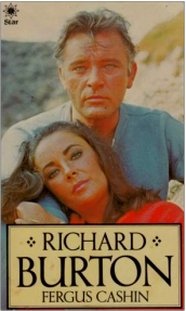
A first edition paperback copy of the 1982 Fergus Cashin biography which was simply entitled, 'Richard Burton'.
Originally published in hardback in 1982, as featured above, this edition was published in the August of 1984 by Star Books, a division of W. H. Allen and Company, based in London.
This edition was printed by Hunt Barnard Limited, Aylesbury, and published with the ISBN 0-352-31311-0.
This paperback copy is illustrated with the same black and white photographs as in the 1982 hardback edition.
In a contemporary review, The Manchester Evening News described this biography with the words;
"A racy account...All of the actor's glorious unpredictability is colourfully illustrated..."
In an extract from the text of the cover notes from this paperback edition, the biography is further described with the paragraph;
"Burton's path to the stars is traced by Fleet Street journalist Fergus Cashin in his own flamboyant style. He visits the scenes of Burton's boyhood; analyses his single-minded pursuit of an acting career; discusses his chequered love life, including his marriages to Elizabeth Taylor - and reminisces on his own drinking days with the notorious couple".
Originally published in hardback in 1982, as featured above, this edition was published in the August of 1984 by Star Books, a division of W. H. Allen and Company, based in London.
This edition was printed by Hunt Barnard Limited, Aylesbury, and published with the ISBN 0-352-31311-0.
This paperback copy is illustrated with the same black and white photographs as in the 1982 hardback edition.
In a contemporary review, The Manchester Evening News described this biography with the words;
"A racy account...All of the actor's glorious unpredictability is colourfully illustrated..."
In an extract from the text of the cover notes from this paperback edition, the biography is further described with the paragraph;
"Burton's path to the stars is traced by Fleet Street journalist Fergus Cashin in his own flamboyant style. He visits the scenes of Burton's boyhood; analyses his single-minded pursuit of an acting career; discusses his chequered love life, including his marriages to Elizabeth Taylor - and reminisces on his own drinking days with the notorious couple".
Paul Ferris, 'A Portrait Of Richard Burton'
Weidenfeld & Nicolson, First Edition, 1984
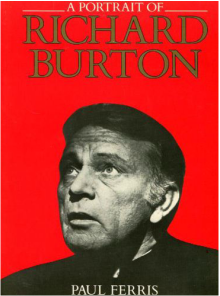
A first edition copy, published in softback, of the large Paul Ferris pictorial biography entitled, 'A Portrait Of Richard Burton'.
This edition was published by Weidenfeld and Nicolson in 1984 and printed by Butler and Tanner, London and was issued with the ISBN 0-297-78565-6.
This edition is illustrated throughout with black and white photographs, covering both he life and career of Richard Burton.
An extract of text, taken from cover notes, reads as follows;
"Richard Burton was that rare phenomenon, a superstar who was also a great actor. He was possessed with two great passions; poetry and beautiful women.
As an actor on the English stage he soared to stardom and was talked of as another Olivier. But Burton's was a restless spirit and the spur of fame and riches took him to Hollywood. In a score of films - often demanding little of him as an actor - he became a superstar. His good looks and grace on the screen made him irresistible to millions of cinema-goers and off-screen his reputation for heavy drinking and wild behaviour kept him in the headlines.
Of the women he loved, Elizabeth Taylor was his match. He wooed her on the set of that most magnificent and vulgar of epics, Cleopatra. Their turbulent marriage and divorce and remarriage and divorce was followed avidly by the world's press. As Paul Ferris writes in this vivid portrait, Richard Burton could find peace only among the people of the Welsh valleys, his true home".
The picture research for this marvellous tribute was undertaken by Tomas Graves and the book itself was designed by Kevin Shenton and Joy FitzSimmons on behalf of Weidenfeld and Nicolson.
This edition also features a well-researched and comprehensive list of Richard Burton's stage and film performances.
This edition was published by Weidenfeld and Nicolson in 1984 and printed by Butler and Tanner, London and was issued with the ISBN 0-297-78565-6.
This edition is illustrated throughout with black and white photographs, covering both he life and career of Richard Burton.
An extract of text, taken from cover notes, reads as follows;
"Richard Burton was that rare phenomenon, a superstar who was also a great actor. He was possessed with two great passions; poetry and beautiful women.
As an actor on the English stage he soared to stardom and was talked of as another Olivier. But Burton's was a restless spirit and the spur of fame and riches took him to Hollywood. In a score of films - often demanding little of him as an actor - he became a superstar. His good looks and grace on the screen made him irresistible to millions of cinema-goers and off-screen his reputation for heavy drinking and wild behaviour kept him in the headlines.
Of the women he loved, Elizabeth Taylor was his match. He wooed her on the set of that most magnificent and vulgar of epics, Cleopatra. Their turbulent marriage and divorce and remarriage and divorce was followed avidly by the world's press. As Paul Ferris writes in this vivid portrait, Richard Burton could find peace only among the people of the Welsh valleys, his true home".
The picture research for this marvellous tribute was undertaken by Tomas Graves and the book itself was designed by Kevin Shenton and Joy FitzSimmons on behalf of Weidenfeld and Nicolson.
This edition also features a well-researched and comprehensive list of Richard Burton's stage and film performances.
Penny Junor, 'Burton - The Man Behind the Myth'
Sidgewick & Jackson, First Edition, 1985
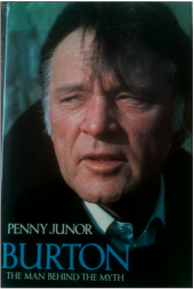
A first edition copy, published in hardback, of journalist Penny Junor's outstanding biography entitled, 'Burton - The Man Behind The Myth'.
This edition was published by Sidgewick and Jackson, Bloomsbury Way, London in 1985 and printed and bound on black cloth boards with gilt lettering by The Garden City Press Limited based in Hertfordshire and issued with the ISBN 0-283-99104-6.
This edition is illustrated with a wide range of black and white photographs, including many rare and unseen images, and is complete with the original dust-jacket which features a stunning portrait of Richard Burton, photographed around 1977.
For the text of the detailed cover notes for this edition, the first in-depth biography to be published after Richard Burton's death, the publishers write;
"Richard Burton became a legend in his own lifetime. His spectacular private life - four times married, twice to Elizabeth Taylor - was often in danger of overshadowing his work. Too frequently his career was compromised by his thirst for the limelight, for fame and for fortune.
Critics once cast him as the natural successor to Olivier, Gielgud and Richardson, giants of the British stage. Instead, he became a tax exile, lured by Hollywood, demeaned by one second-rate film after another, so that, thirty years on, obituary writers spoke of a talent wasted, a gift squandered.
Born Richard Jenkins, to a working miner and his wife in the industrial valleys of South Wales where sons traditionally followed fathers down the pits, he broke the mould. Taking a new name, a new father and setting a new goal, by the age of seventeen he was appearing on the stage in the West End of London. By twenty-seven he was in Hollywood, by thirty-seven he was embroiled with the most sought-after film star in the world, and over the next twenty years he was seldom far from the headlines, or the company of the rich, the famous and the royal.
With so much going for him, what went wrong? Why did he never return to the British theatre and take up the crown that could so easily have been his? why did he become an alcoholic? What made him feel the need to bed every woman he encountered? Why did he squander a talent and a magnetism that had once held audiences enthralled?
In this revealing biography, Penny Junor finds a Richard Burton that for years was hidden by the myths and legends that grew up around him, and discovers that the principal creator of those myths was none other than the actor himself."
In my personal opinion, this well researched and superbly well-written biography is the perfect introduction for anyone interested in film and theatre history or who has recently discovered Richard Burton and wishes to read a true and unbiased account of his life and career.
Penny Junor, is a highly respected, successful and renowned journalist who has worked on such publications as 19 Magazine, The Evening News, The Guardian, Private Eye and The Standard. She is also an acclaimed author and broadcaster and has written several books, including biographies of The Princess of Wales, published in 1982, and two biographies of Charles, Prince Of Wales, published in 1987 and 1998. Other biographies include works on Princes William and Harry, Eric Clapton, John Major and Margaret Thatcher.
She is also well known for television work, in particular programmes relating to travel and consumer issues, presenting the Channel Four programme '4 What It's Worth' and 'The Travel Show' and 'The Afternoon Show' for the B.B.C.
This edition was published by Sidgewick and Jackson, Bloomsbury Way, London in 1985 and printed and bound on black cloth boards with gilt lettering by The Garden City Press Limited based in Hertfordshire and issued with the ISBN 0-283-99104-6.
This edition is illustrated with a wide range of black and white photographs, including many rare and unseen images, and is complete with the original dust-jacket which features a stunning portrait of Richard Burton, photographed around 1977.
For the text of the detailed cover notes for this edition, the first in-depth biography to be published after Richard Burton's death, the publishers write;
"Richard Burton became a legend in his own lifetime. His spectacular private life - four times married, twice to Elizabeth Taylor - was often in danger of overshadowing his work. Too frequently his career was compromised by his thirst for the limelight, for fame and for fortune.
Critics once cast him as the natural successor to Olivier, Gielgud and Richardson, giants of the British stage. Instead, he became a tax exile, lured by Hollywood, demeaned by one second-rate film after another, so that, thirty years on, obituary writers spoke of a talent wasted, a gift squandered.
Born Richard Jenkins, to a working miner and his wife in the industrial valleys of South Wales where sons traditionally followed fathers down the pits, he broke the mould. Taking a new name, a new father and setting a new goal, by the age of seventeen he was appearing on the stage in the West End of London. By twenty-seven he was in Hollywood, by thirty-seven he was embroiled with the most sought-after film star in the world, and over the next twenty years he was seldom far from the headlines, or the company of the rich, the famous and the royal.
With so much going for him, what went wrong? Why did he never return to the British theatre and take up the crown that could so easily have been his? why did he become an alcoholic? What made him feel the need to bed every woman he encountered? Why did he squander a talent and a magnetism that had once held audiences enthralled?
In this revealing biography, Penny Junor finds a Richard Burton that for years was hidden by the myths and legends that grew up around him, and discovers that the principal creator of those myths was none other than the actor himself."
In my personal opinion, this well researched and superbly well-written biography is the perfect introduction for anyone interested in film and theatre history or who has recently discovered Richard Burton and wishes to read a true and unbiased account of his life and career.
Penny Junor, is a highly respected, successful and renowned journalist who has worked on such publications as 19 Magazine, The Evening News, The Guardian, Private Eye and The Standard. She is also an acclaimed author and broadcaster and has written several books, including biographies of The Princess of Wales, published in 1982, and two biographies of Charles, Prince Of Wales, published in 1987 and 1998. Other biographies include works on Princes William and Harry, Eric Clapton, John Major and Margaret Thatcher.
She is also well known for television work, in particular programmes relating to travel and consumer issues, presenting the Channel Four programme '4 What It's Worth' and 'The Travel Show' and 'The Afternoon Show' for the B.B.C.
Melvyn Bragg, 'Rich - The Life Of Richard Burton'
Hodder & Stoughton Limited, Signed First Edition, 1988
A first edition copy, published in hardback, of the marvellous and meticulously researched biography, written by journalist Melvyn Bragg, entitled, 'Rich - The Life Of Richard Burton'.
This edition was published by Hodder And Stoughton Limited in 1988 and was printed by MacKays of Chatham. This edition was issued with the ISBN 0-340-40537-6.
This incredible biography is lavishly illustrated with many rare black and white and colour photographs and is complete with the original dust-jacket.
Exceptionally well-written and researched and with the full co-operation of Richard Burton's widow, Sally, this book is notable as having in print for the first time excerpts taken directly from Richard Burton's previously unpublished diaries and notebooks.
Although heavily edited for this book the extracts still provide a remarkable, and as then completely unknown, insight into Richard Burton's complex character and thoughts.
This first edition copy of 'Rich - The Life Of Richard Burton' is a signed edition which features both the signatures of Melvyn Bragg and Sally Burton.
The detailed and extensive cover notes included in this edition, further explain the history behind the writing of, and provide a synopsis for, this remarkable book;
"A major biography for our times - the story of a man whose full life, despite huge publicity, has until now been largely unknown.
The sensational years of Richard Burton are his marriages to Elizabeth Taylor, his drinking, his womanising, outbidding Onassis for diamonds, outraging society for fun, his spectacular successes on stage - the greatest young star of the Old Vic in the 1950's - and on film - the number one box-office attraction in the world in the 1960's. 'Rich' tells this sensational life as it has never been told before.
But there are many other lives of Richard Burton and what sets this original biography apart is that Melvyn Bragg has discovered and summed up a man hidden until now from all but one or two of his closest friends, and even to them a mystery.
From unpublished letters and memoirs, from new interviews with those who have never before spoken, above all from 350,000 words of Burton's notebooks never before seen, a portrait emerges of a man of multitudes, of vast qualities, immense flaws, wonderful ambitions, crippling melancholy and illnesses, something of a scholar, a fighter and a reckless warrior who lived the life of a legend from his beloved Wales.
From the man who adopted him, Philip Burton, and from his closest family we have new material on the boyhood of this twelfth child of an alcoholic miner. From John Gielgud, Michael Hordern, Lauren Bacall, Warren Mitchell, Robert Hardy, Alec Guinness, John Hurt, John Le Carre, Brook Williams and many others, we have fresh insights. Sally Burton, his widow, has contributed fully to what is a definitive biography, exciting and moving, full of the life which made Burton such a meteor of a man.
Burton writes about his many meetings with, among others, Dylan Thomas, Henry Kissinger, the Windsors, Tito, the Rothschilds, Humphrey Bogart, Paul Newman, Marlon Brando, Rex Harrison, Laurence Olivier, John Gielgud and yet speaks just as warmly of his eternally beloved Welsh friends and Welsh background. His own description of his marriages to Elizabeth Taylor are utterly remarkable in their openness and passion, and speak extraordinarily well for both of them under intense pressure.
'Rich' is a revelation. Melvyn Bragg has absorbed all this into a highly penetrating and vivid biography".
This edition was published by Hodder And Stoughton Limited in 1988 and was printed by MacKays of Chatham. This edition was issued with the ISBN 0-340-40537-6.
This incredible biography is lavishly illustrated with many rare black and white and colour photographs and is complete with the original dust-jacket.
Exceptionally well-written and researched and with the full co-operation of Richard Burton's widow, Sally, this book is notable as having in print for the first time excerpts taken directly from Richard Burton's previously unpublished diaries and notebooks.
Although heavily edited for this book the extracts still provide a remarkable, and as then completely unknown, insight into Richard Burton's complex character and thoughts.
This first edition copy of 'Rich - The Life Of Richard Burton' is a signed edition which features both the signatures of Melvyn Bragg and Sally Burton.
The detailed and extensive cover notes included in this edition, further explain the history behind the writing of, and provide a synopsis for, this remarkable book;
"A major biography for our times - the story of a man whose full life, despite huge publicity, has until now been largely unknown.
The sensational years of Richard Burton are his marriages to Elizabeth Taylor, his drinking, his womanising, outbidding Onassis for diamonds, outraging society for fun, his spectacular successes on stage - the greatest young star of the Old Vic in the 1950's - and on film - the number one box-office attraction in the world in the 1960's. 'Rich' tells this sensational life as it has never been told before.
But there are many other lives of Richard Burton and what sets this original biography apart is that Melvyn Bragg has discovered and summed up a man hidden until now from all but one or two of his closest friends, and even to them a mystery.
From unpublished letters and memoirs, from new interviews with those who have never before spoken, above all from 350,000 words of Burton's notebooks never before seen, a portrait emerges of a man of multitudes, of vast qualities, immense flaws, wonderful ambitions, crippling melancholy and illnesses, something of a scholar, a fighter and a reckless warrior who lived the life of a legend from his beloved Wales.
From the man who adopted him, Philip Burton, and from his closest family we have new material on the boyhood of this twelfth child of an alcoholic miner. From John Gielgud, Michael Hordern, Lauren Bacall, Warren Mitchell, Robert Hardy, Alec Guinness, John Hurt, John Le Carre, Brook Williams and many others, we have fresh insights. Sally Burton, his widow, has contributed fully to what is a definitive biography, exciting and moving, full of the life which made Burton such a meteor of a man.
Burton writes about his many meetings with, among others, Dylan Thomas, Henry Kissinger, the Windsors, Tito, the Rothschilds, Humphrey Bogart, Paul Newman, Marlon Brando, Rex Harrison, Laurence Olivier, John Gielgud and yet speaks just as warmly of his eternally beloved Welsh friends and Welsh background. His own description of his marriages to Elizabeth Taylor are utterly remarkable in their openness and passion, and speak extraordinarily well for both of them under intense pressure.
'Rich' is a revelation. Melvyn Bragg has absorbed all this into a highly penetrating and vivid biography".
Melvyn Bragg, 'Rich - The Life Of Richard Burton'
Hodder & Stoughton Limited, Signed First Edition, 1988
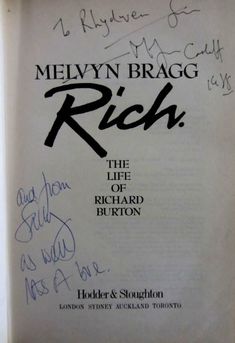
A further first edition copy of Melvyn Bragg's outstanding biography, 'Rich - The Life Of Richard Burton' is held in the Richard Burton Museum collection.
This edition is signed more informally than the previous copy by both Melvyn Bragg and Sally Burton and reads;
'To Rhydwen from Melvyn, Cardiff 1988...
and from Sally as well, lots of love.'
This is a very special copy of this highly important biography as the recipient of this signed edition was Rhydwen Williams.
Born in the Rhondda in 1916, Rhydwen Williams was a Welsh novelist, minister and poet. It was while he was minister of a Baptist chapel in Ynyshir that he began writing poetry, poetry that soon became very popular, mainly due to William's own delivery of his work, having a voice that has been compared to Richard Burton's. This led to invitations from the B.B.C. Welsh Home Service for him to personally broadcast his writing.
This soon led to a position with the B.B.C. in Manchester presenting Welsh language programmes, along with forging a career as a television script writer as well as also concentrating on his poetry and novel writing.
Probably Rhydwen Williams will be best known for his trilogy, 'Cwm Hiraeth' a semi-autobiographical work focusing on the depression of the 1930's in the Rhondda valley.
Rhydwen Williams died, in Merthyr Tydfil, in 1997.
This edition is signed more informally than the previous copy by both Melvyn Bragg and Sally Burton and reads;
'To Rhydwen from Melvyn, Cardiff 1988...
and from Sally as well, lots of love.'
This is a very special copy of this highly important biography as the recipient of this signed edition was Rhydwen Williams.
Born in the Rhondda in 1916, Rhydwen Williams was a Welsh novelist, minister and poet. It was while he was minister of a Baptist chapel in Ynyshir that he began writing poetry, poetry that soon became very popular, mainly due to William's own delivery of his work, having a voice that has been compared to Richard Burton's. This led to invitations from the B.B.C. Welsh Home Service for him to personally broadcast his writing.
This soon led to a position with the B.B.C. in Manchester presenting Welsh language programmes, along with forging a career as a television script writer as well as also concentrating on his poetry and novel writing.
Probably Rhydwen Williams will be best known for his trilogy, 'Cwm Hiraeth' a semi-autobiographical work focusing on the depression of the 1930's in the Rhondda valley.
Rhydwen Williams died, in Merthyr Tydfil, in 1997.
Melvyn Bragg, 'Richard Burton - A Life'
Little, Brown & Company, First Edition, 1989
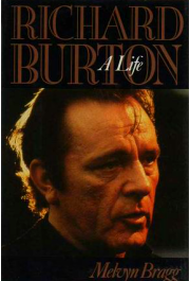
An American first edition, published in hardback, of Melvyn Bragg's marvellous biography, 'Rich - The Life Of Richard Burton', which was re-titled as, 'Richard Burton - A Life', especially for the American market.
This edition was published in the United States by Little, Brown and Company in 1989 and was issued with the ISBN 0-316-10595-3.
The contents of this edition are exactly as in the original British publication although the jacket design differs considerably.
This copy is illustrated with both colour and black and white photographs, as in the British edition, and is complete with the original American dust-jacket.
The cover notes, written for the American market, describe the book with a detailed and fascinating synopsis;
"Few actors in modern times have come close to the fame and glory enjoyed by the late Richard Burton. His formidable talent, his golden voice, his two marriages to Elizabeth Taylor - acted out against a backdrop of spectacular material excess - his drinking, his womanizing, his infectious delight at outraging society, made him the number-one box-office attraction in the world, and guaranteed for years that his every turn would be front-page news.
Now, this legendary public and private life has found the perfect chroniclers - not only the biographer Melvyn Bragg, but also Richard Burton himself, whose personal notebooks are a key part of this extraordinary book.
In addition to the life of the celebrity, there were many other lives of Richard Burton, and what elevates this biography above all others is that Bragg has discovered and summed up a man hidden until now from all but a few close friends, and even to them a mystery. From unpublished letters and memoirs, from interviews with those who have never before spoken, above all from the extraordinary cache of diaries kept by Burton - some 350,000 words never read by anyone before - there emerges a portrait of a man whose inner life was astonishingly different from the public image, but one that is in every way as fascinating and compelling.
What Burton's 'notebooks' in particular reveal (and generous samples are contained in this book) is that Burton was as gifted a writer as he was an actor. Here we see a man of extraordinary brilliance, wit, and learning, who read omnivorously but deeply, and who wrote with remarkable insight on such topics as his craft as an actor, his meetings with such luminaries as Kissinger, Tito, the Windsors, and Dylan Thomas, his daily life, and, with great passion and frankness, his relationship with Elizabeth Taylor.
Here too we see a man of crippling melancholy and illness, of grand ambitions, of a reckless, restless, combative spirit, tortured by self-awareness of his own immense flaws.
This fascinating portrait is filled out with fresh insights from those who knew him best. From the man who adopted him, Philip Burton, and from his closest family, we now have new material on the boyhood of this twelfth child of an alcoholic Welsh miner. From such professional collaborators as John Gielgud, Lauren Bacall, Alec Guinness and John Le Carre and from his widow, Sally Burton, we learn of Burton's generosity, loyalty and good humour, as well as the ugly fits of temper and irresponsibility, often under the influence of liquor.This book is more than a collection of fresh information on the public and private lives of Richard Burton, for, as with the best biographers, Melvyn Bragg has probed the depths of his complex and contradictory subject and brought him to life again. In that sense, his work is a revelation".
This edition was published in the United States by Little, Brown and Company in 1989 and was issued with the ISBN 0-316-10595-3.
The contents of this edition are exactly as in the original British publication although the jacket design differs considerably.
This copy is illustrated with both colour and black and white photographs, as in the British edition, and is complete with the original American dust-jacket.
The cover notes, written for the American market, describe the book with a detailed and fascinating synopsis;
"Few actors in modern times have come close to the fame and glory enjoyed by the late Richard Burton. His formidable talent, his golden voice, his two marriages to Elizabeth Taylor - acted out against a backdrop of spectacular material excess - his drinking, his womanizing, his infectious delight at outraging society, made him the number-one box-office attraction in the world, and guaranteed for years that his every turn would be front-page news.
Now, this legendary public and private life has found the perfect chroniclers - not only the biographer Melvyn Bragg, but also Richard Burton himself, whose personal notebooks are a key part of this extraordinary book.
In addition to the life of the celebrity, there were many other lives of Richard Burton, and what elevates this biography above all others is that Bragg has discovered and summed up a man hidden until now from all but a few close friends, and even to them a mystery. From unpublished letters and memoirs, from interviews with those who have never before spoken, above all from the extraordinary cache of diaries kept by Burton - some 350,000 words never read by anyone before - there emerges a portrait of a man whose inner life was astonishingly different from the public image, but one that is in every way as fascinating and compelling.
What Burton's 'notebooks' in particular reveal (and generous samples are contained in this book) is that Burton was as gifted a writer as he was an actor. Here we see a man of extraordinary brilliance, wit, and learning, who read omnivorously but deeply, and who wrote with remarkable insight on such topics as his craft as an actor, his meetings with such luminaries as Kissinger, Tito, the Windsors, and Dylan Thomas, his daily life, and, with great passion and frankness, his relationship with Elizabeth Taylor.
Here too we see a man of crippling melancholy and illness, of grand ambitions, of a reckless, restless, combative spirit, tortured by self-awareness of his own immense flaws.
This fascinating portrait is filled out with fresh insights from those who knew him best. From the man who adopted him, Philip Burton, and from his closest family, we now have new material on the boyhood of this twelfth child of an alcoholic Welsh miner. From such professional collaborators as John Gielgud, Lauren Bacall, Alec Guinness and John Le Carre and from his widow, Sally Burton, we learn of Burton's generosity, loyalty and good humour, as well as the ugly fits of temper and irresponsibility, often under the influence of liquor.This book is more than a collection of fresh information on the public and private lives of Richard Burton, for, as with the best biographers, Melvyn Bragg has probed the depths of his complex and contradictory subject and brought him to life again. In that sense, his work is a revelation".
Graham Jenkins, 'Richard Burton - My Brother'
Michael Joseph Limited, First Edition, 1988
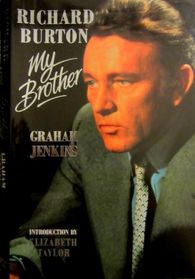
A first edition copy, published in hardback, of Graham Jenkins' intimate biography, simply entitled, 'Richard Burton, My Brother'.
This edition was published in 1988 by Michael Joseph Limited in association with Penguin Books, London, and was printed and bound on black cloth boards with silver gilt lettering by Richard Clay Limited, based in Suffolk and issued with the ISBN D-7181-3010-3.
This edition is illustrated with black and white photographs and is complete with the original dust-jacket.
Taken from the cover notes, the publishers' synopsis of this book reads;
"Richard Burton was one of the most remarkable actors of our age. Singled out by critics as the new Olivier, he lived a swashbuckling life to become a legend in his own lifetime. Yet despite achieving all the accolades of success, Burton ended up a sad and lonely figure, dissipating his genius on wine, women and a succession of second-rate films. What started as a rags-to-riches story ended in tragedy.
Born Richard Jenkins, the son of a Welsh miner, he grew up in a community where sons traditionally followed their fathers down the pits. But Richard was intent on fame and fortune, and, from his schoolboy involvement in amateur dramatics, to informal adoption by his mentor, Philip Burton, he showed a passionate determination to break the mould.
A West End debut at the age of only seventeen was the start of a glittering stage and film career, in which he won widespread acclaim for his portrayal of the classic theatrical roles; Hamlet, Anthony, Coriolanus, Iago and Prince Hal. And in his private life, Burton's four marriages, tempestuous friendships, and scandalous love affairs - including his on-off relationship with Elizabeth Taylor - meant he was seldom out of the news. Why then, did his dream turn sour?
In this intimate biography, Richard's younger brother, Graham Jenkins, tells of Burton's deep-rooted insecurities, and the conflict of values which made him veer from high achievement to humiliating failure, and ultimately, plunge into alcoholism. He conveys Burton's extraordinary charisma, and writes movingly about his love and generosity towards his family.
Written with the support of Elizabeth Taylor, and containing a host of revealing anecdotes about the rich and famous, this is the definitive account of the man behind the many myths - Richard Burton in all his guises."
The following, touching introduction to this book was written by Elizabeth Taylor in New York, in the January of 1988;
" I cannot, nor will I try to, explain here what Richard was, and still is to my life, it would take an entire book to say what I feel. One day I may write that book, but not now, it's still too soon for me.
I am delighted that his family, with Graham as their representative, have put together this book to share with you some of the aspects of what made Richard the most remarkable man I have ever known.
The love he and his family shared was beautiful, rare, volatile, tender and so strong and wild as the Welsh valleys he loved so well.
He lives on in the memory of everyone he touched - his family are his history and his living heritage, and only they can understand what made this man the son and soul of Wales (which is a state of being, not just a nationality). Maybe their reminiscences will bring you closer to understanding this magnificent enigma.
I hope that this book makes you smile and feel happy he was here, even if it was only for a short while."
Contemporary reviews of 'Richard Burton - My Brother', taken from The Sunday Express and The Daily Telegraph respectively, read;
"A warm, affectionate portrait that shows movingly just why Burton was loved so deeply by his friends"
"The stories of wine, women and lusty song acquire a new credibility from this close and apparently unembittered source".
This edition was published in 1988 by Michael Joseph Limited in association with Penguin Books, London, and was printed and bound on black cloth boards with silver gilt lettering by Richard Clay Limited, based in Suffolk and issued with the ISBN D-7181-3010-3.
This edition is illustrated with black and white photographs and is complete with the original dust-jacket.
Taken from the cover notes, the publishers' synopsis of this book reads;
"Richard Burton was one of the most remarkable actors of our age. Singled out by critics as the new Olivier, he lived a swashbuckling life to become a legend in his own lifetime. Yet despite achieving all the accolades of success, Burton ended up a sad and lonely figure, dissipating his genius on wine, women and a succession of second-rate films. What started as a rags-to-riches story ended in tragedy.
Born Richard Jenkins, the son of a Welsh miner, he grew up in a community where sons traditionally followed their fathers down the pits. But Richard was intent on fame and fortune, and, from his schoolboy involvement in amateur dramatics, to informal adoption by his mentor, Philip Burton, he showed a passionate determination to break the mould.
A West End debut at the age of only seventeen was the start of a glittering stage and film career, in which he won widespread acclaim for his portrayal of the classic theatrical roles; Hamlet, Anthony, Coriolanus, Iago and Prince Hal. And in his private life, Burton's four marriages, tempestuous friendships, and scandalous love affairs - including his on-off relationship with Elizabeth Taylor - meant he was seldom out of the news. Why then, did his dream turn sour?
In this intimate biography, Richard's younger brother, Graham Jenkins, tells of Burton's deep-rooted insecurities, and the conflict of values which made him veer from high achievement to humiliating failure, and ultimately, plunge into alcoholism. He conveys Burton's extraordinary charisma, and writes movingly about his love and generosity towards his family.
Written with the support of Elizabeth Taylor, and containing a host of revealing anecdotes about the rich and famous, this is the definitive account of the man behind the many myths - Richard Burton in all his guises."
The following, touching introduction to this book was written by Elizabeth Taylor in New York, in the January of 1988;
" I cannot, nor will I try to, explain here what Richard was, and still is to my life, it would take an entire book to say what I feel. One day I may write that book, but not now, it's still too soon for me.
I am delighted that his family, with Graham as their representative, have put together this book to share with you some of the aspects of what made Richard the most remarkable man I have ever known.
The love he and his family shared was beautiful, rare, volatile, tender and so strong and wild as the Welsh valleys he loved so well.
He lives on in the memory of everyone he touched - his family are his history and his living heritage, and only they can understand what made this man the son and soul of Wales (which is a state of being, not just a nationality). Maybe their reminiscences will bring you closer to understanding this magnificent enigma.
I hope that this book makes you smile and feel happy he was here, even if it was only for a short while."
Contemporary reviews of 'Richard Burton - My Brother', taken from The Sunday Express and The Daily Telegraph respectively, read;
"A warm, affectionate portrait that shows movingly just why Burton was loved so deeply by his friends"
"The stories of wine, women and lusty song acquire a new credibility from this close and apparently unembittered source".
Graham Jenkins, 'Richard Burton - My Brother'
Harper & Row Publishers, Signed First Edition, 1988
An American first edition copy, published in hardback, of the Graham Jenkins biography, 'Richard Burton, My Brother'.
This edition was published by Harper and Row Publishers, New York, in association with Michael Joseph Limited in 1988.
This American, first edition copy has been signed and dedicated to 'Rhydwen fy nghariad' ( Rhydwen with love) by Graham Jenkins, Richard Burton's younger brother and author of this intimate and touching biography.
The actual book was printed and bound in the United Kingdom by Richard Clay Limited, based in Suffolk, and is complete with the original American dust-jacket, which was designed by the One Plus One Studio especially for the American market. This edition was issued with the ISBN 0-06-015952-9 and is illustrated with black and white photographs, exactly as in the original British publication. The cover notes, however, differ considerably for this American first edition and read;
"Called "a triumph of raw but tender honesty" by the critics, here is the completely candid and intimate portrait of Richard Burton by the brother who knew him best. An international film star, brilliant on stages on both sides of the Atlantic and singled out as the new Olivier, Burton was one of the most remarkable actors of our age. But despite the accolades of success and his own dreams of becoming the undisputed leading man of the English theatre, Burton dissipated his genius on alcohol, women, conspicuous wealth and a succession of second-rate films.
In this intimate biography of his older brother (who was born Richard Walter Jenkins but took the stage name of an early mentor), Graham Jenkins tells the complete story of Burton's enormously successful, tempestuous and ultimately tragic life. As only someone as close as a brother could do, Jenkins reveals the deep-seated insecurities and the conflicting values that made 'Rich' veer from high achievement to alcoholism and failure.
Filled with revealing anecdotes plus many previously unpublished photographs from family collections, this is the definitive account of the individual behind the many guises - Richard Burton the man."
This edition was published by Harper and Row Publishers, New York, in association with Michael Joseph Limited in 1988.
This American, first edition copy has been signed and dedicated to 'Rhydwen fy nghariad' ( Rhydwen with love) by Graham Jenkins, Richard Burton's younger brother and author of this intimate and touching biography.
The actual book was printed and bound in the United Kingdom by Richard Clay Limited, based in Suffolk, and is complete with the original American dust-jacket, which was designed by the One Plus One Studio especially for the American market. This edition was issued with the ISBN 0-06-015952-9 and is illustrated with black and white photographs, exactly as in the original British publication. The cover notes, however, differ considerably for this American first edition and read;
"Called "a triumph of raw but tender honesty" by the critics, here is the completely candid and intimate portrait of Richard Burton by the brother who knew him best. An international film star, brilliant on stages on both sides of the Atlantic and singled out as the new Olivier, Burton was one of the most remarkable actors of our age. But despite the accolades of success and his own dreams of becoming the undisputed leading man of the English theatre, Burton dissipated his genius on alcohol, women, conspicuous wealth and a succession of second-rate films.
In this intimate biography of his older brother (who was born Richard Walter Jenkins but took the stage name of an early mentor), Graham Jenkins tells the complete story of Burton's enormously successful, tempestuous and ultimately tragic life. As only someone as close as a brother could do, Jenkins reveals the deep-seated insecurities and the conflicting values that made 'Rich' veer from high achievement to alcoholism and failure.
Filled with revealing anecdotes plus many previously unpublished photographs from family collections, this is the definitive account of the individual behind the many guises - Richard Burton the man."
Richard Burton's 'A Christmas Story'
Hodder & Stoughton, First Edition, 1989
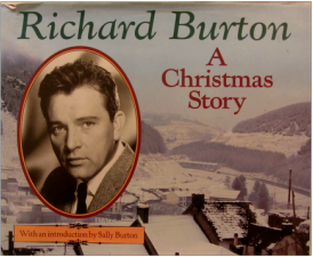
A first edition copy, published in hardback, of the 1989 reprint of Richard Burton's delightful 1964 semi-autobiographical book, 'A Christmas Story'.
This edition was published by Hodder and Stoughton based in Sevenoaks, Kent and printed by the St. Edmundsbury Press Limited, based in Suffolk, and issued with the ISBN 0-340-51246-6.
Included in this new edition is the following, extremely moving, introduction written by Sally Burton which places Richard Burton's short Christmas story within the context of the Jenkins family and the village of Pontrhydyfen itself;
"To imagine that Richard Burton had an impoverished childhood is to fall too readily into a foolish trap. The facts remain the same: born November 10th,1925 in Pontrhydyfen, the twelfth son of thirteen children, two of whom died in infancy, father a sometime miner who liked a drink or two, a mother who died five days after giving birth to her thirteenth child, another boy, taken in by an elder sister, his beloved Cis, and finally 'adopted' by Philip Burton. It is the interpretation that changes. from a distance of over fifty years it is all too easy to place those facts against a backdrop of the effects of the Depression, pit villages with grey terraced houses, high unemployment with whatever jobs there were available being backbreaking work down the mines, where fearsome accidents were always a possibility, women working themselves to the bone to feed their families and keep the house clean, the diseases derived from an inadequate diet and a lifetime hammering at the coalface, and come to the conclusion that the Jenkins family must have been abject and poverty stricken. Wrong.
Lacking in funds they might have been, with a father who was at best imprudent, stretched to the limit they most certainly were with a vast growing family of demanding sturdy children to take care of and feed. But there were other things going on. gripped in adversity as they were, there was always a strong emphasis on the family unit, of looking after your own, of education, getting on in life and, if you could not move on yourself, making sure those who followed you could, and at least doing what you have to do to the best of your ability. It was a case of 'meet your lot head on and don't give in'. those were feelings which were true not only for the Jenkins family but were held up as mainstays throughout the valleys. With those values firmly in position it was a good place to start.
But let us not get too carried away with the romance of it all and start to imagine it with a Hollywood sound track. in 1921 there was a miner's strike which lasted three months and in 1926 a strike which was to last a long and bitter six months. From the mid-twenties through until the mid-thirties the effects of the Depression bit with unrelenting hardness and without discrimination. English towns did their bit by adopting Welsh pit villages, collecting much needed money to provide soup kitchens in the schools and sending old clothes which were distributed amongst the most needy. the slow drifts of migration, to London and the industrial Midlands, began in the vain hope of finding jobs and an alternative living. Hardship was rife in the valleys.
As for the Jenkins family, they kept themselves together and much credit for that must go to their mother, Edith, who was thought by many to be an absolute angel. She was one of those strong Welsh women imbued with natural pride and dignity, determination and a vast range of practical talents. There were a lot of them and there still are today. To this day, her seventh child, David Jenkins, speaks of her extraordinary ability in keeping family and home together against all odds. She worked unceasingly. He talks of the massive meals she prepared for them all, sitting her huge family around the kitchen table - it is the baking of her pies made from the wimberries which grew wild in the nearby hills that he remembers best. It is a marvel how she, with the help of her eldest daughter Cis, did it. Quite obviously the work load was enormous but there was never any lowering of standards; the house always shone, there was always enough to eat, the children were well turned out and the washing never ceased. Even with that burden apparently she found time for all her children, each of them different, each of them talented in their varying ways.
Their father, Dic Bach, had a bit of the devil in him, he was a character, he told stories and he made them laugh. The children knew from an early age that he was not always going to be there for them, that he was unreliable, but he was their father and they loved him all the same. He was a bit different from the rest, he read books, he liked to play with long words and he had opinions he was happy to expound. Their mother was their rock, she was beautiful, she was their inspiration and was the one who would always be there to come home to. Five days after giving birth to her thirteenth child she died.
The loss of their mother devastated the family and Dic Bach who had worshipped her would never be the same. They say he never looked at another woman. the impact of her death upon the family was enormous. For a start there were all those children to be looked after - Tom and Cis were married - but at home there was Ifor who would take control, Will, Verdun, David, Hilda, Edie, Cassie, Rich, and the new baby. But first things first. It was decided that Tom would take Graham, the baby, and Cis would take Rich aged two, a hefty and lively little boy who would cry whenever his mother left him. It was a decision made without hesitation for Cis, though it was probably very difficult for her husband, Elfed, to accept as he had been told by her that she did not want to have children of her own. He hoped she would change her mind, which in time she did, but then she felt she had had quite enough of children at home where she had helped her mother take care of the regularly growing family. Cis had despaired for her mother as she watched her wear herself out and at times she actively disliked her father for it. Babies, babies and more babies. Work, work and more work. Cis had never really received a proper education because of relentless demands of home and children.
So Rich was taken from the secure world of Pontrhydyfen to the unknown territory of Caradoc Street, Taibach, a few miles down the road. Now only a few minutes in a car but then, if you happened to be two and spoke only in Welsh, the distance was monumental. Cis and Rich travelled that distance time and time again. Sometimes quite unknown to Elfed. Edith had handed down her housekeeping skills to Cis who now used them in her own house and at the family home in Pontrhydyfen. To and fro they went, with an old suitcase full of washing, collecting and delivering. One time the catch broke and the much used suitcase burst open in front of a bus queue. Cis and Rich had to get down on their knees and struggle to gather up the washing and force the case shut again - oh the shame of it. Because Elfed was concerned that Cis was taking on too much in attempting to run two houses, the frequency of the journeys had to be kept a secret from him. from an early age Cis and Rich were locked in a conspiracy of secrecy and total adoration.
Though Cis had worried for her mother having all those babies, from the moment he was born there was no doubt that she was utterly devoted to Rich whom she thought the most beautiful baby she had ever seen. Brother Ifor was more dismissive of the latest addition to the family but soon even he was captivated by this engaging child who seemed to have something undefinable but very powerful about him. If the other children spotted Ifor coming home from work with a sullen expression and clearly in a bad mood which they were going to get the sharp end of, Rich would instantly be popped up on top of the kitchen table and told to dance. In later life he had no sense of rhythm at all so it is not hard to understand why Ifor would burst out in uncontrollable laughter at the hilarious sight of those little fat legs attempting a Charleston.
In Taibach Rich quickly picked up English and it seems he he managed with his reading just as well. He said he could not remember learning to read, that he just seemed to be able to do it. There was no struggling with the alphabet or tracing a finger along lines of indecipherable words for him. The next door neighbour in Caradoc Street used to pass on her weekly magazine to Cis and while she was busy doing the ironing, of which there was always a mountain, Rich would entertain her by reading the stories. So it would seem that the great Burton voice got its first airing reading romantic fiction from women's magazines to the accompaniment of an iron swishing back and forth, back and forth.
Other talents also started to emerge. Rich loved to imitate. The local preachers were some of his first victims and so was Elfed. Rich could do his walk and made quite a fuss about having a coat and a cap just like him. Cis even had to find a junior version of Elfed's pipe so that the budding star could do the full affectionate portrayal.
He had his friends. there was Trevor from next door and there was his cousin Dilwyn, and together the three fearlessly roamed Taibach and the surrounding area. Nearby they had the sea where they could swim - with the passage of time Rich became convinced that they did it in all weathers, endowing the Gulf Stream and the intrepid hardiness of children with all kinds of extraordinary powers. Brother Verdun came up trumps by building the best boneshaker ever. it impressed the hell out of the other boys and was immediately put into service up and down Caradoc Street. There were all kinds of aunts and uncles and, if they were not all strictly related, they were given the honorary title which came to the same thing. With this huge network of admirers Rich could come and go as he pleased, always assured of a welcome. front doors were left open and there were usually a couple of pennies here, and a couple more there, to be earned or just be given out of pure generosity as Rich developed his certain way with people.
Over the years Rich continued to shuttle between Taibach and Pontrhydyfen. While the house in Caradoc Street was his home, he spent weekends with his other brothers and sisters in the house he had been born in at 2 Dan-y.Bont, Pontrhydyfen. There he would share beds and listen late at night to his sisters giggling while telling each other of their romantic outings, particularly one who had met the man of her dreams who lived only streets away and looked 'just like Robert Taylor'.
Home life was good, school life was good, though Rich began to strain at the leash a bit as an adolescent. He was a strong and very bright boy who was finding the confines of Taibach frustrating, though at that time he could not define why and certainly did not know how to express his doubts other than by being ill-tempered and difficult. No more so than most teenagers. It was thought he needed the discipline of a job, and anyway he should begin to pay his way, so he was yanked out of school and given the all-consuming task of working in the haberdashery department of the local co-op. It was not an easy relationship.
Fortunately Rich was rescued, returned to school, and put on a surer route. He was able to follow that direction and see wherever it would take him because he had those strong roots forged in his Welsh childhood with Cis. It took him into an uncharted world which he conquered with tremendous success, inspiring enormous pride amongst his own family, and the greater family of Wales. he fulfilled his own and their dreams. Rich had a mighty range of talents, many ambitions, and one of them was to write. A short piece, 'A Christmas Story', was first published in 1964. During that year he played Hamlet in New York, and made the films 'Becket' in London and 'Night Of The Iguana' in Mexico, but for this short story he returned to his childhood to pay tribute to Cis and Wales.
If the theory that all men are really little boys at heart is true, and to those that knew him Rich was more than most men, then it follows that he was even more of a little boy. There were certainly times when he was mischievous - he got himself into the odd scrape or two, the effects of which resounded further than Port Talbot - but he also had a sense of adventure and a desire to try anything for size. There was always a feeling of what stunt could he invent next, what prank could he get up to. He saw the world through his own eyes, and he was a joy to be around. After his death in 1984 I was asked if I regretted not having a child. My response was that I had one, a little boy, he was fifty-eight years old.
This new edition of Richard Burton's 'A Christmas Story' is illustrated throughout with black and white photographs, many from the personal collection of Hilda Owen, Richard Burton's sister, and with photographs of Pontrhydyfen, Taibach and the surrounding areas taken in the 1920's and 1930's which were obtained from the National Library of Wales, the Welsh Miners Museum and the Port Talbot Historical Society, images which perfectly compliment this delightful new imprint of the original book.
This copy of the 1989 reprint of Richard Burton's 'A Christmas Story' is complete with the newly designed dust-jacket.
This edition was published by Hodder and Stoughton based in Sevenoaks, Kent and printed by the St. Edmundsbury Press Limited, based in Suffolk, and issued with the ISBN 0-340-51246-6.
Included in this new edition is the following, extremely moving, introduction written by Sally Burton which places Richard Burton's short Christmas story within the context of the Jenkins family and the village of Pontrhydyfen itself;
"To imagine that Richard Burton had an impoverished childhood is to fall too readily into a foolish trap. The facts remain the same: born November 10th,1925 in Pontrhydyfen, the twelfth son of thirteen children, two of whom died in infancy, father a sometime miner who liked a drink or two, a mother who died five days after giving birth to her thirteenth child, another boy, taken in by an elder sister, his beloved Cis, and finally 'adopted' by Philip Burton. It is the interpretation that changes. from a distance of over fifty years it is all too easy to place those facts against a backdrop of the effects of the Depression, pit villages with grey terraced houses, high unemployment with whatever jobs there were available being backbreaking work down the mines, where fearsome accidents were always a possibility, women working themselves to the bone to feed their families and keep the house clean, the diseases derived from an inadequate diet and a lifetime hammering at the coalface, and come to the conclusion that the Jenkins family must have been abject and poverty stricken. Wrong.
Lacking in funds they might have been, with a father who was at best imprudent, stretched to the limit they most certainly were with a vast growing family of demanding sturdy children to take care of and feed. But there were other things going on. gripped in adversity as they were, there was always a strong emphasis on the family unit, of looking after your own, of education, getting on in life and, if you could not move on yourself, making sure those who followed you could, and at least doing what you have to do to the best of your ability. It was a case of 'meet your lot head on and don't give in'. those were feelings which were true not only for the Jenkins family but were held up as mainstays throughout the valleys. With those values firmly in position it was a good place to start.
But let us not get too carried away with the romance of it all and start to imagine it with a Hollywood sound track. in 1921 there was a miner's strike which lasted three months and in 1926 a strike which was to last a long and bitter six months. From the mid-twenties through until the mid-thirties the effects of the Depression bit with unrelenting hardness and without discrimination. English towns did their bit by adopting Welsh pit villages, collecting much needed money to provide soup kitchens in the schools and sending old clothes which were distributed amongst the most needy. the slow drifts of migration, to London and the industrial Midlands, began in the vain hope of finding jobs and an alternative living. Hardship was rife in the valleys.
As for the Jenkins family, they kept themselves together and much credit for that must go to their mother, Edith, who was thought by many to be an absolute angel. She was one of those strong Welsh women imbued with natural pride and dignity, determination and a vast range of practical talents. There were a lot of them and there still are today. To this day, her seventh child, David Jenkins, speaks of her extraordinary ability in keeping family and home together against all odds. She worked unceasingly. He talks of the massive meals she prepared for them all, sitting her huge family around the kitchen table - it is the baking of her pies made from the wimberries which grew wild in the nearby hills that he remembers best. It is a marvel how she, with the help of her eldest daughter Cis, did it. Quite obviously the work load was enormous but there was never any lowering of standards; the house always shone, there was always enough to eat, the children were well turned out and the washing never ceased. Even with that burden apparently she found time for all her children, each of them different, each of them talented in their varying ways.
Their father, Dic Bach, had a bit of the devil in him, he was a character, he told stories and he made them laugh. The children knew from an early age that he was not always going to be there for them, that he was unreliable, but he was their father and they loved him all the same. He was a bit different from the rest, he read books, he liked to play with long words and he had opinions he was happy to expound. Their mother was their rock, she was beautiful, she was their inspiration and was the one who would always be there to come home to. Five days after giving birth to her thirteenth child she died.
The loss of their mother devastated the family and Dic Bach who had worshipped her would never be the same. They say he never looked at another woman. the impact of her death upon the family was enormous. For a start there were all those children to be looked after - Tom and Cis were married - but at home there was Ifor who would take control, Will, Verdun, David, Hilda, Edie, Cassie, Rich, and the new baby. But first things first. It was decided that Tom would take Graham, the baby, and Cis would take Rich aged two, a hefty and lively little boy who would cry whenever his mother left him. It was a decision made without hesitation for Cis, though it was probably very difficult for her husband, Elfed, to accept as he had been told by her that she did not want to have children of her own. He hoped she would change her mind, which in time she did, but then she felt she had had quite enough of children at home where she had helped her mother take care of the regularly growing family. Cis had despaired for her mother as she watched her wear herself out and at times she actively disliked her father for it. Babies, babies and more babies. Work, work and more work. Cis had never really received a proper education because of relentless demands of home and children.
So Rich was taken from the secure world of Pontrhydyfen to the unknown territory of Caradoc Street, Taibach, a few miles down the road. Now only a few minutes in a car but then, if you happened to be two and spoke only in Welsh, the distance was monumental. Cis and Rich travelled that distance time and time again. Sometimes quite unknown to Elfed. Edith had handed down her housekeeping skills to Cis who now used them in her own house and at the family home in Pontrhydyfen. To and fro they went, with an old suitcase full of washing, collecting and delivering. One time the catch broke and the much used suitcase burst open in front of a bus queue. Cis and Rich had to get down on their knees and struggle to gather up the washing and force the case shut again - oh the shame of it. Because Elfed was concerned that Cis was taking on too much in attempting to run two houses, the frequency of the journeys had to be kept a secret from him. from an early age Cis and Rich were locked in a conspiracy of secrecy and total adoration.
Though Cis had worried for her mother having all those babies, from the moment he was born there was no doubt that she was utterly devoted to Rich whom she thought the most beautiful baby she had ever seen. Brother Ifor was more dismissive of the latest addition to the family but soon even he was captivated by this engaging child who seemed to have something undefinable but very powerful about him. If the other children spotted Ifor coming home from work with a sullen expression and clearly in a bad mood which they were going to get the sharp end of, Rich would instantly be popped up on top of the kitchen table and told to dance. In later life he had no sense of rhythm at all so it is not hard to understand why Ifor would burst out in uncontrollable laughter at the hilarious sight of those little fat legs attempting a Charleston.
In Taibach Rich quickly picked up English and it seems he he managed with his reading just as well. He said he could not remember learning to read, that he just seemed to be able to do it. There was no struggling with the alphabet or tracing a finger along lines of indecipherable words for him. The next door neighbour in Caradoc Street used to pass on her weekly magazine to Cis and while she was busy doing the ironing, of which there was always a mountain, Rich would entertain her by reading the stories. So it would seem that the great Burton voice got its first airing reading romantic fiction from women's magazines to the accompaniment of an iron swishing back and forth, back and forth.
Other talents also started to emerge. Rich loved to imitate. The local preachers were some of his first victims and so was Elfed. Rich could do his walk and made quite a fuss about having a coat and a cap just like him. Cis even had to find a junior version of Elfed's pipe so that the budding star could do the full affectionate portrayal.
He had his friends. there was Trevor from next door and there was his cousin Dilwyn, and together the three fearlessly roamed Taibach and the surrounding area. Nearby they had the sea where they could swim - with the passage of time Rich became convinced that they did it in all weathers, endowing the Gulf Stream and the intrepid hardiness of children with all kinds of extraordinary powers. Brother Verdun came up trumps by building the best boneshaker ever. it impressed the hell out of the other boys and was immediately put into service up and down Caradoc Street. There were all kinds of aunts and uncles and, if they were not all strictly related, they were given the honorary title which came to the same thing. With this huge network of admirers Rich could come and go as he pleased, always assured of a welcome. front doors were left open and there were usually a couple of pennies here, and a couple more there, to be earned or just be given out of pure generosity as Rich developed his certain way with people.
Over the years Rich continued to shuttle between Taibach and Pontrhydyfen. While the house in Caradoc Street was his home, he spent weekends with his other brothers and sisters in the house he had been born in at 2 Dan-y.Bont, Pontrhydyfen. There he would share beds and listen late at night to his sisters giggling while telling each other of their romantic outings, particularly one who had met the man of her dreams who lived only streets away and looked 'just like Robert Taylor'.
Home life was good, school life was good, though Rich began to strain at the leash a bit as an adolescent. He was a strong and very bright boy who was finding the confines of Taibach frustrating, though at that time he could not define why and certainly did not know how to express his doubts other than by being ill-tempered and difficult. No more so than most teenagers. It was thought he needed the discipline of a job, and anyway he should begin to pay his way, so he was yanked out of school and given the all-consuming task of working in the haberdashery department of the local co-op. It was not an easy relationship.
Fortunately Rich was rescued, returned to school, and put on a surer route. He was able to follow that direction and see wherever it would take him because he had those strong roots forged in his Welsh childhood with Cis. It took him into an uncharted world which he conquered with tremendous success, inspiring enormous pride amongst his own family, and the greater family of Wales. he fulfilled his own and their dreams. Rich had a mighty range of talents, many ambitions, and one of them was to write. A short piece, 'A Christmas Story', was first published in 1964. During that year he played Hamlet in New York, and made the films 'Becket' in London and 'Night Of The Iguana' in Mexico, but for this short story he returned to his childhood to pay tribute to Cis and Wales.
If the theory that all men are really little boys at heart is true, and to those that knew him Rich was more than most men, then it follows that he was even more of a little boy. There were certainly times when he was mischievous - he got himself into the odd scrape or two, the effects of which resounded further than Port Talbot - but he also had a sense of adventure and a desire to try anything for size. There was always a feeling of what stunt could he invent next, what prank could he get up to. He saw the world through his own eyes, and he was a joy to be around. After his death in 1984 I was asked if I regretted not having a child. My response was that I had one, a little boy, he was fifty-eight years old.
This new edition of Richard Burton's 'A Christmas Story' is illustrated throughout with black and white photographs, many from the personal collection of Hilda Owen, Richard Burton's sister, and with photographs of Pontrhydyfen, Taibach and the surrounding areas taken in the 1920's and 1930's which were obtained from the National Library of Wales, the Welsh Miners Museum and the Port Talbot Historical Society, images which perfectly compliment this delightful new imprint of the original book.
This copy of the 1989 reprint of Richard Burton's 'A Christmas Story' is complete with the newly designed dust-jacket.
Peter Stead, 'Richard Burton - So Much, So Little'
Seren Books, First Edition, 1991
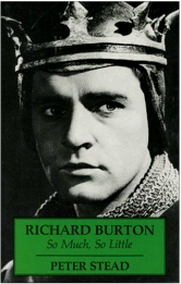
A first edition hardback copy of historian Peter Stead's hard-hitting and critical biography entitled, 'Richard Burton - So Much, So Little'.
This copy was published and printed in 1991 by Seren Books, Poetry Wales Press Limited based in Bridgend, Mid Glamorgan, Wales and was printed and bound on grey cloth boards with silver gilt lettering by WBC Limited, Bridgend, Mid Glamorgan and was issued with the ISBN 1-85411-040-3.
This edition features a stunning cover portrait of Richard Burton as Prince Hal from Henry IV Part I, as captured by theatrical photographer, Angus McBean.
The synopsis of this biography, taken from the cover notes, reads;
"The story of Richard Burton's life is well known; from son of a Welsh miner and ward of a local teacher to international superstar. He became as famous for being Richard Burton and husband of Elizabeth Taylor as for the extraordinary acting abilities which made his name.
A globe-trotter with a Swiss home, Burton never forgot his Welsh origins and identity. I this new study, cultural historian Peter Stead shows how Burton's Welshness shaped his character and his career. He reviews Burton's stage and film careers, showing how bad luck and his own character left him isolated in the face of dramatic and cinematic change. Stead also describes the phenomenon of the Burton - Taylor marriages, and how Burton was transformed from actor into jet-setter.
'Richard Burton; So Much, So Little' places him fully in his English, American and Welsh contexts, to produce the most interesting book on Burton yet published".
This edition is illustrated with black and white photographs and is complete with the original dust-jacket.
Peter Stead, historian, author and broadcaster, was a senior lecturer of history at the University College Of Swansea, South Wales and is also the author of 'Films and the Working Class' and 'Acting Wales; Stars of Stage and Screen' published in 1990 and 2002 respectively.
This copy was published and printed in 1991 by Seren Books, Poetry Wales Press Limited based in Bridgend, Mid Glamorgan, Wales and was printed and bound on grey cloth boards with silver gilt lettering by WBC Limited, Bridgend, Mid Glamorgan and was issued with the ISBN 1-85411-040-3.
This edition features a stunning cover portrait of Richard Burton as Prince Hal from Henry IV Part I, as captured by theatrical photographer, Angus McBean.
The synopsis of this biography, taken from the cover notes, reads;
"The story of Richard Burton's life is well known; from son of a Welsh miner and ward of a local teacher to international superstar. He became as famous for being Richard Burton and husband of Elizabeth Taylor as for the extraordinary acting abilities which made his name.
A globe-trotter with a Swiss home, Burton never forgot his Welsh origins and identity. I this new study, cultural historian Peter Stead shows how Burton's Welshness shaped his character and his career. He reviews Burton's stage and film careers, showing how bad luck and his own character left him isolated in the face of dramatic and cinematic change. Stead also describes the phenomenon of the Burton - Taylor marriages, and how Burton was transformed from actor into jet-setter.
'Richard Burton; So Much, So Little' places him fully in his English, American and Welsh contexts, to produce the most interesting book on Burton yet published".
This edition is illustrated with black and white photographs and is complete with the original dust-jacket.
Peter Stead, historian, author and broadcaster, was a senior lecturer of history at the University College Of Swansea, South Wales and is also the author of 'Films and the Working Class' and 'Acting Wales; Stars of Stage and Screen' published in 1990 and 2002 respectively.
Philip Burton, 'Richard & Philip: The Burtons'
Peter Owen Publishers, First Edition, 1992
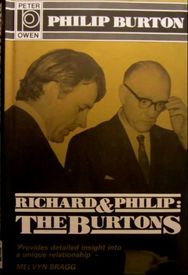
A first edition copy, published in hardback, of Philip Burton's second autobiography which he titled, 'Richard and Philip: The Burtons'.
This hardback edition was published by Peter Owen Publishers, Kenway Road, London in 1992 and printed and bound on brown cloth boards with gilt lettering by Billings of Worcester and issued with the ISBN 0-7206-0855-4.
This edition includes a foreword written by Elizabeth Taylor, in which she beautifully and tenderly writes;
"Without Philip Burton there never would have been a Richard Burton. That great rolling voice that cracked like wild Atlantic waves would never have been heard outside the valley. Those green cat-eyes would have broken probably only a few hundred hearts instead of millions. The myriad of songs in his brain would never have found his outlet in poetry. his vast love and profound knowledge of poetry would never have been heard because they never would have been channeled.
A teacher named Philip Burton saw in a wild young man called Richie Jenkins that 'divine spark of fire' that could open the kingdom of knowledge to him for the rest of his life and change him forever.
This story is Philip's, the story of an adoptive father's great love and devotion, and of a great teacher and how he helped one of the most fascinating, brilliant and magnificent men of any age.
I for one thank you, Phil, because if it hadn't been for you I probably would have never met Richard - I thank you with all my life for that."
Sadly, no illustrations appear in this otherwise splendid memoir by Philip Burton, aside from the end papers, which feature a black and white photograph of Philip and Richard Burton together with Elizabeth Taylor captured during the rehearsals for the Broadway run of 'Hamlet' in 1964.
This copy is complete with the original dust-jacket.
Taken from the cover notes, the publishers' synopsis of this biography reads;
"In the early 1940's Philip Burton held the post of Senior Master at the Port Talbot Secondary School in South Wales. At the same time he was building a reputation as a playwright, his work having been produced for radio by the B.B.C. Among his pupils was a boy of exceptional promise, one of thirteen children of a mining family. the boy's home life was unsettled and it was at his own instigation that Philip Burton reluctantly agreed to adopt him and raise him as his son. Within ten years the young Richard Jenkins was transformed into the internationally famous actor Richard Burton, had astounded the critics as Henry V at Stratford-upon-Avon and become a film star in Hollywood.
In this moving memoir Philip Burton tells of his forty-year relationship with his adopted son, which ended only with Richard's death in 1984. He recalls how he trained him as an actor, helping him lose his Welsh accent; how Richard's affair with Elizabeth Taylor and his divorce from his first wife Sybil led to a two-year rift between them; and how Richard nonetheless continued to turn to him for advice and approval throughout his turbulent career. He also writes of his own eventful life, which took him from a Welsh mining community to success as a director on Broadway.
Richard Burton was a man whose faults were on the same large scale as his virtues, and Philip Burton knew him perhaps better than anyone. This is a book he is uniquely qualified to write, and which bears witness to the achievements of two remarkable men."
In his own preface for this edition, Philip Burton writes;
"This is not a biography of Richard Burton. It is a collection of memories of an association that lasted over forty years. I shall not attempt even to sketch his career, but shall deal only with those parts of it with which I had some personal connection. And I shall say something about my own life and career too.
I had been urged by several people to tell the story of how the Welsh teenager Richard Jenkins became the actor of world renown Richard Burton, but I hesitated to do so because I feared the result would sound as if I were blowing my own trumpet. I have now been made to realise that I should tell the story because of its inherent interest and because it will reveal a Richard that those who have written about him did not know. I owe it to Richard and to those who loved and admired him.
My memory has been helped by small diaries I have kept since 1950, five years to a page, and by some of the material from my book, 'Early Doors'.
This hardback edition was published by Peter Owen Publishers, Kenway Road, London in 1992 and printed and bound on brown cloth boards with gilt lettering by Billings of Worcester and issued with the ISBN 0-7206-0855-4.
This edition includes a foreword written by Elizabeth Taylor, in which she beautifully and tenderly writes;
"Without Philip Burton there never would have been a Richard Burton. That great rolling voice that cracked like wild Atlantic waves would never have been heard outside the valley. Those green cat-eyes would have broken probably only a few hundred hearts instead of millions. The myriad of songs in his brain would never have found his outlet in poetry. his vast love and profound knowledge of poetry would never have been heard because they never would have been channeled.
A teacher named Philip Burton saw in a wild young man called Richie Jenkins that 'divine spark of fire' that could open the kingdom of knowledge to him for the rest of his life and change him forever.
This story is Philip's, the story of an adoptive father's great love and devotion, and of a great teacher and how he helped one of the most fascinating, brilliant and magnificent men of any age.
I for one thank you, Phil, because if it hadn't been for you I probably would have never met Richard - I thank you with all my life for that."
Sadly, no illustrations appear in this otherwise splendid memoir by Philip Burton, aside from the end papers, which feature a black and white photograph of Philip and Richard Burton together with Elizabeth Taylor captured during the rehearsals for the Broadway run of 'Hamlet' in 1964.
This copy is complete with the original dust-jacket.
Taken from the cover notes, the publishers' synopsis of this biography reads;
"In the early 1940's Philip Burton held the post of Senior Master at the Port Talbot Secondary School in South Wales. At the same time he was building a reputation as a playwright, his work having been produced for radio by the B.B.C. Among his pupils was a boy of exceptional promise, one of thirteen children of a mining family. the boy's home life was unsettled and it was at his own instigation that Philip Burton reluctantly agreed to adopt him and raise him as his son. Within ten years the young Richard Jenkins was transformed into the internationally famous actor Richard Burton, had astounded the critics as Henry V at Stratford-upon-Avon and become a film star in Hollywood.
In this moving memoir Philip Burton tells of his forty-year relationship with his adopted son, which ended only with Richard's death in 1984. He recalls how he trained him as an actor, helping him lose his Welsh accent; how Richard's affair with Elizabeth Taylor and his divorce from his first wife Sybil led to a two-year rift between them; and how Richard nonetheless continued to turn to him for advice and approval throughout his turbulent career. He also writes of his own eventful life, which took him from a Welsh mining community to success as a director on Broadway.
Richard Burton was a man whose faults were on the same large scale as his virtues, and Philip Burton knew him perhaps better than anyone. This is a book he is uniquely qualified to write, and which bears witness to the achievements of two remarkable men."
In his own preface for this edition, Philip Burton writes;
"This is not a biography of Richard Burton. It is a collection of memories of an association that lasted over forty years. I shall not attempt even to sketch his career, but shall deal only with those parts of it with which I had some personal connection. And I shall say something about my own life and career too.
I had been urged by several people to tell the story of how the Welsh teenager Richard Jenkins became the actor of world renown Richard Burton, but I hesitated to do so because I feared the result would sound as if I were blowing my own trumpet. I have now been made to realise that I should tell the story because of its inherent interest and because it will reveal a Richard that those who have written about him did not know. I owe it to Richard and to those who loved and admired him.
My memory has been helped by small diaries I have kept since 1950, five years to a page, and by some of the material from my book, 'Early Doors'.
Tyrone Steverson, 'Richard Burton - A Bio-Bibliography'
The Greenwood Press, First Edition, 1992
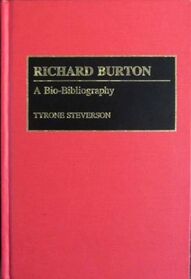
A fascinating and excellently researched book which has proved invaluable in the creation of this website is this first edition copy of the Tyrone Steverson book, 'Richard Burton - A Bio-Biography'.
Divided into eight chapters, each focusing on a different aspect of Richard Burton's career, namely; a detailed biography, a chronology of his life, stage performances, film roles, television appearances, radio performances, a discography and a selected list of biographies.
The chapters relating to his stage and film roles are divided into several sub-sections focusing on production credits, the main cast, synopsis, comments and reviews.
The author's preface for this edition reads;
"In the years since his death, many have wondered: Was Richard Burton an extraordinary talent worthy of such great acclaim and supercelebrity, or was he just an ordinary talent who made the most of extraordinary circumstances? Fortunately Burton left behind enough material to display the character and range of his abilities.
As the scope of this book discloses, Burton was skillful in several media, including stage, film, television, radio, and sound recording. An objective survey of his multimedia career soon uncovers in him the spark that spawns greatness. Considering the promise of Burton's talent, his mentors and critics expected him to live up to and even surpass the achievements of his compatriots. Burton never shied from competition or comparison, whether on the rugby field, on stage, or at the village pub. Was he as great as Laurence Olivier or John Gielgud on the English stage, as musical as Rex Harrison on Broadway, as dynamic as Marlon Brando or Robert De Niro in film?
Few actors equalled Burton at his best. His skills were masterful and abundant indeed, a fact most of his rivals willingly admitted. Yet, Burton appeared to squander his talent. When he abandoned British theatre for a tax haven in Switzerland, the unrequited promise of his potential quickly tainted his career, haunting him to his final day.
No one may ever fully comprehend and explain the enigma behind the persona Richard Burton. It seems he led his life as great men have for centuries, on stage or off - with tenacious singularity of vision, personal conviction, and a distinct sense of his role on the world stage of life. In the following pages of this book, I have chronicled the significant events and contributions of that rich life, which to me now seem heroic, brief, and tragic.
From the days of 'Le Scandale' in Rome until many years later, Burton's conduct as a man and actor endured uncommon publicity and scrutiny. On several occasions the events of his life and work vied withy those of world leaders for space on the front pages of newspapers worldwide. Consequently, the challenge for compiling this book was not a dearth of information on Burton, but rather a deluge".
This American first edition copy of 'Richard Burton - A Bio-Bibliography' was published by the Greenwood Press based in Westport, Connecticut, in 1992 and was issued with the Library of Congress number 92-14592.
Sadly, this most informative book is unillustrated aside from an Angus McBean studio portrait of Richard Burton in the role of 'Hamlet'.
This Bio-Bibliography is number thirty-one in a series of books. Other actors included in this series include; Carole Lombard, Orson Welles, Cary Grant, Ava Gardner, James Stewart, Henry Fonda and Lauren Bacall.
Divided into eight chapters, each focusing on a different aspect of Richard Burton's career, namely; a detailed biography, a chronology of his life, stage performances, film roles, television appearances, radio performances, a discography and a selected list of biographies.
The chapters relating to his stage and film roles are divided into several sub-sections focusing on production credits, the main cast, synopsis, comments and reviews.
The author's preface for this edition reads;
"In the years since his death, many have wondered: Was Richard Burton an extraordinary talent worthy of such great acclaim and supercelebrity, or was he just an ordinary talent who made the most of extraordinary circumstances? Fortunately Burton left behind enough material to display the character and range of his abilities.
As the scope of this book discloses, Burton was skillful in several media, including stage, film, television, radio, and sound recording. An objective survey of his multimedia career soon uncovers in him the spark that spawns greatness. Considering the promise of Burton's talent, his mentors and critics expected him to live up to and even surpass the achievements of his compatriots. Burton never shied from competition or comparison, whether on the rugby field, on stage, or at the village pub. Was he as great as Laurence Olivier or John Gielgud on the English stage, as musical as Rex Harrison on Broadway, as dynamic as Marlon Brando or Robert De Niro in film?
Few actors equalled Burton at his best. His skills were masterful and abundant indeed, a fact most of his rivals willingly admitted. Yet, Burton appeared to squander his talent. When he abandoned British theatre for a tax haven in Switzerland, the unrequited promise of his potential quickly tainted his career, haunting him to his final day.
No one may ever fully comprehend and explain the enigma behind the persona Richard Burton. It seems he led his life as great men have for centuries, on stage or off - with tenacious singularity of vision, personal conviction, and a distinct sense of his role on the world stage of life. In the following pages of this book, I have chronicled the significant events and contributions of that rich life, which to me now seem heroic, brief, and tragic.
From the days of 'Le Scandale' in Rome until many years later, Burton's conduct as a man and actor endured uncommon publicity and scrutiny. On several occasions the events of his life and work vied withy those of world leaders for space on the front pages of newspapers worldwide. Consequently, the challenge for compiling this book was not a dearth of information on Burton, but rather a deluge".
This American first edition copy of 'Richard Burton - A Bio-Bibliography' was published by the Greenwood Press based in Westport, Connecticut, in 1992 and was issued with the Library of Congress number 92-14592.
Sadly, this most informative book is unillustrated aside from an Angus McBean studio portrait of Richard Burton in the role of 'Hamlet'.
This Bio-Bibliography is number thirty-one in a series of books. Other actors included in this series include; Carole Lombard, Orson Welles, Cary Grant, Ava Gardner, James Stewart, Henry Fonda and Lauren Bacall.
David Jenkins, 'Richard Burton - A Brother Remembered'
Century Books, Signed First Edition, 1993
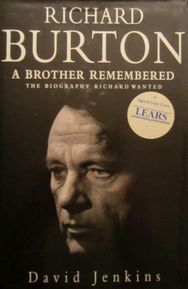
A first edition copy, published in hardback, of David Jenkins' affectionate biography entitled, 'Richard Burton, A Brother Remembered', which was co-written with the assistance of his own daughter, Sue Rogers, and subtitled as 'The Biography Richard Wanted'.
This edition was published by Century in conjunction with Random House, Vauxhall Bridge Road, London in 1993 and printed and bound on black cloth boards with silver gilt lettering by Mackays of Chatham, Kent and issued with the ISBN 0-7126-5768-1.
This superbly written and intimate memoir is illustrated with many black and white photographs and is complete with the original dust-jacket.
Written over a period of ten years, and with unique access to some of Richard Burton's own personal writings, and also drawing on personal family recollections which have never been made public before, 'Richard Burton - A Brother Remembered' is a highly privileged insight into the heart and mind of a true star at every stage of his life.
Rhydwen Williams, Welsh poet and novelist, for the introduction to this marvellous and personal memoir, wrote rather eloquently;
"When we consider the appraisals, criticisms, reviews and biographies written about Richard Burton, we are reminded of the measure of the man and realise that his greatness has still not been adequately accounted for.
Some lose their way in the early beginnings; others fail in dealing with the towering presence and the voice; still others are obsessed with the legendary inebriate and lover.
As a chronicler of Burton, David Jenkins has many advantages. He is a brother, born into the same family of the same parents, often sharing the same bed and always the same table. as such he is equipped - and eager - to erase misconceptions; he is amply equipped to to inform - things only a brother could know.
If he has any disadvantage, it is only the disadvantage of passionate brotherly affection. Unashamedly biased, he writes in the heat of genuine filial loyalty as warm as the blood in his veins.
David Jenkins has a fascinating story to tell; this is more than another biography. It is a testament of quiet pride in the career of an outstanding Welshman and a still more outstanding brother who had to bid farewell to family, friends and admirers the world over far too soon."
The extensive cover notes, written by the publishers, beautifully describe this touching memoir with the synopsis;
"If the legend of Richard Burton - the Welsh boy who squandered looks, talent and finally life - is public property, the real Burton has remained hidden in the hearts and memories of those who knew him all his life - his family.
Richard Walter Jenkins, the youngest but one of thirteen children, was born to a Welsh miner and his beautiful hardworking wife in 1925, just as the Depression began to gnaw at the valleys. Their life as a typical working-class family was thrown into turmoil on the death of his mother when Richard was two. In the infant and schoolboy Richard were the characteristics that would take him to London and Hollywood, to success and adulation, to despair and self-destruction. There was his charm which allowed him to manipulate, to melt hearts, to get his own way with his married sister, his family, his friends. There was his passion and his intensity, finding expression during his teens in brawls and a nascent awareness of girls.
Richard did not leave his old self behind. In his brief, turbulent days at Oxford, in his wild nights in the airforce, he never disowned his large, loving family, and maintained close contact with his brothers and sisters. a wonderful liveliness and self-mocking humour comes out in letters home.
Released from the Forces, Richard returned to London and the stage in 1948. was it on a trip to Hollywood that he saw the fabulously unavailable Elizabeth Taylor for the first time? Certainly that is what he wrote later in the drily witty 'Meeting Mrs. Jenkins', published here in full. In 1961 came Cleopatra. To a young star, still unfulfilled, still happily married with two daughters, it was both a sound career move and a great joke to play lover to the most seductive queen in history. As the relationship developed the family gradually came first to accept, then delight in, their new superstar sister-in-law. Jenkins shrewdly captures the court of the wandering royalty of filmland; Richard the genial host stepping over the line from well-oiled exuberance to drunken temper; Richard the nostalgic, rugby-loving son of the valleys, his jokes, his anecdotes, his happiness, his black depressions and self-doubt; these David Jenkins observed at first hand and now recounts with rare intimacy.
David Jenkins, born eleven years earlier than his brother Richard, left school in his early teens to join the police force, rising eventually to the rank of chief inspector. He is now retired from the police force and is a widower living in South Wales, where he has lived for much of his life.
With Richard's blessing and encouragement he began to assemble a life of the actor for which Richard Burton intended to write a personal introduction. Since his brother's death in 1984, David has continued to record both his own recollections and those of his family in order to present to the world the Richard they all knew".
This edition was published by Century in conjunction with Random House, Vauxhall Bridge Road, London in 1993 and printed and bound on black cloth boards with silver gilt lettering by Mackays of Chatham, Kent and issued with the ISBN 0-7126-5768-1.
This superbly written and intimate memoir is illustrated with many black and white photographs and is complete with the original dust-jacket.
Written over a period of ten years, and with unique access to some of Richard Burton's own personal writings, and also drawing on personal family recollections which have never been made public before, 'Richard Burton - A Brother Remembered' is a highly privileged insight into the heart and mind of a true star at every stage of his life.
Rhydwen Williams, Welsh poet and novelist, for the introduction to this marvellous and personal memoir, wrote rather eloquently;
"When we consider the appraisals, criticisms, reviews and biographies written about Richard Burton, we are reminded of the measure of the man and realise that his greatness has still not been adequately accounted for.
Some lose their way in the early beginnings; others fail in dealing with the towering presence and the voice; still others are obsessed with the legendary inebriate and lover.
As a chronicler of Burton, David Jenkins has many advantages. He is a brother, born into the same family of the same parents, often sharing the same bed and always the same table. as such he is equipped - and eager - to erase misconceptions; he is amply equipped to to inform - things only a brother could know.
If he has any disadvantage, it is only the disadvantage of passionate brotherly affection. Unashamedly biased, he writes in the heat of genuine filial loyalty as warm as the blood in his veins.
David Jenkins has a fascinating story to tell; this is more than another biography. It is a testament of quiet pride in the career of an outstanding Welshman and a still more outstanding brother who had to bid farewell to family, friends and admirers the world over far too soon."
The extensive cover notes, written by the publishers, beautifully describe this touching memoir with the synopsis;
"If the legend of Richard Burton - the Welsh boy who squandered looks, talent and finally life - is public property, the real Burton has remained hidden in the hearts and memories of those who knew him all his life - his family.
Richard Walter Jenkins, the youngest but one of thirteen children, was born to a Welsh miner and his beautiful hardworking wife in 1925, just as the Depression began to gnaw at the valleys. Their life as a typical working-class family was thrown into turmoil on the death of his mother when Richard was two. In the infant and schoolboy Richard were the characteristics that would take him to London and Hollywood, to success and adulation, to despair and self-destruction. There was his charm which allowed him to manipulate, to melt hearts, to get his own way with his married sister, his family, his friends. There was his passion and his intensity, finding expression during his teens in brawls and a nascent awareness of girls.
Richard did not leave his old self behind. In his brief, turbulent days at Oxford, in his wild nights in the airforce, he never disowned his large, loving family, and maintained close contact with his brothers and sisters. a wonderful liveliness and self-mocking humour comes out in letters home.
Released from the Forces, Richard returned to London and the stage in 1948. was it on a trip to Hollywood that he saw the fabulously unavailable Elizabeth Taylor for the first time? Certainly that is what he wrote later in the drily witty 'Meeting Mrs. Jenkins', published here in full. In 1961 came Cleopatra. To a young star, still unfulfilled, still happily married with two daughters, it was both a sound career move and a great joke to play lover to the most seductive queen in history. As the relationship developed the family gradually came first to accept, then delight in, their new superstar sister-in-law. Jenkins shrewdly captures the court of the wandering royalty of filmland; Richard the genial host stepping over the line from well-oiled exuberance to drunken temper; Richard the nostalgic, rugby-loving son of the valleys, his jokes, his anecdotes, his happiness, his black depressions and self-doubt; these David Jenkins observed at first hand and now recounts with rare intimacy.
David Jenkins, born eleven years earlier than his brother Richard, left school in his early teens to join the police force, rising eventually to the rank of chief inspector. He is now retired from the police force and is a widower living in South Wales, where he has lived for much of his life.
With Richard's blessing and encouragement he began to assemble a life of the actor for which Richard Burton intended to write a personal introduction. Since his brother's death in 1984, David has continued to record both his own recollections and those of his family in order to present to the world the Richard they all knew".
This copy of 'Richard Burton - A Brother Remembered' has been personally signed by David Jenkins. The signature was obtained during a book-signing event held at the Lears bookshop in Cardiff in 1993.
Rosemary Kingsland, 'Hold Back The Night'
Century Books, First Edition, 2003
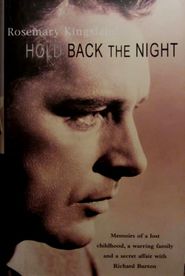
A first edition copy, published in hardback, of writer and journalist Rosemary Kingsland's autobiographical memoir entitled, 'Hold Back The Night'.
This first edition was published by Century, a division of the Random House Group, Vauxhall Bridge Road, London and printed and bound on black cloth boards with gilt lettering by Mackays of Chatham in 2003 and issued with the ISBN 1-844-13189-0.
Subtitled as 'Memoirs of a lost childhood, a warring family and a secret affair with Richard Burton'.
The cover notes, written by the publishers, describe the book as;
"A remarkable memoir that tells the poignant and inspiring story of growing up and falling in love in post-war London. When Rosemary Kingsland was fourteen, life with her endlessly scheming father and melancholic mother had become an endless cycle of eking out a living with very little money, weathering her father's savage outbursts and barely concealed infidelities, and witnessing her mother's breakdowns.
But a sudden and accidental meeting with the brooding and magnetic actor Richard Burton, marks the beginning of an extraordinary passionate affair which was to transform Rosemary's life forever and offer some kind of escape into an entirely new and spellbinding world. 'Hold Back The Night' is a captivating evocation of a childhood, a coming of age, a struggling family and a beautifully written account of a secret love".
This copy is complete with the original dust-jacket featuring a striking studio portrait of Richard Burton. Sadly no further photographs appear in this memoir, which tends to, in my opinion, shed doubt on the credibility of this rather flimsy account of a brief encounter and affair with Richard Burton.
A 2003 paperback edition of 'Hold Back The Night', published by Arrow Books and printed by Bookmarque Limited, issued with the ISBN 0-09-9-45798-9 is also held in the Richard Burton Museum collection. The paperback edition features the same jacket design as this 2003 hardback edition and is again, not illustrated.
This first edition was published by Century, a division of the Random House Group, Vauxhall Bridge Road, London and printed and bound on black cloth boards with gilt lettering by Mackays of Chatham in 2003 and issued with the ISBN 1-844-13189-0.
Subtitled as 'Memoirs of a lost childhood, a warring family and a secret affair with Richard Burton'.
The cover notes, written by the publishers, describe the book as;
"A remarkable memoir that tells the poignant and inspiring story of growing up and falling in love in post-war London. When Rosemary Kingsland was fourteen, life with her endlessly scheming father and melancholic mother had become an endless cycle of eking out a living with very little money, weathering her father's savage outbursts and barely concealed infidelities, and witnessing her mother's breakdowns.
But a sudden and accidental meeting with the brooding and magnetic actor Richard Burton, marks the beginning of an extraordinary passionate affair which was to transform Rosemary's life forever and offer some kind of escape into an entirely new and spellbinding world. 'Hold Back The Night' is a captivating evocation of a childhood, a coming of age, a struggling family and a beautifully written account of a secret love".
This copy is complete with the original dust-jacket featuring a striking studio portrait of Richard Burton. Sadly no further photographs appear in this memoir, which tends to, in my opinion, shed doubt on the credibility of this rather flimsy account of a brief encounter and affair with Richard Burton.
A 2003 paperback edition of 'Hold Back The Night', published by Arrow Books and printed by Bookmarque Limited, issued with the ISBN 0-09-9-45798-9 is also held in the Richard Burton Museum collection. The paperback edition features the same jacket design as this 2003 hardback edition and is again, not illustrated.
Michael Munn, 'Richard Burton - Prince Of Players'
J. R. Books, Signed First Edition, 2009
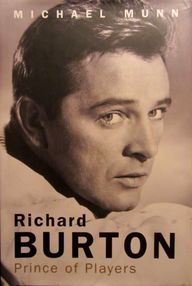
A first edition copy, published in hardback, of the Michael Munn biography entitled, 'Richard Burton - Prince Of Players'.
This book was first published in hardback in 2008 by JR Books, Greenland Street, London and was printed and bound with tan cloth boards with gilt lettering by The Cromwell Limited, Trowbridge, Wiltshire.
This edition was published with a stunning dust-jacket featuring a 1950's studio portrait of Richard Burton and is also illustrated with black and white photographs.
The text, taken from the cover notes, which includes the synopsis of this biography, reads;
"Richard Burton was a man of contradictions. He wanted to escape the mining community of Wales, yet his heart never left it. He wanted to achieve greatness, but he would have been as happy to have achieved it on a rugby pitch as on a stage. he wanted to live life to the full, but he came to know that he was driving himself to an early grave through drink. He was an avid reader and a lover of poetry; a scholar of life and culture. Yet he seemed to squander his talents and find happiness at the bottom of a beer glass, giving up all hopes of becoming a great actor when he sold his soul to Hollywood and his heart to Elizabeth Taylor.
Here is the full story of Richard Burton's life and remarkable career, revealed by a writer who knew him from 1968 up to the time they were together on Burton's last film in 1984. Munn recounts Burton's deepest and often darkest thoughts and secrets, revealing hell-raising stories that Hollywood quashed to save Burton's early film career including affairs with Lana Turner and Marilyn Monroe, being caught in a brothel with Errol Flynn, and a fist fight with Frank Sinatra. He also movingly recalls nursing Burton through an epileptic seizure of a kind that gripped him from his early days, and witnessing a terrifying encounter Burton had with an East End gangster that ended in violence.
In writing this intimate and moving biography, Michael Munn draws on his friendship with Burton over the years and on formal interviews and informal conversations with a great many of the stars who knew and worked with Burton."
Contemporary reviews from The Daily Express and The Daily Mail read;
"Munn offers some choice anecdotes...There's no denying his affection for Burton, who comes across as modest, generous and decent as well as irreverent and funny."
"After reading this affectionately candid biography, it is hard not to echo Olivier's response on hearing of Burton's death: 'He was young, so young'."
This edition was issued with the ISBN 978-1-906217-15-0.
Michael Munn is a British author and film historian whose previous show-business biographies have included works on Steve McQueen, John Wayne, David Niven, Frank Sinatra, Laurence Olivier and James Stewart.
A first edition paperback copy of this book is also held in the Richard Burton Museum collection, also published by JR Books and printed by Bookmarque Limited. Issued with the ISBN 978-1-906217-86-0. The paperback edition features the same cover design as the above hardback edition.
This book was first published in hardback in 2008 by JR Books, Greenland Street, London and was printed and bound with tan cloth boards with gilt lettering by The Cromwell Limited, Trowbridge, Wiltshire.
This edition was published with a stunning dust-jacket featuring a 1950's studio portrait of Richard Burton and is also illustrated with black and white photographs.
The text, taken from the cover notes, which includes the synopsis of this biography, reads;
"Richard Burton was a man of contradictions. He wanted to escape the mining community of Wales, yet his heart never left it. He wanted to achieve greatness, but he would have been as happy to have achieved it on a rugby pitch as on a stage. he wanted to live life to the full, but he came to know that he was driving himself to an early grave through drink. He was an avid reader and a lover of poetry; a scholar of life and culture. Yet he seemed to squander his talents and find happiness at the bottom of a beer glass, giving up all hopes of becoming a great actor when he sold his soul to Hollywood and his heart to Elizabeth Taylor.
Here is the full story of Richard Burton's life and remarkable career, revealed by a writer who knew him from 1968 up to the time they were together on Burton's last film in 1984. Munn recounts Burton's deepest and often darkest thoughts and secrets, revealing hell-raising stories that Hollywood quashed to save Burton's early film career including affairs with Lana Turner and Marilyn Monroe, being caught in a brothel with Errol Flynn, and a fist fight with Frank Sinatra. He also movingly recalls nursing Burton through an epileptic seizure of a kind that gripped him from his early days, and witnessing a terrifying encounter Burton had with an East End gangster that ended in violence.
In writing this intimate and moving biography, Michael Munn draws on his friendship with Burton over the years and on formal interviews and informal conversations with a great many of the stars who knew and worked with Burton."
Contemporary reviews from The Daily Express and The Daily Mail read;
"Munn offers some choice anecdotes...There's no denying his affection for Burton, who comes across as modest, generous and decent as well as irreverent and funny."
"After reading this affectionately candid biography, it is hard not to echo Olivier's response on hearing of Burton's death: 'He was young, so young'."
This edition was issued with the ISBN 978-1-906217-15-0.
Michael Munn is a British author and film historian whose previous show-business biographies have included works on Steve McQueen, John Wayne, David Niven, Frank Sinatra, Laurence Olivier and James Stewart.
A first edition paperback copy of this book is also held in the Richard Burton Museum collection, also published by JR Books and printed by Bookmarque Limited. Issued with the ISBN 978-1-906217-86-0. The paperback edition features the same cover design as the above hardback edition.
This first edition copy of 'Richard Burton - Prince Of Players' has been personally and very kindly, signed to myself by the author, Michael Munn.
Sam Kashner & Nancy Schoenberger, 'Furious Love'
Harper Collins, First Edition, 2010
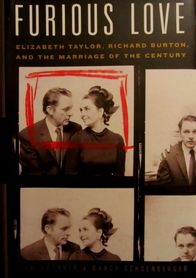
An American first edition copy, published in hardback, of the Sam Kashner and Nancy Schoenberger outstanding biography entitled, 'Furious Love - Elizabeth Taylor, Richard Burton and the Marriage of the Century'.
This copy was printed and published by Harper Collins, New York in 2010 and is illustrated with black and white photographs. This American edition was published on grey, embossed boards with gilt lettering and is further enhanced with an outstanding dust-jacket, designed by Christine Van Bree and Archie Ferguson, which incorporates studio photographs of Burton and Taylor captured by the renowned Hollywood photographer Henry Grossman, and from which the following detailed text and full synopsis is taken;
"He was a tough-guy Welshman softened by the affections of a breathtakingly beautiful woman; she was a modern-day Cleopatra madly in love with her own Mark Anthony. For nearly a quarter of a century, Elizabeth Taylor and Richard Burton were Hollywood royalty, and their fiery romance - often called 'the marriage of the century' - was the most notorious, publicised, and celebrated love affair of its day.
For the first time, Vanity fair contributing editor Sam Kashner and acclaimed biographer Nancy Schoenberger tell the complete story of this larger-than-life couple, showing how their romance and two marriages commanded the attention of the world. Also for the first time, in exclusive access given to the authors, Elizabeth Taylor herself gives never-revealed details and firsthand accounts of her life with Burton.
Drawing upon brand-new information and interviews - and on Burton's private, passionate, and heartbreaking letters to Taylor - 'Furious Love' sheds new light on the movies, the sex, the scandal, the fame, the brawls, the booze, the bitter separations, and, of course, the fabled jewels. It offers an intimate glimpse into Elizabeth and Richard's privileged world and their elite circle of friends, among them Princess Grace, Montgomery Clift, the Duke and Duchess of Windsor, Peter O' Toole, Michael Caine, Marlon Brando, Rex Harrison, Mike Nicols, Laurence Olivier, Robert Kennedy, Tennessee Williams, Noel Coward, John Huston, Ava Gardner, the Rothschilds, Maria Callas, and Aristotle Onassis. It provides an entertaining, eye-opening look at their films, their wildly lucrative reign in Europe and in Hollywood - and the price they paid for their extravagant lives.
Shocking and unsparing in its honesty, 'Furious Love' explores the very public marriage of 'Liz and Dick' as well as the private struggles of Elizabeth and Richard, including 'Le Scandale', their affair on the set of the notorious epic,'Cleopatra' that earned them condemnation from the Vatican; Burton's hardscrabble youth in Wales; the crippling alcoholism that nearly destroyed his career and contributed to his early death; the medical issues that plagued both him and Elizabeth; and the failed aspirations and shame that haunted him throughout their relationship. As Kashner and Schoenberger
illuminate the events and choices that shaped this illustrious couple's story, they demonstrate how the legendary pair presaged America's changing attitudes towards sex, marriage, morality and celebrity. Yet ultimately, as the authors show, Elizabeth and Richard shared something priceless beyond the drama; enduring love.
Addictive and entertaining, 'Furious Love' is more than a celebrity biography, it's an honest yet sympathetic portrait of a man, a woman, and a passion that shocked and mesmerized the world."
This edition was designed for Harper Collins by Eric Butler and was issued with the ISBN 978-0-06-1562646.
Sam Kashner is a contributing editor at Vanity Fair and has written articles on, amongst others, Marilyn Monroe, Mike Nicols and Robert Kennedy. He is also the author of three volumes of poetry, 'Driving By Night,' 'No More Mr.Nice Guy' and 'Don Quixote in America'.
Nancy Schoenberger is an award-winning author whose previous works include the biography, 'Dangerous Muse:The Life of Lady Caroline Blackwood,' as well as three volumes of poetry. She is also a teacher and director of the Creative Writing Programme at the College of William and Mary in Virginia.
Sam Kashner and Nancy Schoenberger also frequently collaborate on screenplays and articles.
This copy was printed and published by Harper Collins, New York in 2010 and is illustrated with black and white photographs. This American edition was published on grey, embossed boards with gilt lettering and is further enhanced with an outstanding dust-jacket, designed by Christine Van Bree and Archie Ferguson, which incorporates studio photographs of Burton and Taylor captured by the renowned Hollywood photographer Henry Grossman, and from which the following detailed text and full synopsis is taken;
"He was a tough-guy Welshman softened by the affections of a breathtakingly beautiful woman; she was a modern-day Cleopatra madly in love with her own Mark Anthony. For nearly a quarter of a century, Elizabeth Taylor and Richard Burton were Hollywood royalty, and their fiery romance - often called 'the marriage of the century' - was the most notorious, publicised, and celebrated love affair of its day.
For the first time, Vanity fair contributing editor Sam Kashner and acclaimed biographer Nancy Schoenberger tell the complete story of this larger-than-life couple, showing how their romance and two marriages commanded the attention of the world. Also for the first time, in exclusive access given to the authors, Elizabeth Taylor herself gives never-revealed details and firsthand accounts of her life with Burton.
Drawing upon brand-new information and interviews - and on Burton's private, passionate, and heartbreaking letters to Taylor - 'Furious Love' sheds new light on the movies, the sex, the scandal, the fame, the brawls, the booze, the bitter separations, and, of course, the fabled jewels. It offers an intimate glimpse into Elizabeth and Richard's privileged world and their elite circle of friends, among them Princess Grace, Montgomery Clift, the Duke and Duchess of Windsor, Peter O' Toole, Michael Caine, Marlon Brando, Rex Harrison, Mike Nicols, Laurence Olivier, Robert Kennedy, Tennessee Williams, Noel Coward, John Huston, Ava Gardner, the Rothschilds, Maria Callas, and Aristotle Onassis. It provides an entertaining, eye-opening look at their films, their wildly lucrative reign in Europe and in Hollywood - and the price they paid for their extravagant lives.
Shocking and unsparing in its honesty, 'Furious Love' explores the very public marriage of 'Liz and Dick' as well as the private struggles of Elizabeth and Richard, including 'Le Scandale', their affair on the set of the notorious epic,'Cleopatra' that earned them condemnation from the Vatican; Burton's hardscrabble youth in Wales; the crippling alcoholism that nearly destroyed his career and contributed to his early death; the medical issues that plagued both him and Elizabeth; and the failed aspirations and shame that haunted him throughout their relationship. As Kashner and Schoenberger
illuminate the events and choices that shaped this illustrious couple's story, they demonstrate how the legendary pair presaged America's changing attitudes towards sex, marriage, morality and celebrity. Yet ultimately, as the authors show, Elizabeth and Richard shared something priceless beyond the drama; enduring love.
Addictive and entertaining, 'Furious Love' is more than a celebrity biography, it's an honest yet sympathetic portrait of a man, a woman, and a passion that shocked and mesmerized the world."
This edition was designed for Harper Collins by Eric Butler and was issued with the ISBN 978-0-06-1562646.
Sam Kashner is a contributing editor at Vanity Fair and has written articles on, amongst others, Marilyn Monroe, Mike Nicols and Robert Kennedy. He is also the author of three volumes of poetry, 'Driving By Night,' 'No More Mr.Nice Guy' and 'Don Quixote in America'.
Nancy Schoenberger is an award-winning author whose previous works include the biography, 'Dangerous Muse:The Life of Lady Caroline Blackwood,' as well as three volumes of poetry. She is also a teacher and director of the Creative Writing Programme at the College of William and Mary in Virginia.
Sam Kashner and Nancy Schoenberger also frequently collaborate on screenplays and articles.
Sam Kashner & Nancy Schoenberger, 'Furious Love'
J. R. Books, First Edition, 2010
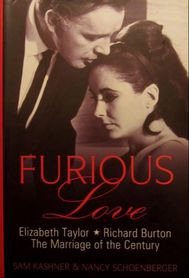
A copy of the British first edition of 'Furious Love, Elizabeth Taylor, Richard Burton and the Marriage of the Century', written by Sam Kashner and Nancy Schoenberger.
This edition was published in hardback by JR Books, London and printed by MPG Books, based in Bodmin, Cornwall, in 2010.
This copy was issued with the ISBN 978-1-907532-22-1 and is illustrated with black and white photographs and is complete with the original dust-jacket, designed by Richard Mason.
The description and synopsis of this well-researched biography, taken from the cover notes of this British first edition, reads;
"The marriage of Richard Burton and Elizabeth Taylor reigns above all others in the history of Hollywood. In this unique look at the couples relationship Kashner and Schoenberger draw upon brand-new research and interviews - including unprecedented access to Taylor herself, to the Burton family, and to Taylor's extensive personal correspondence - to write the first definitive account of these two classic subjects, the true king and queen of Hollywood.
Unsparing in it's honesty and shocking on many fronts, 'Furious Love' covers Burton's troubled family connections and his horrible, literally crippling alcoholism, which threatened his acting career and eventually killed him. It includes the notorious and jaw-dropping sexual escapades and problems experienced by the couple - perfect and beautiful on the outside but whose travails were legion - and explores in depth the power play, struggle and audacity of Burton's wooing of Taylor on the set of 'Cleopatra', which began when Taylor was still married.
Thanks to the authors' access to Taylor's private collection of letters and correspondence, the book includes intimate and startling details about the sexual, romantic and even medical issues that plagued the couple throughout their long courtship, marriages and bitter separations.
No other couple in the history of Hollywood has been as glamorous, audacious, trendsetting and memorable as Taylor and Burton. Their legacy endures."
This edition, as in the first edition American copy above, also features extensive end-notes, a bibliography and two poems written by Richard Burton; 'A Portrait Of A Man Drowning' and an untitled piece, possibly dating from around 1965.
A first edition paperback copy of 'Furious Love' is also held in the Richard Burton Museum collection, issued with the same jacket design and photographs and published by JR Books with the ISBN 978-1-907532-40-5.
This edition was published in hardback by JR Books, London and printed by MPG Books, based in Bodmin, Cornwall, in 2010.
This copy was issued with the ISBN 978-1-907532-22-1 and is illustrated with black and white photographs and is complete with the original dust-jacket, designed by Richard Mason.
The description and synopsis of this well-researched biography, taken from the cover notes of this British first edition, reads;
"The marriage of Richard Burton and Elizabeth Taylor reigns above all others in the history of Hollywood. In this unique look at the couples relationship Kashner and Schoenberger draw upon brand-new research and interviews - including unprecedented access to Taylor herself, to the Burton family, and to Taylor's extensive personal correspondence - to write the first definitive account of these two classic subjects, the true king and queen of Hollywood.
Unsparing in it's honesty and shocking on many fronts, 'Furious Love' covers Burton's troubled family connections and his horrible, literally crippling alcoholism, which threatened his acting career and eventually killed him. It includes the notorious and jaw-dropping sexual escapades and problems experienced by the couple - perfect and beautiful on the outside but whose travails were legion - and explores in depth the power play, struggle and audacity of Burton's wooing of Taylor on the set of 'Cleopatra', which began when Taylor was still married.
Thanks to the authors' access to Taylor's private collection of letters and correspondence, the book includes intimate and startling details about the sexual, romantic and even medical issues that plagued the couple throughout their long courtship, marriages and bitter separations.
No other couple in the history of Hollywood has been as glamorous, audacious, trendsetting and memorable as Taylor and Burton. Their legacy endures."
This edition, as in the first edition American copy above, also features extensive end-notes, a bibliography and two poems written by Richard Burton; 'A Portrait Of A Man Drowning' and an untitled piece, possibly dating from around 1965.
A first edition paperback copy of 'Furious Love' is also held in the Richard Burton Museum collection, issued with the same jacket design and photographs and published by JR Books with the ISBN 978-1-907532-40-5.
Tom Rubython, 'And God Created Burton'
The Myrtle Press, Signed First Edition, 2011
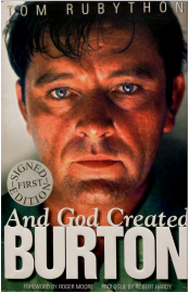
A first edition copy, published in hardback, of the incredibly detailed biography entitled, 'And God Created Burton', written by Tom Rubython.
This edition was published by The Myrtle Press, London, and printed by CPI Clowes, based in Suffolk, in 2011.
This first edition copy has the added addition of having been signed by the author, Tom Rubython.
An outstanding, well-written and incredibly well-researched book, it is also lavishly illustrated with colour and black and white photographs, many not seen before, the highlight being a beautifully colourised photographic wedding portrait of Richard Burton's parents, the only one known to exist, which was given to Richard Burton's sister Cecilia after her mother's death in 1927, and which was believed to have been lost until rediscovered by Tom Rubython at Cecilia's daughter's house in Oxfordshire during the research undertaken for the book.
This edition features a prologue entitled, 'A Welsh Prince Of His Time', written by Robert Hardy and a foreword entitled, 'The Greatest Voice Of His Time', written by Richard Burton's contemporary and co-star of 'The Wild Geese', Sir Roger Moore.
This copy is complete with the original dust-jacket which features a stunning colour photograph of Richard Burton taken during the filming of 'The Night Of The Iguana'.
In my opinion, this is the most comprehensive, detailed and complete Richard Burton biography written to date.
The publishers cover notes include a synopsis for this incredible biography which reads;
"A sweeping saga spanning 1898 to 1984, stretching from the mining fields of South Wales to the film sets of Hollywood, and from the playhouses of Cardiff to the grand theatres of Broadway - this new and far reaching biography rakes over the coals of the life of Britain's greatest ever actor, Richard Burton. 'And God Created Burton' is the first complete biography of the greatest Welshman who ever lived.
The man conquered Hollywood in a way that no British actor had before or since, rising to become the highest earning actor Britain has ever produced. His achievements were considered all the greater as they were accomplished in the era of great British actors, such as Laurence Olivier and John Gielgud. All the more so as Burton's prowess uniquely spanned theatre, film and television in a way no other actor has before. Burton became a genuine legend in his own lifetime and, in the mid sixties, for one year, he stood at the very pinnacle of Hollywood as the world's most bankable actor. He also loved and lost some of the most beautiful and talented actresses of the era, including Elizabeth Taylor, Claire Bloom and Susan Strasberg. But he could have achieved even more but for his addiction to alcohol, a fate that was inherited from his father which stayed with him right to the end of his days, eventually killing him and tarnishing an otherwise extraordinary career."
Robert Hardy's beautifully written prologue entitled, 'A Welsh Prince of His Time' reads as follows;
"Rishiart of Pontrhydyfen - a legend? a myth? a Welsh prince of the time before Owain Glyndwr? Not to begin with - "To begin at the beginning", he was little Richie Jenkins, the tenth surviving child of a miner's family, of No.2 Dan-y-Bont. There was Twm, Cecilia - but always 'Cis' - Ifor, William, David, Verdun (born 1916, you see), Hilda, Catherine, Edith, Rich and Graham. Soon after that, their mother, Edith, died. A great part of their life gone, the family circled protectively around the youngest; a family of much nobility - not the nobility of ermine, but of dignity, loyalty and pride.
Not yet a prince, but a bright schoolboy who attracted attention wherever he fixed his blue gaze; mad for Rugby football, for music, for words, for cricket 'and the run-stealers flitting to and fro'. More than one teacher saw in him promise; Philip Burton, the senior English master at Port Talbot Secondary School, himself a miner's son, saw in Richard a glow of genius, which he slowly fanned into a flame. Later, he would adopt him, with the family's blessing and to the relief of Cis, who had stepped into their mother's place and was hard put to it to look after a husband, her own children and her young brother.
From now, he would be Richard Burton 'absolutely to renounce his surname and bear the surname of the adopter and be held out to the world as if he were the child of Philip Burton.' Philip brought him forward, tutored him in literature and drama, teaching him the language of England and of Shakespeare.
So came the War, and in a crowd of half soldiers, sailors and airman, half undergraduates, Richard and I, went up to Oxford, met, and loathed each other - until one day poring over a map in navigation class, we spotted at the same moment the River Trent: "See how this river comes me cranking in..." said one; the other followed with "and cuts me from the best of all my land, a huge half-moon, a monstrous cantle out..." Hotspur, Shakespeare and his 'Henry IV' had formed a bond that lasted all one life (far, far too short), and still, the other.
The year of the Festival of Britain, when she strove to regain her spirits after the horrors and the gloom of war, saw Richard as a medieval prince at last; Hal, of the Shakespeare Histories, Henry of Agincourt at Stratford-on-Avon. From then, there was no stopping in the eagle-flight, bar the occasional hard landing and a stoup or two (not the falcon's stoop), and Rich became a great Shakespearean - I mean truly great, not as the word is misused now.
There had been a day near a Norfolk airfield, in the War, Easter Sunday and he and I swam in an icy sea and came back to the sands with one handkerchief to dry us both. We ran to warm ourselves, shouting bits of Hal, Hamlet, Coriolanus, Lear too probably, arguing how to play them...I was posted the next day and, in saying goodbye, told him; "Whatever you do, as actor, politician or anything else, you will do greatly." It came true, size of spirit, breadth of mind - even his life mistakes were great, his finest achievements unique, his voice unmatched.
My thoughts go back to Hampstead and to Rich with Sybil, all spirited gaiety and all forgiving love, and to Kate, the best of each of them, until one day Rich became Anthony - with Cleopatra - and a huge and famous, ferocious passion ensued. Richard and Elizabeth - Dame Elizabeth - twice married, twice divorced, always in love and longing for each other, even until death.
Richard's life is famous, though only a fortunate few know of his wide generosity, his gentleness in the still centre of the fire and sometimes fury. A genius, 'perhaps a flawed genius, but there has to be a precious stone to have a flaw'. At the last, peace perhaps, writing words, reading them in his library. Now, in a sense, he is going back to Wales, which, however far he travelled, he never really left, to a theatre that will bear his name and which, I fancy, he will haunt. The Royal Welsh College of Music and Drama which houses the Richard Burton Theatre must do 'Doctor Faustus' for him one day; "the only play", he said, "I don't have to work on, I am Faustus!".
For more information, the book has its own website, 'And God Created Burton' which can be found on the 'Links' page of this website.
Tom Rubython is best known as a journalist and author specialising in the subjects of business and sport. His previous works have included biographies of the racing legends Ayrton Senna and James Hunt.
Tom Rubython is also the founder and publisher of both Formula 1 and Business F1 magazines.
This edition was published by The Myrtle Press, London, and printed by CPI Clowes, based in Suffolk, in 2011.
This first edition copy has the added addition of having been signed by the author, Tom Rubython.
An outstanding, well-written and incredibly well-researched book, it is also lavishly illustrated with colour and black and white photographs, many not seen before, the highlight being a beautifully colourised photographic wedding portrait of Richard Burton's parents, the only one known to exist, which was given to Richard Burton's sister Cecilia after her mother's death in 1927, and which was believed to have been lost until rediscovered by Tom Rubython at Cecilia's daughter's house in Oxfordshire during the research undertaken for the book.
This edition features a prologue entitled, 'A Welsh Prince Of His Time', written by Robert Hardy and a foreword entitled, 'The Greatest Voice Of His Time', written by Richard Burton's contemporary and co-star of 'The Wild Geese', Sir Roger Moore.
This copy is complete with the original dust-jacket which features a stunning colour photograph of Richard Burton taken during the filming of 'The Night Of The Iguana'.
In my opinion, this is the most comprehensive, detailed and complete Richard Burton biography written to date.
The publishers cover notes include a synopsis for this incredible biography which reads;
"A sweeping saga spanning 1898 to 1984, stretching from the mining fields of South Wales to the film sets of Hollywood, and from the playhouses of Cardiff to the grand theatres of Broadway - this new and far reaching biography rakes over the coals of the life of Britain's greatest ever actor, Richard Burton. 'And God Created Burton' is the first complete biography of the greatest Welshman who ever lived.
The man conquered Hollywood in a way that no British actor had before or since, rising to become the highest earning actor Britain has ever produced. His achievements were considered all the greater as they were accomplished in the era of great British actors, such as Laurence Olivier and John Gielgud. All the more so as Burton's prowess uniquely spanned theatre, film and television in a way no other actor has before. Burton became a genuine legend in his own lifetime and, in the mid sixties, for one year, he stood at the very pinnacle of Hollywood as the world's most bankable actor. He also loved and lost some of the most beautiful and talented actresses of the era, including Elizabeth Taylor, Claire Bloom and Susan Strasberg. But he could have achieved even more but for his addiction to alcohol, a fate that was inherited from his father which stayed with him right to the end of his days, eventually killing him and tarnishing an otherwise extraordinary career."
Robert Hardy's beautifully written prologue entitled, 'A Welsh Prince of His Time' reads as follows;
"Rishiart of Pontrhydyfen - a legend? a myth? a Welsh prince of the time before Owain Glyndwr? Not to begin with - "To begin at the beginning", he was little Richie Jenkins, the tenth surviving child of a miner's family, of No.2 Dan-y-Bont. There was Twm, Cecilia - but always 'Cis' - Ifor, William, David, Verdun (born 1916, you see), Hilda, Catherine, Edith, Rich and Graham. Soon after that, their mother, Edith, died. A great part of their life gone, the family circled protectively around the youngest; a family of much nobility - not the nobility of ermine, but of dignity, loyalty and pride.
Not yet a prince, but a bright schoolboy who attracted attention wherever he fixed his blue gaze; mad for Rugby football, for music, for words, for cricket 'and the run-stealers flitting to and fro'. More than one teacher saw in him promise; Philip Burton, the senior English master at Port Talbot Secondary School, himself a miner's son, saw in Richard a glow of genius, which he slowly fanned into a flame. Later, he would adopt him, with the family's blessing and to the relief of Cis, who had stepped into their mother's place and was hard put to it to look after a husband, her own children and her young brother.
From now, he would be Richard Burton 'absolutely to renounce his surname and bear the surname of the adopter and be held out to the world as if he were the child of Philip Burton.' Philip brought him forward, tutored him in literature and drama, teaching him the language of England and of Shakespeare.
So came the War, and in a crowd of half soldiers, sailors and airman, half undergraduates, Richard and I, went up to Oxford, met, and loathed each other - until one day poring over a map in navigation class, we spotted at the same moment the River Trent: "See how this river comes me cranking in..." said one; the other followed with "and cuts me from the best of all my land, a huge half-moon, a monstrous cantle out..." Hotspur, Shakespeare and his 'Henry IV' had formed a bond that lasted all one life (far, far too short), and still, the other.
The year of the Festival of Britain, when she strove to regain her spirits after the horrors and the gloom of war, saw Richard as a medieval prince at last; Hal, of the Shakespeare Histories, Henry of Agincourt at Stratford-on-Avon. From then, there was no stopping in the eagle-flight, bar the occasional hard landing and a stoup or two (not the falcon's stoop), and Rich became a great Shakespearean - I mean truly great, not as the word is misused now.
There had been a day near a Norfolk airfield, in the War, Easter Sunday and he and I swam in an icy sea and came back to the sands with one handkerchief to dry us both. We ran to warm ourselves, shouting bits of Hal, Hamlet, Coriolanus, Lear too probably, arguing how to play them...I was posted the next day and, in saying goodbye, told him; "Whatever you do, as actor, politician or anything else, you will do greatly." It came true, size of spirit, breadth of mind - even his life mistakes were great, his finest achievements unique, his voice unmatched.
My thoughts go back to Hampstead and to Rich with Sybil, all spirited gaiety and all forgiving love, and to Kate, the best of each of them, until one day Rich became Anthony - with Cleopatra - and a huge and famous, ferocious passion ensued. Richard and Elizabeth - Dame Elizabeth - twice married, twice divorced, always in love and longing for each other, even until death.
Richard's life is famous, though only a fortunate few know of his wide generosity, his gentleness in the still centre of the fire and sometimes fury. A genius, 'perhaps a flawed genius, but there has to be a precious stone to have a flaw'. At the last, peace perhaps, writing words, reading them in his library. Now, in a sense, he is going back to Wales, which, however far he travelled, he never really left, to a theatre that will bear his name and which, I fancy, he will haunt. The Royal Welsh College of Music and Drama which houses the Richard Burton Theatre must do 'Doctor Faustus' for him one day; "the only play", he said, "I don't have to work on, I am Faustus!".
For more information, the book has its own website, 'And God Created Burton' which can be found on the 'Links' page of this website.
Tom Rubython is best known as a journalist and author specialising in the subjects of business and sport. His previous works have included biographies of the racing legends Ayrton Senna and James Hunt.
Tom Rubython is also the founder and publisher of both Formula 1 and Business F1 magazines.
The frontispiece to 'And God Created Burton' which features the signature of the author, Tom Rubython, and an image of the back cover which incorporates a stunning image of Richard Burton from the 1970's.
'The Richard Burton Diaries' Edited By Chris Williams
The Yale University Press, Signed First Edition, 2012
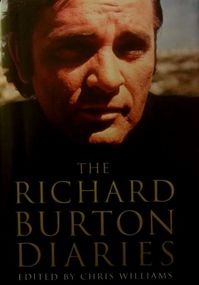
Another incredible book, which had its official launch at the Taliesin Arts Centre based at Swansea University on the 28th of November 2012, is the complete, long awaited and beautifully presented, 'The Richard Burton Diaries'.
This incredible book was edited by Professor Chris Williams, Professor of Welsh History and director of The College Of Arts And Humanities and former director of The Richard Burton Centre, based at Swansea University.
Incredibly well-researched and with a very detailed introduction and invaluable footnotes, this is the book which all Richard Burton admirers, researchers and historians have been waiting to read.
This particular copy has the delightful addition of having been signed by the editor of the diaries, Professor Chris Williams.
The publishers cover notes for the diaries describe their importance;
"In his personal diaries Richard Burton is a man quite different from the one we familiarly 'know' as acclaimed actor; international film star and jet-set celebrity. From his private, manuscript pages there emerges a different person - a family man, a father, a husband, a man often troubled and always keenly observing. Understood through his own words, day to day and year by year, Burton becomes a fully rounded human being who, with a wealth of talent and a surprising burden of insecurity, confronts the peculiar challenges of a life lived largely in the spotlight.
This volume publishes for the first time the surviving diaries of Richard Burton. The diaries were written between 1939 and 1983 - throughout his career and the years of his celebrated marriages to Elizabeth Taylor. Diary entries appear in their original sequence, with annotations to clarify the people, places, books and events mentioned. At times Burton struggles to come to terms with the unfulfilled potential of his life and talent. In other entries, he crows over achievements and hungers for greater challenges. He may be watching his weight, watching his drinking, or watching other men watch his Elizabeth. Always he is articulate, opinionated and fascinating. His diaries offer a rare and fresh perspective on his own life and career, Elizabeth Taylor's, and the glamorous world of film, theatre and celebrity which they inhabited".
This is a first edition hardback copy which was published and printed by the Yale University Press, based in New Haven and London in 2012.
This copy is complete with the original dust-jacket and was issued with the ISBN 978-0-300-18010-07.
Beautifully packaged, presented and illustrated with black and white photographs, this hard cover edition is further enhanced by a stunning colour cover portrait of Richard Burton on the dust-jacket.
Reviewed by Richard Burton biographer Melvyn Bragg for The Sunday Times, contemporary to the books publication, he wrote;
''(The Diaries are) a waterfall of pleasure, funny, self-lacerating, highly indiscreet, competitive and rifted with an elegiac melancholy.'
This incredible book was edited by Professor Chris Williams, Professor of Welsh History and director of The College Of Arts And Humanities and former director of The Richard Burton Centre, based at Swansea University.
Incredibly well-researched and with a very detailed introduction and invaluable footnotes, this is the book which all Richard Burton admirers, researchers and historians have been waiting to read.
This particular copy has the delightful addition of having been signed by the editor of the diaries, Professor Chris Williams.
The publishers cover notes for the diaries describe their importance;
"In his personal diaries Richard Burton is a man quite different from the one we familiarly 'know' as acclaimed actor; international film star and jet-set celebrity. From his private, manuscript pages there emerges a different person - a family man, a father, a husband, a man often troubled and always keenly observing. Understood through his own words, day to day and year by year, Burton becomes a fully rounded human being who, with a wealth of talent and a surprising burden of insecurity, confronts the peculiar challenges of a life lived largely in the spotlight.
This volume publishes for the first time the surviving diaries of Richard Burton. The diaries were written between 1939 and 1983 - throughout his career and the years of his celebrated marriages to Elizabeth Taylor. Diary entries appear in their original sequence, with annotations to clarify the people, places, books and events mentioned. At times Burton struggles to come to terms with the unfulfilled potential of his life and talent. In other entries, he crows over achievements and hungers for greater challenges. He may be watching his weight, watching his drinking, or watching other men watch his Elizabeth. Always he is articulate, opinionated and fascinating. His diaries offer a rare and fresh perspective on his own life and career, Elizabeth Taylor's, and the glamorous world of film, theatre and celebrity which they inhabited".
This is a first edition hardback copy which was published and printed by the Yale University Press, based in New Haven and London in 2012.
This copy is complete with the original dust-jacket and was issued with the ISBN 978-0-300-18010-07.
Beautifully packaged, presented and illustrated with black and white photographs, this hard cover edition is further enhanced by a stunning colour cover portrait of Richard Burton on the dust-jacket.
Reviewed by Richard Burton biographer Melvyn Bragg for The Sunday Times, contemporary to the books publication, he wrote;
''(The Diaries are) a waterfall of pleasure, funny, self-lacerating, highly indiscreet, competitive and rifted with an elegiac melancholy.'
The striking inner cover of the first edition copy of 'The Richard Burton Diaries' features a photograph of the notebooks and diaries used by Richard Burton from the years 1939 until just before his death in 1984. These original diaries are now housed in the Richard Burton Centre of Swansea University, South Wales.
'The Richard Burton Diaries' Edited By Chris Williams
The Yale University Press, Paperback First Edition, 2013
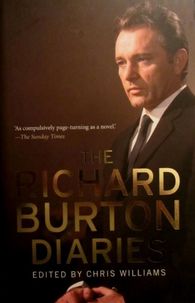
A first edition copy, published in paperback format, of the outstanding, 'The Richard Burton Diaries', which was edited by Professor Chris Williams and originally published in hardback in 2012.
This edition was published by the Yale University Press, New Haven and London and was printed by T. J. International Limited based in Padstow, Cornwall.
This paperback edition was issued with the ISBN 978-0-300-19728-0 and is illustrated with black and white photographs.
The paperback version differs greatly in design from the original hardback edition and features a portrait of Richard Burton on the cover taken from the 1963 film, 'The V.I.P's'.
The cover notes for this paperback edition read;
"Magnetic on stage and screen, Richard Burton rose from humble beginnings in Wales to become Hollywood's most highly paid actor. His epic romance with Elizabeth Taylor, legendary drinking, dazzling purchases and enormous talent kept him constantly in the public eye. Yet the man behind the celebrity facade carried a surprising burden of insecurity and struggled with life in the spotlight.
Burton's personal diaries, published in full for the first time, encompass his entire career and reveal him in his most personal moments. While he rubbed shoulders with shining lights - among them Olivia de Havilland, John Gielgud, Claire Bloom, Laurence Olivier, John Huston, Dylan Thomas and Edward Albee - he also played real-life roles of supportive husband and father.
Eloquent and opinionated, Burton offers a unique perspective on his own triumphs and demons, and the glittering circles in which he moved."
Christopher Fowler, reviewing the paperback edition for the 'Independent On Sunday' wrote;
"An addictive, articulate compendium that dazzles and delights...Most present-day actors would read this and weep at the level of sheer damned glamour and sexiness flooding Burton's daily life."
This edition was published by the Yale University Press, New Haven and London and was printed by T. J. International Limited based in Padstow, Cornwall.
This paperback edition was issued with the ISBN 978-0-300-19728-0 and is illustrated with black and white photographs.
The paperback version differs greatly in design from the original hardback edition and features a portrait of Richard Burton on the cover taken from the 1963 film, 'The V.I.P's'.
The cover notes for this paperback edition read;
"Magnetic on stage and screen, Richard Burton rose from humble beginnings in Wales to become Hollywood's most highly paid actor. His epic romance with Elizabeth Taylor, legendary drinking, dazzling purchases and enormous talent kept him constantly in the public eye. Yet the man behind the celebrity facade carried a surprising burden of insecurity and struggled with life in the spotlight.
Burton's personal diaries, published in full for the first time, encompass his entire career and reveal him in his most personal moments. While he rubbed shoulders with shining lights - among them Olivia de Havilland, John Gielgud, Claire Bloom, Laurence Olivier, John Huston, Dylan Thomas and Edward Albee - he also played real-life roles of supportive husband and father.
Eloquent and opinionated, Burton offers a unique perspective on his own triumphs and demons, and the glittering circles in which he moved."
Christopher Fowler, reviewing the paperback edition for the 'Independent On Sunday' wrote;
"An addictive, articulate compendium that dazzles and delights...Most present-day actors would read this and weep at the level of sheer damned glamour and sexiness flooding Burton's daily life."
Andrew Sinclair, 'Down Under Milk Wood'
Timon Films Limited, First Edition, 2014
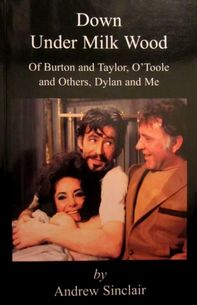
A first edition, softback copy, of Andrew Sinclair's personal recollections of the filming of his 1972 adaption of 'Under Milk Wood', which starred Richard Burton, Elizabeth Taylor and Peter O'Toole and a host of Welsh actors and actresses.
This edition was published by Timon Films Limited, Grosvenor Road, London, and was printed by The Witley Press, based in Hunstanton, in 2014.
This wonderful book, (written by Andrew Sinclair in his own delightfully characteristic rambling, eccentric way), is a pure delight to read. Alongside a complete cast list and technical credits, the book is divided into several sections relating to the filming, in Fishguard, West Wales, of the 1972 Timon Film version of 'Under Milk Wood'.
In the opening chapter Andrew Sinclair describes how he discovered the words of Dylan Thomas in his youth and the impact and influence they created in his life, most notably inspiring his early short film, 'Adventures In The Skin Trade', which was based on Dylan Thomas's unfinished novel of the same name, which starred a young David Hemmings.
The book then goes on to describe the fascinating story of how the film version of 'Under Milk Wood' came into fruition, his relationship with the cast and crew and which also went on to include the local population of Fishguard itself.
The book is a fascinating insight to all things concerning the filming, of how the lighting effects were created, the creation of Llareggub, his stormy and difficult relationship with Elizabeth Taylor, the tragic drowning of a young local boy and how Peter O'Toole single-handedly saved the production.
This edition is illustrated throughout with 'behind the scenes' photographs, both in colour and black and white, many of which have never been seen before.
'Down Under Milk Wood' was issued with the ISBN 978-0-9576885-1-3.
I have included this Andrew Sinclair book in the Richard Burton 'Books and Magazines' section of this website as it relates to the 1972 film rather than Dylan Thomas's 'Play For Voices'. All other works by Andrew Sinclair relating only to Dylan Thomas can be found included on the 'Dylan Thomas Collection' page of this website.
This edition was published by Timon Films Limited, Grosvenor Road, London, and was printed by The Witley Press, based in Hunstanton, in 2014.
This wonderful book, (written by Andrew Sinclair in his own delightfully characteristic rambling, eccentric way), is a pure delight to read. Alongside a complete cast list and technical credits, the book is divided into several sections relating to the filming, in Fishguard, West Wales, of the 1972 Timon Film version of 'Under Milk Wood'.
In the opening chapter Andrew Sinclair describes how he discovered the words of Dylan Thomas in his youth and the impact and influence they created in his life, most notably inspiring his early short film, 'Adventures In The Skin Trade', which was based on Dylan Thomas's unfinished novel of the same name, which starred a young David Hemmings.
The book then goes on to describe the fascinating story of how the film version of 'Under Milk Wood' came into fruition, his relationship with the cast and crew and which also went on to include the local population of Fishguard itself.
The book is a fascinating insight to all things concerning the filming, of how the lighting effects were created, the creation of Llareggub, his stormy and difficult relationship with Elizabeth Taylor, the tragic drowning of a young local boy and how Peter O'Toole single-handedly saved the production.
This edition is illustrated throughout with 'behind the scenes' photographs, both in colour and black and white, many of which have never been seen before.
'Down Under Milk Wood' was issued with the ISBN 978-0-9576885-1-3.
I have included this Andrew Sinclair book in the Richard Burton 'Books and Magazines' section of this website as it relates to the 1972 film rather than Dylan Thomas's 'Play For Voices'. All other works by Andrew Sinclair relating only to Dylan Thomas can be found included on the 'Dylan Thomas Collection' page of this website.
Images of the original four-page insert which was included with the first edition 2014 publication of Andrew Sinclair's 'Down Under Milk Wood'.
Tony Earnshaw & Mark Davis, 'Under Milk Wood Revisited'
Amberley Publishing, Signed First Edition, 2014
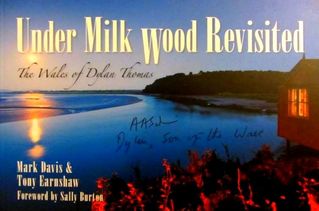
A first edition copy, published in softback, of Mark Davis and Tony Earnshaw's stunningly beautiful and delightfully packaged photographic book entitled, 'Under Milk Wood Revisited - The Wales of Dylan Thomas'.
This edition was published and printed by Amberley Publishing, based in Stroud, Gloucestershire in 2014.
This outstanding book, packed with stunning colour and black and white photographs of iconic locations relating to Dylan Thomas and Richard Burton is a celebration and in-depth analysis of the filming of Andrew Sinclair's 1972 Timon Film production of 'Under Milk Wood'.
The text, taken from the publisher's beautifully written cover notes, reads;
"Dylan Thomas was the self-styled 'bombastic adolescent provincial Bohemian', and whose wizardry with words ensured his dominion over poverty, alcoholism, self-destruction and, ultimately, a premature death. He is immortal.
From the window of his childhood via a voyage across the fishing boat-bobbing sea, he stored and sifted the episodes that nibbled at his imagination. Events, people, characters and places were intricately weaved into a glorious tapestry of religion, sex and death, which has become a timeless memory of Welsh whimsy that never actually existed and yet will live forever.
Like the tides that Dylan watched from his writing shed, perched high on the cliff top in Laugharne, Under Milk Wood - a 'Play for Voices' that became a spellbinding movie - has drawn millions of readers to make a pilgrimage to the nocturnal quiet of Llareggub. In his centenary year, this photographic book captures the iconic landscape that fired Dylan's passion for language. From Swansea's Cwmdonkin Park via the harbour at Fishguard to the Boat House overlooking the estuary at Laugharne, Under Milk Wood Revisited takes the reader on a journey into the magical associations with the past and the roots that held Dylan Thomas to Wales; the land of his fathers which drew his inspiration."
As well as a foreword by Sally Burton and an introduction by Andrew Sinclair himself, the chapters and photography in this delightful book include studies of the Swansea of Dylan Thomas's childhood, then and now, and Richard Burton's Taibach and Lower Fishguard, which was the location of the 1972 iconic film adaption of Dylan Thomas's 'Play for Voices'.
Sally Burton's beautiful and eloquently written foreword, in it's entirety, reads;
"Richard Burton must have been around thirteen when he realised the importance of financial independence. He found many ways of making a bit of extra cash and one of those was collecting old newspapers from his neighbours and taking them to the fish and chip shop for use as wrapping paper. With bundles of newspapers tucked under his arms, he would manage to read what he could. As Welsh was Richard's first language it was a way of extending his use and understanding of English. He was thrilled when he discovered a poem printed in one of the old papers and even more thrilled when he realised he understood its meaning; so began Richard's lifelong love and rich interpretation of poetry.
It was during his teenage years that he discovered Dylan Thomas and his work. He was to admire and cherish his memories of Dylan Thomas throughout his life. One thing Richard worried about was the fact that when Dylan asked him for a loan of £200 he simply did not have the cash to fulfill the request. Dylan went to New York and died. Richard wondered if had he managed to find the £200 Dylan's fate would have been different. Probably not, but it was enough to be of lingering concern to Richard.
Dylan Thomas did not have Welsh as a first language, he spoke English, but he did have the rich and playful adventure the Welsh have with the English language. 'Under Milk Wood', if it were to be translated into Welsh, would simply not be as funny as it is in English.
Richard admired Dylan Thomas greatly and was thrilled to work with him and to become his friend in the early '50's in London. It was Richard's idea of perfect bliss to spend a Sunday afternoon at the B.B.C. recording work for the Third Programme with a gaggle of eccentric actors. Richard would describe them as a 'melodrama of English actors'. Note that he describes them as 'English' actors. He and Dylan were different, they were Welsh, and they had the bond of being outsiders. Among the group - and Richard frequently referred to those days with abiding humour and affection - were Esme Percy, Andrew Cruickshank, Ernest Thesiger, Michael Hordern and Dylan Thomas. In his diaries Richard wrote;
"So there you are in my drab paradise of magnificent language for the speaking of which you were actually paid money, on a Sunday in Studio 8 of the B.B.C. Portland Place, the Sunday papers strewn hither and thither and much chat between the boys who matched story after story and, because the competition is so intense, no one person was able to hold the floor for too long even if Dylan was there, for Dylan - the most compelling talker I've ever met - was oddly constricted by these precise cold English actors with their impeccable accents."
After rehearsal they would break. Some went to the canteen but the drinking men would go to The George. They were ordered to be back at 6.30 p.m. for a run through. The red live transmission light went on at 8 p.m. sharp. The company of Dylan - who Richard described as an actor of exploding force - and the notable drinking with Dylan meant great times for the two of them and lots to remember and recall for Richard.
They were tremendous, rollicking good times but as Richard said, 'T'was the work itself that was the wonder.'
And part of that wonder was Dylan Thomas."
Also included in this edition, and published for the first time, is an interview conducted by Tony Earnshaw between himself , Andrew Sinclair and Sally Burton which took place in March of 2003.
Some of the photographs in this book are from Andrew Sinclair's personal archive, many not having been seen before, and production photographs taken on location in 1971 by Keith Hamshere.
This edition of 'Under Milk Wood Revisited' was issued with the ISBN 978-1-4456-0755-9.
This wonderful book has the lovely addition of having been personally signed to myself by the author, Tony Earnshaw and the director of the 1972 film version of 'Under Milk Wood', Andrew Sinclair, who has signed his name 'A. A. Sinclair',(Andrew Annandale), along with the words from 'The Mabinogion', 'Dylan, son of the wave.'
Once again, I have included this book in the Richard Burton Museum's ' Burton Books and Magazines' section as it relates more to the 1972 Andrew Sinclair film adaption rather than to Dylan Thomas's actual writing of the play.
This edition was published and printed by Amberley Publishing, based in Stroud, Gloucestershire in 2014.
This outstanding book, packed with stunning colour and black and white photographs of iconic locations relating to Dylan Thomas and Richard Burton is a celebration and in-depth analysis of the filming of Andrew Sinclair's 1972 Timon Film production of 'Under Milk Wood'.
The text, taken from the publisher's beautifully written cover notes, reads;
"Dylan Thomas was the self-styled 'bombastic adolescent provincial Bohemian', and whose wizardry with words ensured his dominion over poverty, alcoholism, self-destruction and, ultimately, a premature death. He is immortal.
From the window of his childhood via a voyage across the fishing boat-bobbing sea, he stored and sifted the episodes that nibbled at his imagination. Events, people, characters and places were intricately weaved into a glorious tapestry of religion, sex and death, which has become a timeless memory of Welsh whimsy that never actually existed and yet will live forever.
Like the tides that Dylan watched from his writing shed, perched high on the cliff top in Laugharne, Under Milk Wood - a 'Play for Voices' that became a spellbinding movie - has drawn millions of readers to make a pilgrimage to the nocturnal quiet of Llareggub. In his centenary year, this photographic book captures the iconic landscape that fired Dylan's passion for language. From Swansea's Cwmdonkin Park via the harbour at Fishguard to the Boat House overlooking the estuary at Laugharne, Under Milk Wood Revisited takes the reader on a journey into the magical associations with the past and the roots that held Dylan Thomas to Wales; the land of his fathers which drew his inspiration."
As well as a foreword by Sally Burton and an introduction by Andrew Sinclair himself, the chapters and photography in this delightful book include studies of the Swansea of Dylan Thomas's childhood, then and now, and Richard Burton's Taibach and Lower Fishguard, which was the location of the 1972 iconic film adaption of Dylan Thomas's 'Play for Voices'.
Sally Burton's beautiful and eloquently written foreword, in it's entirety, reads;
"Richard Burton must have been around thirteen when he realised the importance of financial independence. He found many ways of making a bit of extra cash and one of those was collecting old newspapers from his neighbours and taking them to the fish and chip shop for use as wrapping paper. With bundles of newspapers tucked under his arms, he would manage to read what he could. As Welsh was Richard's first language it was a way of extending his use and understanding of English. He was thrilled when he discovered a poem printed in one of the old papers and even more thrilled when he realised he understood its meaning; so began Richard's lifelong love and rich interpretation of poetry.
It was during his teenage years that he discovered Dylan Thomas and his work. He was to admire and cherish his memories of Dylan Thomas throughout his life. One thing Richard worried about was the fact that when Dylan asked him for a loan of £200 he simply did not have the cash to fulfill the request. Dylan went to New York and died. Richard wondered if had he managed to find the £200 Dylan's fate would have been different. Probably not, but it was enough to be of lingering concern to Richard.
Dylan Thomas did not have Welsh as a first language, he spoke English, but he did have the rich and playful adventure the Welsh have with the English language. 'Under Milk Wood', if it were to be translated into Welsh, would simply not be as funny as it is in English.
Richard admired Dylan Thomas greatly and was thrilled to work with him and to become his friend in the early '50's in London. It was Richard's idea of perfect bliss to spend a Sunday afternoon at the B.B.C. recording work for the Third Programme with a gaggle of eccentric actors. Richard would describe them as a 'melodrama of English actors'. Note that he describes them as 'English' actors. He and Dylan were different, they were Welsh, and they had the bond of being outsiders. Among the group - and Richard frequently referred to those days with abiding humour and affection - were Esme Percy, Andrew Cruickshank, Ernest Thesiger, Michael Hordern and Dylan Thomas. In his diaries Richard wrote;
"So there you are in my drab paradise of magnificent language for the speaking of which you were actually paid money, on a Sunday in Studio 8 of the B.B.C. Portland Place, the Sunday papers strewn hither and thither and much chat between the boys who matched story after story and, because the competition is so intense, no one person was able to hold the floor for too long even if Dylan was there, for Dylan - the most compelling talker I've ever met - was oddly constricted by these precise cold English actors with their impeccable accents."
After rehearsal they would break. Some went to the canteen but the drinking men would go to The George. They were ordered to be back at 6.30 p.m. for a run through. The red live transmission light went on at 8 p.m. sharp. The company of Dylan - who Richard described as an actor of exploding force - and the notable drinking with Dylan meant great times for the two of them and lots to remember and recall for Richard.
They were tremendous, rollicking good times but as Richard said, 'T'was the work itself that was the wonder.'
And part of that wonder was Dylan Thomas."
Also included in this edition, and published for the first time, is an interview conducted by Tony Earnshaw between himself , Andrew Sinclair and Sally Burton which took place in March of 2003.
Some of the photographs in this book are from Andrew Sinclair's personal archive, many not having been seen before, and production photographs taken on location in 1971 by Keith Hamshere.
This edition of 'Under Milk Wood Revisited' was issued with the ISBN 978-1-4456-0755-9.
This wonderful book has the lovely addition of having been personally signed to myself by the author, Tony Earnshaw and the director of the 1972 film version of 'Under Milk Wood', Andrew Sinclair, who has signed his name 'A. A. Sinclair',(Andrew Annandale), along with the words from 'The Mabinogion', 'Dylan, son of the wave.'
Once again, I have included this book in the Richard Burton Museum's ' Burton Books and Magazines' section as it relates more to the 1972 Andrew Sinclair film adaption rather than to Dylan Thomas's actual writing of the play.
The frontispiece for the Richard Burton Museum collection's first edition copy of the beautiful photographic book, 'Under Milk Wood Revisited' , signed and dedicated by the author, Tony Earnshaw.
Angela V. John, 'The Actor's Crucible'
Parthian Books, First Edition, 2015
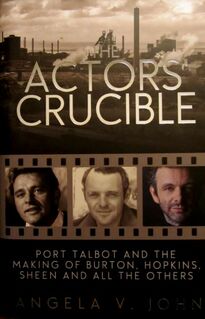
A fascinating, informative, well-researched and exceptionally well-written book which details the history of Port Talbot and the incredible amount of superb acting talent which has emerged from this small, 'ugly, lovely' Welsh industrial steel town.
This first edition of 'The Actor's Crucible' by Angela V. John was published in 2015 by Parthian Books which are based in Cardigan, Wales and printed by the Dinefwr Press, Llandybie.
This is a first edition copy published in hardback, complete with the original dust-jacket, which was published with the financial support of the Welsh Books Council.
This incredible book also has the added bonus of being illustrated with stunning and rare black and white and colour photographs.
The publishers' cover notes outline the reason for the books conception;
"Richard Burton, Anthony Hopkins and Michael Sheen count amongst the world's most renowned and gifted actors.Yet they have something else in common, they all come from the south Wales steel town of Port Talbot. What is it about this industrial community that has produced such superstars?
Angela V. John, who also hails from the town, explores the lives of these acting legends before they became famous. She presents their emergence as part of a rich culture and commitment to drama long embedded in the town's history. She reveals too an host of other famous Port Talbot faces, from early stars such as Ronald Lewis and Ivor Emmanuel to more recent performers like Rob Brydon and Di Botcher, along with a cluster of young actors starting to make their mark on London's Wet End stage, and on the big and small screen. Her account culminates in the spectacular three-day event of Easter 2011 when Michael Sheen resurrected Port Talbot's pride and hopes through the unforgettable theatrical experience of 'The Passion.'
This book puts centre-stage the shifting fortunes of a town, its actors and, crucially, its enablers - those unsung heroes who helped to nurture talent in schools, youth centres and youth theatre. Using extensive interviews, it provides a refreshing way of looking at the history of a community and a profession, as well as casting new and unexpected light on the backgrounds of its most famous stars."
Angela V. John is a published historian and biographer who was also originally from the small industrial town of Port Talbot. She has held the chair in History at the University of Greenwich for many years as well as holding the post of honorary professor at Swansea University.
Her previous works have included the award-winning, 'Coalmining Women' as well as a biography of the actress and suffragette, Elizabeth Robbins.
Angela V. John is also currently the vice-president of Llafur, The Welsh People's History Society.
Reviews of this outstanding historical work include;
"This is a brilliantly insightful and much needed study by one of Wales' leading historians using a range of sources including her own personal memories of Port Talbot and its stars." Hywel Francis, historian.
"This is an important work that deepens our sense of a changing Wales...nicely combining local with international and popular with scholarship." Peter Stead, author of 'Acting Wales' and 'Richard Burton: So Much, So Little'.
"Tremendous...it tells a fascinating and very important story and does so in a way that will be accessible to a very wide readership." Professor Chris Williams, editor of 'The Richard Burton Diaries'.
"Local knowledge is the foundation of this well-researched and very readable account. Richard Burton and Company are the stars but Angela John shows just how they came to attain that celestial state." Sally Roberts Jones, Port Talbot Historian.
The cover design for 'The Actor's Crucible' was designed by artist Robert Harries for Parthian Books.
This special presentation copy of 'The Actor's Crucible' was very kindly donated to The Richard Burton Museum by the author and Parthian Books prior to publication, a gift for which the Richard Burton Museum is extremely proud and grateful to have received.
This first edition of 'The Actor's Crucible' by Angela V. John was published in 2015 by Parthian Books which are based in Cardigan, Wales and printed by the Dinefwr Press, Llandybie.
This is a first edition copy published in hardback, complete with the original dust-jacket, which was published with the financial support of the Welsh Books Council.
This incredible book also has the added bonus of being illustrated with stunning and rare black and white and colour photographs.
The publishers' cover notes outline the reason for the books conception;
"Richard Burton, Anthony Hopkins and Michael Sheen count amongst the world's most renowned and gifted actors.Yet they have something else in common, they all come from the south Wales steel town of Port Talbot. What is it about this industrial community that has produced such superstars?
Angela V. John, who also hails from the town, explores the lives of these acting legends before they became famous. She presents their emergence as part of a rich culture and commitment to drama long embedded in the town's history. She reveals too an host of other famous Port Talbot faces, from early stars such as Ronald Lewis and Ivor Emmanuel to more recent performers like Rob Brydon and Di Botcher, along with a cluster of young actors starting to make their mark on London's Wet End stage, and on the big and small screen. Her account culminates in the spectacular three-day event of Easter 2011 when Michael Sheen resurrected Port Talbot's pride and hopes through the unforgettable theatrical experience of 'The Passion.'
This book puts centre-stage the shifting fortunes of a town, its actors and, crucially, its enablers - those unsung heroes who helped to nurture talent in schools, youth centres and youth theatre. Using extensive interviews, it provides a refreshing way of looking at the history of a community and a profession, as well as casting new and unexpected light on the backgrounds of its most famous stars."
Angela V. John is a published historian and biographer who was also originally from the small industrial town of Port Talbot. She has held the chair in History at the University of Greenwich for many years as well as holding the post of honorary professor at Swansea University.
Her previous works have included the award-winning, 'Coalmining Women' as well as a biography of the actress and suffragette, Elizabeth Robbins.
Angela V. John is also currently the vice-president of Llafur, The Welsh People's History Society.
Reviews of this outstanding historical work include;
"This is a brilliantly insightful and much needed study by one of Wales' leading historians using a range of sources including her own personal memories of Port Talbot and its stars." Hywel Francis, historian.
"This is an important work that deepens our sense of a changing Wales...nicely combining local with international and popular with scholarship." Peter Stead, author of 'Acting Wales' and 'Richard Burton: So Much, So Little'.
"Tremendous...it tells a fascinating and very important story and does so in a way that will be accessible to a very wide readership." Professor Chris Williams, editor of 'The Richard Burton Diaries'.
"Local knowledge is the foundation of this well-researched and very readable account. Richard Burton and Company are the stars but Angela John shows just how they came to attain that celestial state." Sally Roberts Jones, Port Talbot Historian.
The cover design for 'The Actor's Crucible' was designed by artist Robert Harries for Parthian Books.
This special presentation copy of 'The Actor's Crucible' was very kindly donated to The Richard Burton Museum by the author and Parthian Books prior to publication, a gift for which the Richard Burton Museum is extremely proud and grateful to have received.
A Selection Of Richard Burton Related Books, Magazines, Brochures, Articles and Ephemera
Emlyn Williams, 'Night Must Fall'
Victor Gollancz Limited, Signed Second Edition, 1935
Emlyn Williams (1905 - 1987), was an eminent Welsh dramatist, actor, film and theatre director who had a highly successful stage and screen career spanning nearly six decades.
Known mainly for the classic play and film, 'The Corn Is Green', Williams' s influence on, and encouragement of the young Richard Burton is undeniable.
Emlyn Williams' s work and support provided Richard Burton with many of his early 'breaks', and because of that they remained close friends until Richard Burton's untimely death in August 1984.
'Night Must Fall', a psychological play in three acts, was first published in July 1935 and was performed on stage for the very first time later that same year.
Two film versions were also made of the play, in 1937 and again in 1964, starring Robert Montgomery and Albert Finney respectively.
Richard Burton was cast in the role of Dan, the sinister Welsh footman, in the radio version recorded for the B.B.C. Home Service on the 13th of January, 1954 and which formed part of a B.B.C. radio drama series entitled, 'Stars And Their Choices'.
This copy of the play is a second edition copy dating from February 1936 and has been clearly signed by Emlyn Williams on the opening page and dated by Williams as being signed on June the 20th, 1936.
This rare edition was published by Victor Gollancz of Covent Garden, London and was printed by the Camelot Press Limited, and is complete with the original dust-jacket.
Known mainly for the classic play and film, 'The Corn Is Green', Williams' s influence on, and encouragement of the young Richard Burton is undeniable.
Emlyn Williams' s work and support provided Richard Burton with many of his early 'breaks', and because of that they remained close friends until Richard Burton's untimely death in August 1984.
'Night Must Fall', a psychological play in three acts, was first published in July 1935 and was performed on stage for the very first time later that same year.
Two film versions were also made of the play, in 1937 and again in 1964, starring Robert Montgomery and Albert Finney respectively.
Richard Burton was cast in the role of Dan, the sinister Welsh footman, in the radio version recorded for the B.B.C. Home Service on the 13th of January, 1954 and which formed part of a B.B.C. radio drama series entitled, 'Stars And Their Choices'.
This copy of the play is a second edition copy dating from February 1936 and has been clearly signed by Emlyn Williams on the opening page and dated by Williams as being signed on June the 20th, 1936.
This rare edition was published by Victor Gollancz of Covent Garden, London and was printed by the Camelot Press Limited, and is complete with the original dust-jacket.
Emlyn Williams was a man who was to provide many 'firsts' in relation to the early career of Richard Burton, the most famous being Richard Burton's screen debut in the London Films production of 'The Last Days Of Dolwyn'.The film was written, starred and directed by Emlyn Williams himself and the part of Gareth was especially written by Emlyn Williams with Richard Burton in mind for the role.
Richard Burton's first ever radio broadcast was also in an Emlyn Williams production, this being 'The Corn Is Green', which was broadcast on the B.B.C. Home Service on the 27th of January, 1945 as part of the B.B.C.'s 'Saturday Night Theatre' season and which was directed by Philip Burton.
Richard Burton's first performance to a paying public was in the Emlyn Williams play 'The Druid's Rest', which opened at The Royal Court Theatre, Liverpool on the 22nd of November, 1943.
Emlyn Williams was also instrumental in the introduction of Richard Burton to his first wife Sybil on the set of 'The Last Days Of Dolwyn'. He was also godfather to Richard Burton's eldest daughter Kate, and gave a very moving reading at Richard Burton's London Memorial Service which took place in London in 1984.
Richard Burton's first ever radio broadcast was also in an Emlyn Williams production, this being 'The Corn Is Green', which was broadcast on the B.B.C. Home Service on the 27th of January, 1945 as part of the B.B.C.'s 'Saturday Night Theatre' season and which was directed by Philip Burton.
Richard Burton's first performance to a paying public was in the Emlyn Williams play 'The Druid's Rest', which opened at The Royal Court Theatre, Liverpool on the 22nd of November, 1943.
Emlyn Williams was also instrumental in the introduction of Richard Burton to his first wife Sybil on the set of 'The Last Days Of Dolwyn'. He was also godfather to Richard Burton's eldest daughter Kate, and gave a very moving reading at Richard Burton's London Memorial Service which took place in London in 1984.
Emlyn Williams, 'The Druid's Rest'
William Heinemann Limited, First Edition, 1944

A first edition copy of the Emlyn Williams three act comedy play, 'The Druid's Rest'.
This edition was published by William Heinemann Limited of London and was printed by the Windmill Press based at Kingswood, Surrey.
This first edition copy of 'The Druid's Rest' was published in 1944 and at the time of publication cost six shillings.
This edition was published in yellow boards with black lettering on the spine and is complete with the original dust-jacket.
The cast list for the first performance of the play appears on the front end page. The play opened on January the 26th, 1944 at the St Martin's Theatre, London and was directed by Emlyn Williams himself.
This edition was published by William Heinemann Limited of London and was printed by the Windmill Press based at Kingswood, Surrey.
This first edition copy of 'The Druid's Rest' was published in 1944 and at the time of publication cost six shillings.
This edition was published in yellow boards with black lettering on the spine and is complete with the original dust-jacket.
The cast list for the first performance of the play appears on the front end page. The play opened on January the 26th, 1944 at the St Martin's Theatre, London and was directed by Emlyn Williams himself.
The cast list for the first performance of 'The Druid's Rest' which opened at The St. Martin's Theatre, London in January, 1944
Christopher Fry, 'The Lady's Not For Burning'
The Oxford University Press, Second Edition, 1949
Christopher Fry (1907-2005), was a Bristol born, Award-winning dramatist, poet and academic who was probably best known for his outstanding verse drama entitled, 'The Lady's Not For Burning', which was written in 1948.
A major force in British theatre in the 1940's and 1950's, Christopher Fry's career began as a schoolteacher in Surrey until, in 1932, he left teaching to set up the 'Tunbridge Wells Repertory Players' where he was given the opportunity to direct the English premiere of George Bernard Shaw's, 'Village Wooing' in 1934.
In 1938 Christopher Fry was commissioned by the vicar of Steyning, West Sussex, to write a play based on the story of Saint Cuthman. This was to become 'The Boy With A Cart' , a play for which Richard Burton would receive much critical acclaim in 1950.
Christopher Fry's most famous work however has to be, 'The Lady's Not For Burning', which was commissioned by the manager of the Arts Theatre of London, Alec Clunes. The play was first performed, with Richard Burton in his first major role, at the Globe Theatre in London in 1949. This copy of the play is a second edition, seventh impression, which was published by The Oxford University Press, London in 1952 and features a full cast list from the 1949 Globe Theatre production, directed by John Gielgud. This copy is complete with the original dust-jacket.
Contemporary reviews, which the publishers have included on the dust-jacket of this second edition, include;
"Mr. Christopher Fry is without doubt one of the brightest hopes in the British theatre. A poet and a wit, he is also that even rarer creature, a man of rich and abundant fancy with an ironic sense of humour...'The Lady's Not For Burning' has phrases Ben Jonson would have nobbled gratefully and as many ripe images as would last most modern dramatists a lifetime". Punch.
"Christopher Fry has brought back into the theatre all the wealth of our literary heritage". The Stage.
"From the moment the curtain rises on 'The Lady's Not For Burning', we are launched into a sea of dazzling verbal invention which never for a moment flags. Nothing is so refreshing in these days as to find that we are not, for a change, savouring a few rare fine drops of squeezed juice; and Mr. Fry gives us the confidence that he can let down his bucket where he wishes and bring it up brimming". The New Statesman.
A review of the play, written contemporary to the staging of 'The Lady's Not For Burning' at the Globe Theatre in 1949 reads;
"Mr. Christopher Fry, in an amusing forward to this remarkable play, tells us that we need not be particularly worried that he breaks off a sentence before it reaches the edge of the page and continues it on the next line with a capital letter. 'That,' he says, 'is no one's business but my own, and every man is free to think of the writing as verse, or sliced prose, or as a bastard offspring of the two'. It is, as a fact, poetry of a very high order.
Mr. Fry knows how to paint pictures with words, and the pictures he paints glow with colour and life. There is a touch of rare Ben Jonson; and more than a touch of Shakespeare, about his writing, and in the closing scene, when the returned and disillusioned soldier, falling in love with a girl falsely accused of witchcraft, comes to grips once more with realities, he touches the stars."
A major force in British theatre in the 1940's and 1950's, Christopher Fry's career began as a schoolteacher in Surrey until, in 1932, he left teaching to set up the 'Tunbridge Wells Repertory Players' where he was given the opportunity to direct the English premiere of George Bernard Shaw's, 'Village Wooing' in 1934.
In 1938 Christopher Fry was commissioned by the vicar of Steyning, West Sussex, to write a play based on the story of Saint Cuthman. This was to become 'The Boy With A Cart' , a play for which Richard Burton would receive much critical acclaim in 1950.
Christopher Fry's most famous work however has to be, 'The Lady's Not For Burning', which was commissioned by the manager of the Arts Theatre of London, Alec Clunes. The play was first performed, with Richard Burton in his first major role, at the Globe Theatre in London in 1949. This copy of the play is a second edition, seventh impression, which was published by The Oxford University Press, London in 1952 and features a full cast list from the 1949 Globe Theatre production, directed by John Gielgud. This copy is complete with the original dust-jacket.
Contemporary reviews, which the publishers have included on the dust-jacket of this second edition, include;
"Mr. Christopher Fry is without doubt one of the brightest hopes in the British theatre. A poet and a wit, he is also that even rarer creature, a man of rich and abundant fancy with an ironic sense of humour...'The Lady's Not For Burning' has phrases Ben Jonson would have nobbled gratefully and as many ripe images as would last most modern dramatists a lifetime". Punch.
"Christopher Fry has brought back into the theatre all the wealth of our literary heritage". The Stage.
"From the moment the curtain rises on 'The Lady's Not For Burning', we are launched into a sea of dazzling verbal invention which never for a moment flags. Nothing is so refreshing in these days as to find that we are not, for a change, savouring a few rare fine drops of squeezed juice; and Mr. Fry gives us the confidence that he can let down his bucket where he wishes and bring it up brimming". The New Statesman.
A review of the play, written contemporary to the staging of 'The Lady's Not For Burning' at the Globe Theatre in 1949 reads;
"Mr. Christopher Fry, in an amusing forward to this remarkable play, tells us that we need not be particularly worried that he breaks off a sentence before it reaches the edge of the page and continues it on the next line with a capital letter. 'That,' he says, 'is no one's business but my own, and every man is free to think of the writing as verse, or sliced prose, or as a bastard offspring of the two'. It is, as a fact, poetry of a very high order.
Mr. Fry knows how to paint pictures with words, and the pictures he paints glow with colour and life. There is a touch of rare Ben Jonson; and more than a touch of Shakespeare, about his writing, and in the closing scene, when the returned and disillusioned soldier, falling in love with a girl falsely accused of witchcraft, comes to grips once more with realities, he touches the stars."
J. C. Trewin, 'John Neville'
Barrie & Rockliff, Signed First Edition, 1961
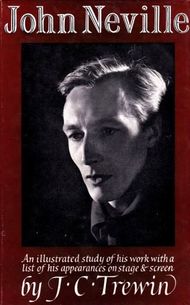
A first edition copy of J. C.Trewin's in-depth study of the stage and screen career of actor John Neville.
This edition was published in 1961 by Barrie and Rockliff, based in Clement's Inn, London and was printed by Clarke, Doble and Brendon Limited, Cattedown, Plymouth and is complete with the original dust-jacket.
This biography was issued as part of the 'Theatre World Monographs' series of books and was edited by Frances Stephens with the assistance of consultant and picture editors, Raymond Mander and Joe Mitchenson.
This copy is illustrated with black and white photographs, some which feature Richard Burton and John Neville, captured by renowned theatrical photographer Angus McBean.
The original price of this edition on publication was twenty-one shillings.
The cover notes for this highly interesting work, read;
"John Neville became a leading English classical actor during nearly a decade with the Old Vic organisation, first in London and later during the long and famous Folio sequence in London. He has done, and will do, much besides Shakespeare; but his reputation has been made in Hamlet, Richard the Second, Mark Anthony, Hotspur, Angelo, Henry V, and a host of other parts from Sir Andrew to Pistol. Critics have acclaimed him on the Continent and in North America; a young man very much of his period, who was a naval signalman during the Pacific War, and who, with his remarkable voice and presence, has developed into one of our major Shakespearians. This book is an expert survey of his career and his opinions. It is the tale of a young man 'with the face of a medieval saint' who has sung and danced in a musical play from Montmartre; of a Hamlet who admires bongo drumming; an Othello who detests the pride, pomp and circumstance of glorious war: a speaker of lyrics and elegiac verse who likes laughter; a leading actor who prefers to work in a team - always a dedicated m,an of the theatre."
This first edition copy has the lovely addition of having been personally signed by John Neville himself, a signing which took place at the Nottingham Playhouse on October the 8th 1965 during the run of Richard II in which John Neville was performing in the title role.
Some extra pieces of John Neville ephemera were also included with the purchase of this item, contemporary newspaper theatrical reviews of Richard II and an original photograph of John Neville portraying the Shakespearean King.
The writer, drama critic and journalist John Courtenay Trewin was born in Plymouth in 1908. After an education at Plymouth College he commenced on a long and illustrious career in journalism beginning as a junior reporter on the Western Independent in 1926.
Following a move to London in 1932 he was employed by, firstly, the Morning Post followed by The Observer in 1936 where he would remain for over sixty years as drama critic. Trewin was also a regular contributor to publications such as Punch, The Listener, The Lady, John O' London's Weekly and The Illustrated London News.
J. C. Trewin was awarded the Order Of the British Empire in 1981 for services to theatre. The Critic's Circle named an award after Trewin and his wife Wendy, who was also a critic and writer, an award which is presented annually for Best Shakespearean Performance. The recipient of the 2016 Trewin Award was Dame Judi Dench.
J. C. Trewin died on the 16th of February, 1990.
This edition was published in 1961 by Barrie and Rockliff, based in Clement's Inn, London and was printed by Clarke, Doble and Brendon Limited, Cattedown, Plymouth and is complete with the original dust-jacket.
This biography was issued as part of the 'Theatre World Monographs' series of books and was edited by Frances Stephens with the assistance of consultant and picture editors, Raymond Mander and Joe Mitchenson.
This copy is illustrated with black and white photographs, some which feature Richard Burton and John Neville, captured by renowned theatrical photographer Angus McBean.
The original price of this edition on publication was twenty-one shillings.
The cover notes for this highly interesting work, read;
"John Neville became a leading English classical actor during nearly a decade with the Old Vic organisation, first in London and later during the long and famous Folio sequence in London. He has done, and will do, much besides Shakespeare; but his reputation has been made in Hamlet, Richard the Second, Mark Anthony, Hotspur, Angelo, Henry V, and a host of other parts from Sir Andrew to Pistol. Critics have acclaimed him on the Continent and in North America; a young man very much of his period, who was a naval signalman during the Pacific War, and who, with his remarkable voice and presence, has developed into one of our major Shakespearians. This book is an expert survey of his career and his opinions. It is the tale of a young man 'with the face of a medieval saint' who has sung and danced in a musical play from Montmartre; of a Hamlet who admires bongo drumming; an Othello who detests the pride, pomp and circumstance of glorious war: a speaker of lyrics and elegiac verse who likes laughter; a leading actor who prefers to work in a team - always a dedicated m,an of the theatre."
This first edition copy has the lovely addition of having been personally signed by John Neville himself, a signing which took place at the Nottingham Playhouse on October the 8th 1965 during the run of Richard II in which John Neville was performing in the title role.
Some extra pieces of John Neville ephemera were also included with the purchase of this item, contemporary newspaper theatrical reviews of Richard II and an original photograph of John Neville portraying the Shakespearean King.
The writer, drama critic and journalist John Courtenay Trewin was born in Plymouth in 1908. After an education at Plymouth College he commenced on a long and illustrious career in journalism beginning as a junior reporter on the Western Independent in 1926.
Following a move to London in 1932 he was employed by, firstly, the Morning Post followed by The Observer in 1936 where he would remain for over sixty years as drama critic. Trewin was also a regular contributor to publications such as Punch, The Listener, The Lady, John O' London's Weekly and The Illustrated London News.
J. C. Trewin was awarded the Order Of the British Empire in 1981 for services to theatre. The Critic's Circle named an award after Trewin and his wife Wendy, who was also a critic and writer, an award which is presented annually for Best Shakespearean Performance. The recipient of the 2016 Trewin Award was Dame Judi Dench.
J. C. Trewin died on the 16th of February, 1990.
John Neville's autograph as it appears on the title page of the J. C. Trewin biography which was written in 1961.
'Theatre World' Magazine, April 1944
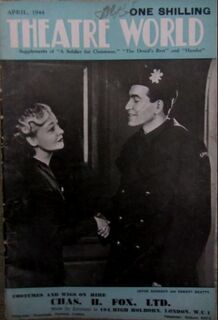
Possibly the earliest British theatrical publication to feature an article relating to Richard Burton's theatre career within its pages is this edition of the British monthly magazine, 'Theatre World' dating from April, 1944.
Incorporated inside this issue is a four-page article relating to the production of the Emlyn Williams play, 'The Druid's Rest' which at the time of the magazines publication was enjoying a successful run at the St. Martin's Theatre, Shaftesbury Avenue, London.
The article, basically a synopsis of the play, is accompanied by thirteen photographs of staged scenes from the production, seven of which feature a very young-looking Richard Burton. The photographs were taken by noted theatrical photographer, John Vickers.
Other articles which feature in this edition relate to the production of 'A Soldier for Christmas' and the Old Vic production of 'Hamlet' with Robert Helpmann in the title role.
This edition of 'Theatre World' was published by Practical Press based in Fleet Street, London and was printed by The Lewes Press, (Wightman and Company), Lewes. At the time of publication, in April 1944, the magazine cost one shilling.
Incorporated inside this issue is a four-page article relating to the production of the Emlyn Williams play, 'The Druid's Rest' which at the time of the magazines publication was enjoying a successful run at the St. Martin's Theatre, Shaftesbury Avenue, London.
The article, basically a synopsis of the play, is accompanied by thirteen photographs of staged scenes from the production, seven of which feature a very young-looking Richard Burton. The photographs were taken by noted theatrical photographer, John Vickers.
Other articles which feature in this edition relate to the production of 'A Soldier for Christmas' and the Old Vic production of 'Hamlet' with Robert Helpmann in the title role.
This edition of 'Theatre World' was published by Practical Press based in Fleet Street, London and was printed by The Lewes Press, (Wightman and Company), Lewes. At the time of publication, in April 1944, the magazine cost one shilling.
The article relating to the H. M. Tennent Limited production of 'The Druid's Rest' which features in the April, 1944 edition of 'Theatre World'.
'Theatre World' Magazine, July 1949
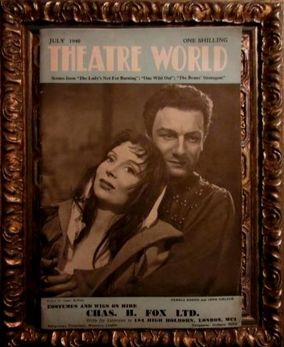
A copy of the vintage 'Arts' magazine, 'Theatre World' dating from July, 1949 which features a cover portrait of John Gielgud and Pamela Brown, staged and captured by theatrical photographer Angus McBean, promoting the production of Christopher Fry's 'The Lady's Not For Burning' which was being performed at the Globe Theatre.
This edition features an in-depth article relating to the production of the play, with black and white photographs by Angus McBean, many which feature Richard Burton, and an interview with the actress Pamela Brown.
This copy of 'Theatre World' is issue number two hundred and ninety-four of volume forty-five.
The editorial office of 'Theatre World' magazine, at the time of this publication, was based in Salisbury Square, Fleet Street, London and this issue was printed by Wightman and Company Limited, The Lewes Press, based in Friar's Walk, Lewes, East Sussex.
The original price of this publication at the time of publishing was one shilling.
This edition features an in-depth article relating to the production of the play, with black and white photographs by Angus McBean, many which feature Richard Burton, and an interview with the actress Pamela Brown.
This copy of 'Theatre World' is issue number two hundred and ninety-four of volume forty-five.
The editorial office of 'Theatre World' magazine, at the time of this publication, was based in Salisbury Square, Fleet Street, London and this issue was printed by Wightman and Company Limited, The Lewes Press, based in Friar's Walk, Lewes, East Sussex.
The original price of this publication at the time of publishing was one shilling.
The 'Lady's Not For Burning' article which features in the July, 1949 issue of 'Theatre World' magazine.
'Picture Post' Magazine, August 1951
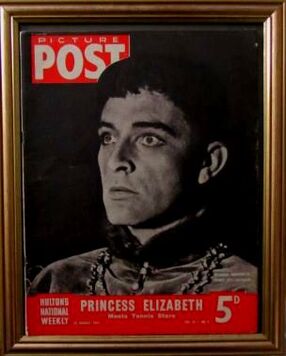
A copy of the weekly British photo-journalistic magazine, 'Picture Post' dating from the 25th of August, 1951.
This edition of the popular current affairs magazine features a powerful photograph of Richard Burton on the front cover in the role of Prince Hal in Shakespeare's 'Henry IV' as performed at the Shakespeare Memorial Theatre, Stratford-Upon-Avon.
Included in this edition is a beautifully written article relating to the 1951 Cycle of Historical Plays as performed at Stratford, illustrated with black and white photographs of Richard Burton and cast members, captured by photographer Maurice Ambler.
An extract from the article, written by Picture Post journalist Philip Hope-Wallace, reads;
'Keep your eye on Richard Burton. You won't find that difficult. This twenty-five-year-old Welshman with the wide strong gaze is not a great actor yet. He may never be. But he has something which no other actor is ever truly great without; though as yet it's a God-given gift, not fully exploited. He is, in a striking degree, visible. (Not, like some of our cleverest actors, nearly invisible at fifty feet). Your eye picks him out and refuses to leave him. You can call it magnetism, but it may be less a matter of personality than of proportion, lucky inches. He's taller off the stage than he looks on, rather dwarfed by an exceptionally tall company (Redgrave for instance). But he gives an impression of solid strength, a firm-standing figure who has yet to learn to move to the best advantage - he is quite frank about how much he still has to learn - but a figure who can stand (blessedly) still, and yet hold your eye.
In poetic drama where so many young leads tend to be restless, not to say waspish, this down-to.earth, sturdy calm is immensely impressive. The set of the eyes, grey and wide apart, has much to do with it too; and the set of the head and its modelling which recalls (and so much else does) the young Olivier. Also - why underrate it? - there's the sex appeal; the scene of his wooing of the French princess has great charm of the kind you can't invent. All through, though he's better in the earlier part, this sturdy, likeable young actor is a hearth on which imagination kindles and burns.'
This copy of 'Picture Post' was published by the Hulton Press and was printed by Sun Printers Limited based in London and Watford, Hertfordshire.
This edition of the popular current affairs magazine features a powerful photograph of Richard Burton on the front cover in the role of Prince Hal in Shakespeare's 'Henry IV' as performed at the Shakespeare Memorial Theatre, Stratford-Upon-Avon.
Included in this edition is a beautifully written article relating to the 1951 Cycle of Historical Plays as performed at Stratford, illustrated with black and white photographs of Richard Burton and cast members, captured by photographer Maurice Ambler.
An extract from the article, written by Picture Post journalist Philip Hope-Wallace, reads;
'Keep your eye on Richard Burton. You won't find that difficult. This twenty-five-year-old Welshman with the wide strong gaze is not a great actor yet. He may never be. But he has something which no other actor is ever truly great without; though as yet it's a God-given gift, not fully exploited. He is, in a striking degree, visible. (Not, like some of our cleverest actors, nearly invisible at fifty feet). Your eye picks him out and refuses to leave him. You can call it magnetism, but it may be less a matter of personality than of proportion, lucky inches. He's taller off the stage than he looks on, rather dwarfed by an exceptionally tall company (Redgrave for instance). But he gives an impression of solid strength, a firm-standing figure who has yet to learn to move to the best advantage - he is quite frank about how much he still has to learn - but a figure who can stand (blessedly) still, and yet hold your eye.
In poetic drama where so many young leads tend to be restless, not to say waspish, this down-to.earth, sturdy calm is immensely impressive. The set of the eyes, grey and wide apart, has much to do with it too; and the set of the head and its modelling which recalls (and so much else does) the young Olivier. Also - why underrate it? - there's the sex appeal; the scene of his wooing of the French princess has great charm of the kind you can't invent. All through, though he's better in the earlier part, this sturdy, likeable young actor is a hearth on which imagination kindles and burns.'
This copy of 'Picture Post' was published by the Hulton Press and was printed by Sun Printers Limited based in London and Watford, Hertfordshire.
The article relating to Richard Burton's role as Prince Hal at the Shakespeare Memorial Theatre as it appears in the 1951 issue of 'Picture Post'.
'Picturegoer' Magazine, February 1953

A copy of the British weekly film magazine, 'Picturegoer', dating from the week ending February the 28th, 1953.
The magazine features a striking cover portrait of Richard Burton in the role of Philip Ashley, taken from the Twentieth Century Fox production of, 'My Cousin Rachel', the film adaption of Daphne du Maurier's best-selling novel, which co-starred Olivia de Havilland, Audrey Dalton and Ronald Squire.
The magazine also features a two-page article relating to the film entitled, 'The Mystery Of Rachel', written by Denis Myers of 'Picturegoer', which delves into the many mysterious questions surrounding this 1950's melodrama and which also incorporates many still images from this marvellous film.
Also featured in this issue of 'Picturegoer' is a half-page advertisment for the film.
This copy of 'Picturegoer' was published and printed by the Odhams Press Limited based in Watford, London and was published weekly every Thursday and at the time of this issues publication was priced at three and a half pence.
'Picturegoer' was a British weekly film magazine which was first launched in the January of 1921, the advent of British film. Focusing on contemporary film, rising actors and Hollywood, the magazine enjoyed a large circulation rivaling many contemporary film magazines of the time.
Initially published once a month until 1925, it disappeared from magazine stands for a few years until it re-emerged in a weekly format in 1931, the era in which film was becoming more popular due to the advent of sound.
The magazine's success was mainly due to the fact that it was also sold in cinemas, and featured the major stars of the day appearing on the big screen in front of the magazine buying public. Unfortunately the major cinemas noticed this and began producing magazines of their own to rival 'Picturegoer', Rank, Odeon and British Associated Cinemas all began marketing their own magazines, produced to be sold in their respective cinemas. Sadly, Picturegoer', in retaliation, became more focused on Hollywood and the American stars of the day, becoming more interested in Hollywood scandal and gossip, rather than the actual films of the day.
'Picturegoer', in a last ditch attempt to remain popular merged with the British pop music magazine, 'Disc Date'. However the 'Picturegoer' side of this collaboration was dropped shortly afterwards to enable the magazine to devote itself totally to pop music. The last edition of 'Picturegoer' to be issued in the format as shown above was on the 23rd of April, 1960.
The magazine features a striking cover portrait of Richard Burton in the role of Philip Ashley, taken from the Twentieth Century Fox production of, 'My Cousin Rachel', the film adaption of Daphne du Maurier's best-selling novel, which co-starred Olivia de Havilland, Audrey Dalton and Ronald Squire.
The magazine also features a two-page article relating to the film entitled, 'The Mystery Of Rachel', written by Denis Myers of 'Picturegoer', which delves into the many mysterious questions surrounding this 1950's melodrama and which also incorporates many still images from this marvellous film.
Also featured in this issue of 'Picturegoer' is a half-page advertisment for the film.
This copy of 'Picturegoer' was published and printed by the Odhams Press Limited based in Watford, London and was published weekly every Thursday and at the time of this issues publication was priced at three and a half pence.
'Picturegoer' was a British weekly film magazine which was first launched in the January of 1921, the advent of British film. Focusing on contemporary film, rising actors and Hollywood, the magazine enjoyed a large circulation rivaling many contemporary film magazines of the time.
Initially published once a month until 1925, it disappeared from magazine stands for a few years until it re-emerged in a weekly format in 1931, the era in which film was becoming more popular due to the advent of sound.
The magazine's success was mainly due to the fact that it was also sold in cinemas, and featured the major stars of the day appearing on the big screen in front of the magazine buying public. Unfortunately the major cinemas noticed this and began producing magazines of their own to rival 'Picturegoer', Rank, Odeon and British Associated Cinemas all began marketing their own magazines, produced to be sold in their respective cinemas. Sadly, Picturegoer', in retaliation, became more focused on Hollywood and the American stars of the day, becoming more interested in Hollywood scandal and gossip, rather than the actual films of the day.
'Picturegoer', in a last ditch attempt to remain popular merged with the British pop music magazine, 'Disc Date'. However the 'Picturegoer' side of this collaboration was dropped shortly afterwards to enable the magazine to devote itself totally to pop music. The last edition of 'Picturegoer' to be issued in the format as shown above was on the 23rd of April, 1960.
The Richard Burton article entitled, 'The Mystery Of Rachel' which features in this February, 1953 issue of 'Picturegoer'.
'Picture Show and Film Pictorial' February 1953
A lovely copy of the February 28th, 1953 edition of 'Picture Show and Film Pictorial' magazine, featuring a stunning cover portrait of Richard Burton and Olivia de Havilland promoting the Twentieth Century Fox powerful melodrama, 'My Cousin Rachel'.
The magazine features a full-page article relating to the film, incorporating six black and white still images from the film and a synopsis of the story.
This copy of 'Picture Show and Film Pictorial' was printed and published by The Amalgamated Press Limited, Fleetway House, London in 1953 and was issue number 1561. At the time of publication the magazine cost three pence.
The magazine features a full-page article relating to the film, incorporating six black and white still images from the film and a synopsis of the story.
This copy of 'Picture Show and Film Pictorial' was printed and published by The Amalgamated Press Limited, Fleetway House, London in 1953 and was issue number 1561. At the time of publication the magazine cost three pence.
'Picturegoer Film Weekly' Magazine, November 1953
An exceptionally nice copy of a vintage 'Picturegoer', the National Film Weekly magazine. This copy dates from the week ending the 14th of November, 1953.
The cover star for this edition was the Academy-award winning American actress, Jeanne Crain, who was writing a series of articles especially for 'Picturegoer' focusing on a holiday diary for her first trip outside of the United States.
Further articles which appear in this issue pf 'Picturegoer' include features on the iconic love scene in 'From Here To Eternity' between Burt Lancaster and Deborah Kerr, Clark Gable and his latest romance and articles relating to such celebrities as Cyd Charisse, David Niven and the 'Who's Who' of British Film and Television for 1953.
Richard Burton appears in this issue in a double-page, centre-spread pin-up, in a very striking pose promoting the Twentieth Century Fox production of 'The Robe'. The caption which accompanies the image reads;
'This is how Richard Burton appears in 'The Robe', the first full-length Cinemascope feature. 'The Robe' also stars Jean Simmons and Victor Mature and features Betta St. John. It opens in the West End next week.'
This issue of 'Picturegoer' was published and printed by the Odhams Press Limited, based in Watford.
The cover star for this edition was the Academy-award winning American actress, Jeanne Crain, who was writing a series of articles especially for 'Picturegoer' focusing on a holiday diary for her first trip outside of the United States.
Further articles which appear in this issue pf 'Picturegoer' include features on the iconic love scene in 'From Here To Eternity' between Burt Lancaster and Deborah Kerr, Clark Gable and his latest romance and articles relating to such celebrities as Cyd Charisse, David Niven and the 'Who's Who' of British Film and Television for 1953.
Richard Burton appears in this issue in a double-page, centre-spread pin-up, in a very striking pose promoting the Twentieth Century Fox production of 'The Robe'. The caption which accompanies the image reads;
'This is how Richard Burton appears in 'The Robe', the first full-length Cinemascope feature. 'The Robe' also stars Jean Simmons and Victor Mature and features Betta St. John. It opens in the West End next week.'
This issue of 'Picturegoer' was published and printed by the Odhams Press Limited, based in Watford.
'Plays and Players' Magazine, January 1954
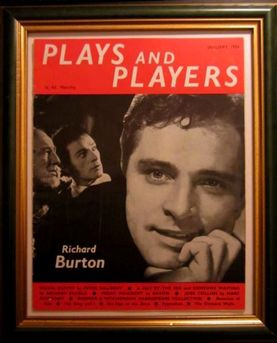
An early and original copy of the British theatre magazine, 'Plays and Players', dating from January, 1954, which features a stunning Angus McBean cover portrait of Richard Burton.
The magazine includes an article on the historic and highly successful Old Vic production of William Shakespeare's 'Hamlet', with Richard Burton cast in the lead role.
This edition was issue number four of volume one and was published by Hansom Books Limited, Lower Belgrave Street, London.
Other features included in this issue include articles on Martita Hunt, Sybil Thorndike in 'The Vicar's Daughter', Shakespeare - Past and Present, a four-page article relating to John Gielgud and Ralph Richardson's performances in the play, 'All at Sea' including photographs by Angus McBean, the Bristol Old Vic and a special feature on John Neville.
'Plays and Players' was published monthly and at the time of this issue cost one shilling and sixpence.
The back cover of this issue features a portrait of Sybil Thorndike.
The magazine includes an article on the historic and highly successful Old Vic production of William Shakespeare's 'Hamlet', with Richard Burton cast in the lead role.
This edition was issue number four of volume one and was published by Hansom Books Limited, Lower Belgrave Street, London.
Other features included in this issue include articles on Martita Hunt, Sybil Thorndike in 'The Vicar's Daughter', Shakespeare - Past and Present, a four-page article relating to John Gielgud and Ralph Richardson's performances in the play, 'All at Sea' including photographs by Angus McBean, the Bristol Old Vic and a special feature on John Neville.
'Plays and Players' was published monthly and at the time of this issue cost one shilling and sixpence.
The back cover of this issue features a portrait of Sybil Thorndike.
'Radio Times' Richard Burton Cover, January 1954
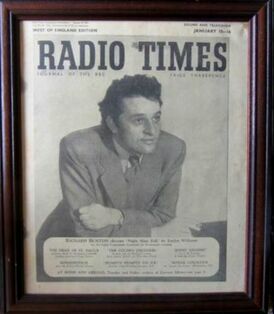
Richard Burton's first appearance on the cover of the British television and radio listings magazine, 'Radio Times'.
This copy is the West of England edition, covering the week of January the 10th - 16th, and was originally published on January the 8th, 1954.
Richard Burton was presenting a production of Emlyn Williams' play, 'Night Must Fall' as part of a series of programmes for the B.B.C. Light Programme entitled, 'Stars And Their Choices'.
Richard Burton was cast in the role of Danny, the sinister Welsh footman, alongside Olive Gregg, Richard Pearson and Joan Sanderson.
This B.B.C. production of 'Night Must Fall' was adapted for broadcasting by Peggy Wells and produced by Ayton Whitaker.
This original copy of the 'Radio Times' is complete and was issued by B.B.C. Publications, based in Marylebone, London.
More information relating to Richard Burton's performance in 'Night Must Fall' as well as information on the original play, can be found on the 'Burton Books and Magazines' and 'Burton At The BBC' pages of this website.
This copy is the West of England edition, covering the week of January the 10th - 16th, and was originally published on January the 8th, 1954.
Richard Burton was presenting a production of Emlyn Williams' play, 'Night Must Fall' as part of a series of programmes for the B.B.C. Light Programme entitled, 'Stars And Their Choices'.
Richard Burton was cast in the role of Danny, the sinister Welsh footman, alongside Olive Gregg, Richard Pearson and Joan Sanderson.
This B.B.C. production of 'Night Must Fall' was adapted for broadcasting by Peggy Wells and produced by Ayton Whitaker.
This original copy of the 'Radio Times' is complete and was issued by B.B.C. Publications, based in Marylebone, London.
More information relating to Richard Burton's performance in 'Night Must Fall' as well as information on the original play, can be found on the 'Burton Books and Magazines' and 'Burton At The BBC' pages of this website.
'Films and Filming' Magazine, May 1955
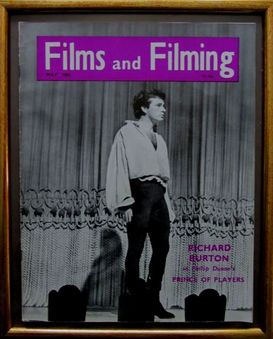
A copy of the British film magazine, 'Films and Filming', dating from May, 1955, which features a cover portrait of Richard Burton taken from the Philip Dunne / Twentieth Century Fox production of the factual melodrama, 'Prince Of Players'.
The related article entitled 'Prince From Wales', was written by Peter Brinson and assesses Richard Burton's performance in the film and discusses the professional training which made his screen success possible. The article features two still images from 'The Prince Of Players' and also a portrait of a young Richard Burton from his screen debut in 'The Last Days Of Dolwyn'.
The magazine also features an advert for the theatre magazine, 'Plays And Players' using Richard Burton to promote the issue.
This issue of 'Films And Filming' magazine was published by Hansom Books Limited based in Lower Belgrave Street, London and was edited by Peter Brinson. This copy was issue number eight of volume one.
The related article entitled 'Prince From Wales', was written by Peter Brinson and assesses Richard Burton's performance in the film and discusses the professional training which made his screen success possible. The article features two still images from 'The Prince Of Players' and also a portrait of a young Richard Burton from his screen debut in 'The Last Days Of Dolwyn'.
The magazine also features an advert for the theatre magazine, 'Plays And Players' using Richard Burton to promote the issue.
This issue of 'Films And Filming' magazine was published by Hansom Books Limited based in Lower Belgrave Street, London and was edited by Peter Brinson. This copy was issue number eight of volume one.
The featured article relating to 'Prince Of Players' and the advert for 'Plays And Players' from the May, 1955 issue of 'Films And Filming'.
'Picture Show and Film Pictorial' Magazine, June 1955
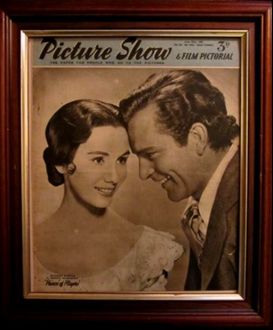
A copy of the weekly British publication, 'Picture Show and Film Pictorial', dating from the 25th of June, 1955.
This film magazine was printed and published by The Amalgamated Press Limited, London.
The cover of this issue features a stunning portrait of Richard Burton and Maggie McNamara promoting the Twentieth Century Fox production of the historical drama, 'Prince Of Players'.
The magazine also includes a story adaption of 'Prince Of Players' which includes black and white photographs from the film.
'Picture Show and Film Pictorial' was a magazine which was published between May, 1919 and December, 1960 and was one of the longest running entertainment magazines in the UK.
This film magazine was printed and published by The Amalgamated Press Limited, London.
The cover of this issue features a stunning portrait of Richard Burton and Maggie McNamara promoting the Twentieth Century Fox production of the historical drama, 'Prince Of Players'.
The magazine also includes a story adaption of 'Prince Of Players' which includes black and white photographs from the film.
'Picture Show and Film Pictorial' was a magazine which was published between May, 1919 and December, 1960 and was one of the longest running entertainment magazines in the UK.
'Picturegoer Film Weekly' Magazine, June 1955
A vintage copy of the weekly British film and entertainment magazine 'Picturegoer', dating from June, 1955. This edition features a full-page black and white studio portrait of Richard Burton accompanied by a small article entitled, 'How To Get Away With Murder'.
Other articles featured in this edition relate to Johnnie Ray, Jackie Collins, Diane Cilento, Grace Kelly and James Dean.
'Picturegoer' was published and printed by the Odhams Press Ltd based in Watford.
Other articles featured in this edition relate to Johnnie Ray, Jackie Collins, Diane Cilento, Grace Kelly and James Dean.
'Picturegoer' was published and printed by the Odhams Press Ltd based in Watford.
'Theatre World' Magazine, February 1956
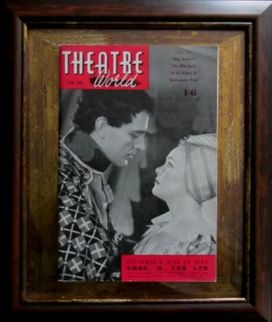
A copy of the British edition of 'Theatre World' magazine, dating from February, 1956, which features a cover portrait of Richard Burton and Zena Walker in a scene from the Old Vic Theatre production of William Shakespeare's, 'Henry V'.
This copy of 'Theatre World', incorporating 'Play Pictorial', is issue three-hundred and seventy-three and was printed by Wightman and Company Limited, The Lewes Press based in Lewes, East Sussex for the publishers, The Practical Press Limited, based in Fleet Street, London.
The original price of 'Theatre World' at the time of this publication was one shilling and sixpence.
Aside from an in-depth, five-page article relating to Michael Benthall's production of Henry V, which also includes twelve black and white photographs, this issue includes articles on Emlyn Williams in 'The Wild Duck', 'Anniversary Waltz', Margot Fonteyn, 'Waiting For Godot' 'Such Is Life' and Paul Schofield's performance in William Shakespeare's 'Hamlet'.
This copy of 'Theatre World', incorporating 'Play Pictorial', is issue three-hundred and seventy-three and was printed by Wightman and Company Limited, The Lewes Press based in Lewes, East Sussex for the publishers, The Practical Press Limited, based in Fleet Street, London.
The original price of 'Theatre World' at the time of this publication was one shilling and sixpence.
Aside from an in-depth, five-page article relating to Michael Benthall's production of Henry V, which also includes twelve black and white photographs, this issue includes articles on Emlyn Williams in 'The Wild Duck', 'Anniversary Waltz', Margot Fonteyn, 'Waiting For Godot' 'Such Is Life' and Paul Schofield's performance in William Shakespeare's 'Hamlet'.
The Richard Burton and Emlyn Williams articles as they appear in the February, 1956 issue of 'Theatre World'.
'Plays and Players' Theatre Magazine, February 1956
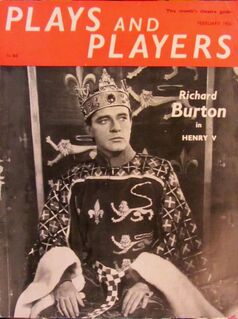
A copy of the British Theatre magazine, 'Plays and Players', dating from February, 1956.
The cover for this edition features a striking portrait of Richard Burton in the role of William Shakespeare's Henry V, in which he was appearing in at The Old Vic at the time of the magazines publication.
The Richard Burton article which appears in this issue is entitled, 'Longing For A Cigarette', and focuses on Burton's desire to be cast in a contemporary play, rather than Shakespeare, as it would enable him to be able to smoke a 'craved-for' cigarette on stage.
As well as the striking cover portrait, the article features three other photographs of Burton on stage, as Philip the Bastard in 'King John', as Hamlet at The Old Vic and as Caliban in 'The Tempest', all captured by renowned Theatrical Photographer, Angus McBean.
This copy of 'Plays and Players' was number five of volume three and was published by Hansom Books Limited, Buckingham Palace Road, London in February, 1956.
The price of this magazine at the time of publication was one shilling and sixpence.
The cover for this edition features a striking portrait of Richard Burton in the role of William Shakespeare's Henry V, in which he was appearing in at The Old Vic at the time of the magazines publication.
The Richard Burton article which appears in this issue is entitled, 'Longing For A Cigarette', and focuses on Burton's desire to be cast in a contemporary play, rather than Shakespeare, as it would enable him to be able to smoke a 'craved-for' cigarette on stage.
As well as the striking cover portrait, the article features three other photographs of Burton on stage, as Philip the Bastard in 'King John', as Hamlet at The Old Vic and as Caliban in 'The Tempest', all captured by renowned Theatrical Photographer, Angus McBean.
This copy of 'Plays and Players' was number five of volume three and was published by Hansom Books Limited, Buckingham Palace Road, London in February, 1956.
The price of this magazine at the time of publication was one shilling and sixpence.
'Everybody's Weekly' Magazine, February 1956
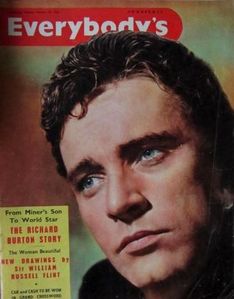
An early copy of the British magazine, 'Everybody's Weekly', dating from February the 25th, 1956 which features a stunning colour cover portrait of Richard Burton.
Included in this issue is an article focusing on Richard Burton entitled, 'From Miner's Son To World Star - Background To Burton', with the text written by Richard G. Hubler and including photographs of Richard Burton in rehearsal with John Neville during the run of William Shakespeare's 'Othello' at The Old Vic and of Richard Burton on stage in a performance of 'The Boy With A Cart' with Mary Jerrold at The Lyric Theatre, Hammersmith.
Other articles which feature in this issue relate to Margot Fonteyn, the art of Sir William Russell Flint, Aristotle Onassis and the World heavyweight boxing champion, 'Gentleman' Jim Corbett.
This edition also contains advertisments, features and illustrations evocative of the era. The magazine was published by Everybody's Publishing Limited and The Amalgamated Press Limited, London and was printed by Sun Printing Limited, based in London and Watford.
Included in this issue is an article focusing on Richard Burton entitled, 'From Miner's Son To World Star - Background To Burton', with the text written by Richard G. Hubler and including photographs of Richard Burton in rehearsal with John Neville during the run of William Shakespeare's 'Othello' at The Old Vic and of Richard Burton on stage in a performance of 'The Boy With A Cart' with Mary Jerrold at The Lyric Theatre, Hammersmith.
Other articles which feature in this issue relate to Margot Fonteyn, the art of Sir William Russell Flint, Aristotle Onassis and the World heavyweight boxing champion, 'Gentleman' Jim Corbett.
This edition also contains advertisments, features and illustrations evocative of the era. The magazine was published by Everybody's Publishing Limited and The Amalgamated Press Limited, London and was printed by Sun Printing Limited, based in London and Watford.
The 'Background To Burton' article which features in this edition of 'Everybody's Weekly' incorporating images of Richard Burton and John Neville from the Old Vic 'Othello' rehearsals, as well as 'Alexander The Great' and the stage performance of 'The Boy With A Cart'.
'Picturegoer Film Weekly' Magazine, February 1956
A vintage copy of the British film and entertainment weekly magazine, 'Picturegoer', dating from the 11th of February, 1956.
Featured inside is a wonderful trade advertisment for the 20th Century Fox production, 'The Rains of Ranchipur' which was to have its European Premiere on Thursday the 16th of February, 1956 at the Carlton Theatre, Haymarket. The event had the added attraction of including a personal appearance on the night by Richard Burton.
Articles featured in this issue of 'Picturegoer' relate to Frank Sinatra in 'The Man With The Golden Arm', Hollywood scandals, Marilyn Monroe, Tarzan, Grace Kelly and Kenneth More.
This issue of 'Picturegoer' Film Weekly was published and printed by Odhams Press Limited based in Watford, London.
Featured inside is a wonderful trade advertisment for the 20th Century Fox production, 'The Rains of Ranchipur' which was to have its European Premiere on Thursday the 16th of February, 1956 at the Carlton Theatre, Haymarket. The event had the added attraction of including a personal appearance on the night by Richard Burton.
Articles featured in this issue of 'Picturegoer' relate to Frank Sinatra in 'The Man With The Golden Arm', Hollywood scandals, Marilyn Monroe, Tarzan, Grace Kelly and Kenneth More.
This issue of 'Picturegoer' Film Weekly was published and printed by Odhams Press Limited based in Watford, London.
'Radio Times' Richard Burton Cover, April 1956
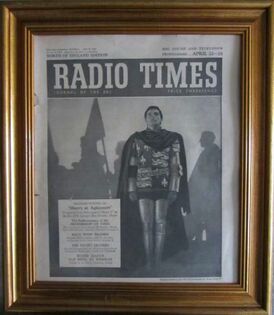
Richard Burton's second cover appearance on the British television and radio listings magazine, 'Radio Times'.
This appearance was to promote the Sunday night, B.B.C Home Service St. George's Eve broadcast of a sequence from William Shakespeare's 'Henry V', entitled, 'Henry At Agincourt'.
The programme was broadcast on Sunday the 22nd of April,, 1956 at 9.15pm and appearing alongside Richard Burton, superbly cast in the role of Henry V, were John Neville as Chorus, Richard Bebb as the Duke of Gloucester, Dudley Jones as Fluellen and George Merritt as Gower.
The programme itself was produced for the B.B.C. by John Gibson.
This edition of the 'Radio Times' is a North of England edition and was printed on the 20th of April, 1956 and listed the B.B.C. television and radio broadcasts for the week commencing the 22nd till the 28th of April.
The original price of this rare complete copy was threepence.
Also included in this edition is a notice for the broadcast of the Emlyn William's play 'The Wind Of Heaven' which was broadcast on Thursday the 26th of April of the same week.
This appearance was to promote the Sunday night, B.B.C Home Service St. George's Eve broadcast of a sequence from William Shakespeare's 'Henry V', entitled, 'Henry At Agincourt'.
The programme was broadcast on Sunday the 22nd of April,, 1956 at 9.15pm and appearing alongside Richard Burton, superbly cast in the role of Henry V, were John Neville as Chorus, Richard Bebb as the Duke of Gloucester, Dudley Jones as Fluellen and George Merritt as Gower.
The programme itself was produced for the B.B.C. by John Gibson.
This edition of the 'Radio Times' is a North of England edition and was printed on the 20th of April, 1956 and listed the B.B.C. television and radio broadcasts for the week commencing the 22nd till the 28th of April.
The original price of this rare complete copy was threepence.
Also included in this edition is a notice for the broadcast of the Emlyn William's play 'The Wind Of Heaven' which was broadcast on Thursday the 26th of April of the same week.
The original listings for Richard Burton's performance in 'Henry At Agincourt' and for the Emlyn William's play 'The Wind Of Heaven' taken from the April 1956 edition of the 'Radio Times'.
'Photoplay' Magazine, May 1956
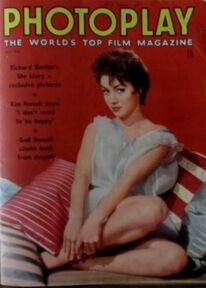
An early copy of an edition of the British film magazine, 'Photoplay', dating from May, 1956.
This copy of 'Photoplay' was published by The Argus Press Limited, London for The Illustrated Publications Company Limited and was printed by Samuel Stephens Limited, Upper Norwood.
This edition features a four-page article entitled, 'Burton -The Welsh Rare Bit', which is illustrated with several black and white photographs of Richard Burton, ranging from his childhood, his days in the R.A.F., his early career and with his then wife, Sybil.
Richard Burton also features in a separate article in this edition which was written by Maurice Woodruff.
Other film celebrities of the time featured in this issue include Anita Ekberg, Peter Lorre, John Wayne, Rod Steiger, Joan Collins and Jean Simmons.
This copy is illustrated throughout with colour and black and white photographs, film advertisments and articles relating to the latest film releases of the time.
'Photoplay', later re-titled 'Photoplay Film Monthly', was founded in Chicago in 1911 and was one of the first ever motion picture fan magazines. 'Photoplay' was first published in the United States by MacFadden Publications. Early contributors to the magazine included Hedda Hopper, Louella Parsons and Richard Burton's early biographer, Ruth Waterbury.
The British version of 'Photoplay' debuted in 1950 and featured an equal mix of British and American film stars. The magazine finally ceased publication in 1989.
This copy of 'Photoplay' was published by The Argus Press Limited, London for The Illustrated Publications Company Limited and was printed by Samuel Stephens Limited, Upper Norwood.
This edition features a four-page article entitled, 'Burton -The Welsh Rare Bit', which is illustrated with several black and white photographs of Richard Burton, ranging from his childhood, his days in the R.A.F., his early career and with his then wife, Sybil.
Richard Burton also features in a separate article in this edition which was written by Maurice Woodruff.
Other film celebrities of the time featured in this issue include Anita Ekberg, Peter Lorre, John Wayne, Rod Steiger, Joan Collins and Jean Simmons.
This copy is illustrated throughout with colour and black and white photographs, film advertisments and articles relating to the latest film releases of the time.
'Photoplay', later re-titled 'Photoplay Film Monthly', was founded in Chicago in 1911 and was one of the first ever motion picture fan magazines. 'Photoplay' was first published in the United States by MacFadden Publications. Early contributors to the magazine included Hedda Hopper, Louella Parsons and Richard Burton's early biographer, Ruth Waterbury.
The British version of 'Photoplay' debuted in 1950 and featured an equal mix of British and American film stars. The magazine finally ceased publication in 1989.
This edition of 'Photoplay' film magazine was kindly donated by Jeff Towns, Chairman of The Dylan Thomas Society of Great Britain.
'Plays and Players' Theatre Magazine, July 1956
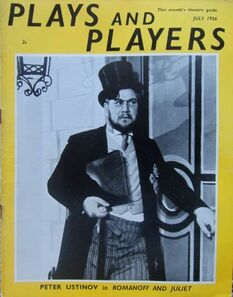
A copy of the vintage theatre magazine, 'Plays and Players', dating from July, 1956.
This edition features a striking studio portrait of Richard Burton in the role of Othello as captured by theatrical photographer Angus McBean. The caption which accompanies the portrait reads;
'Richard Burton, pictured here as Othello in the recent Old Vic production, manages his film commitments so that he can return to the stage for three or four months each year. For the past three years these stage appearances have been exclusively with the Old Vic company, and his most notable parts have been Hamlet, Coriolanus, Henry V, Othello and Iago.'
Two further images of Richard Burton as Othello appear in an article in this issue entitled, 'Othello at Stratford and at the Old Vic.'
Peter Ustinov is the cover star for this issue and features in an in-depth article relating to the production of 'Romanoff and Juliet' at the Piccadilly Theatre.
Other articles in this issue relate to George Bernard Shaw, 'My Fair Lady' on Broadway, Gigi, 'The Rainmaker' with Robert Shaw and 'Wild Grows The Heather'.
This edition of 'Plays and Players' was published by Hansom Books Limited, Lower Belgrave Street, London and was printed by Sussex Printers Limited based in Eastbourne and at the time of publication cost two shillings.
This edition features a striking studio portrait of Richard Burton in the role of Othello as captured by theatrical photographer Angus McBean. The caption which accompanies the portrait reads;
'Richard Burton, pictured here as Othello in the recent Old Vic production, manages his film commitments so that he can return to the stage for three or four months each year. For the past three years these stage appearances have been exclusively with the Old Vic company, and his most notable parts have been Hamlet, Coriolanus, Henry V, Othello and Iago.'
Two further images of Richard Burton as Othello appear in an article in this issue entitled, 'Othello at Stratford and at the Old Vic.'
Peter Ustinov is the cover star for this issue and features in an in-depth article relating to the production of 'Romanoff and Juliet' at the Piccadilly Theatre.
Other articles in this issue relate to George Bernard Shaw, 'My Fair Lady' on Broadway, Gigi, 'The Rainmaker' with Robert Shaw and 'Wild Grows The Heather'.
This edition of 'Plays and Players' was published by Hansom Books Limited, Lower Belgrave Street, London and was printed by Sussex Printers Limited based in Eastbourne and at the time of publication cost two shillings.
The image of Richard Burton in the role of Othello, captured by Angus McBean, which features in the July, 1956 issue of 'Plays and Players'.
'Sight and Sound Film Quarterly' Magazine, 1959
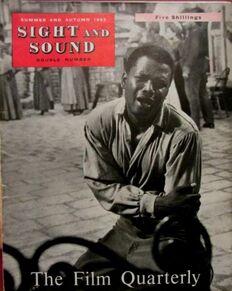
A copy of the film quarterly magazine, 'Sight And Sound', dating from 1959. This was a double edition covering both the summer and autumn period of that year.
The magazine was published by The British Film Institute based at that time in Shaftesbury Avenue, London and was edited by Penelope Houston.
This edition features an article written by David Robinson on the Warner Brothers film adaption of the John Osbourne play, 'Look Back In Anger' starring Richard Burton, Claire Bloom, Mary Ure, Gary Raymond and Edith Evans. The article features many black and white images from the film production.
This edition of 'Sight And Sound' also features articles on 'La Dolce Vita', Luchino Visconti, 'Suddenly Last Summer', 'The Survivors', 'The Nun's Story', Anatomy Of A Murder' and a colour promotional advert for the Ingmar Bergman film 'The Face', starring Max von Sydow and Bibi Andersson.
This copy was edition three and four of volume twenty-eight issued in the summer and autumn of 1959 and was originally priced at the time of publication at five shillings.
The magazine was published by The British Film Institute based at that time in Shaftesbury Avenue, London and was edited by Penelope Houston.
This edition features an article written by David Robinson on the Warner Brothers film adaption of the John Osbourne play, 'Look Back In Anger' starring Richard Burton, Claire Bloom, Mary Ure, Gary Raymond and Edith Evans. The article features many black and white images from the film production.
This edition of 'Sight And Sound' also features articles on 'La Dolce Vita', Luchino Visconti, 'Suddenly Last Summer', 'The Survivors', 'The Nun's Story', Anatomy Of A Murder' and a colour promotional advert for the Ingmar Bergman film 'The Face', starring Max von Sydow and Bibi Andersson.
This copy was edition three and four of volume twenty-eight issued in the summer and autumn of 1959 and was originally priced at the time of publication at five shillings.
The 'Look Back In Anger' article which features in the summer and autumn edition of 'Sight And Sound' dating from 1959.
This edition of 'Sight And Sound' was very kindly donated the The Richard Burton Museum collection by Andrew Dally of Dylan Thomas News, a good friend and supporter of The Richard Burton Muserum, and which was an act of kindness for which we are extremely grateful.
This edition of 'Sight And Sound' was very kindly donated the The Richard Burton Museum collection by Andrew Dally of Dylan Thomas News, a good friend and supporter of The Richard Burton Muserum, and which was an act of kindness for which we are extremely grateful.
'Bild Journalen' Magazine, March 1962
A rare and complete copy of the Swedish monthly magazine, 'Bild Journalen', dating from March, 1962. This edition features a double-page cover image of Richard Burton and Elizabeth Taylor taken from the Twentieth Century Fox production of 'Cleopatra'.
'Bild Journalen' was a popular 'lifestyle' magazine published in Sweden and also available in Denmark and Norway between the years 1954-1969.
'Bild Journalen' was a popular 'lifestyle' magazine published in Sweden and also available in Denmark and Norway between the years 1954-1969.
'Playboy Magazine', September 1963
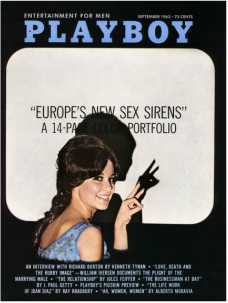
An early copy of the world famous 'Playboy Magazine'. This is an original American edition which dates from September, 1963.
The 'Playboy Interview' which features in this month's issue was with Richard Burton, talking in-depth to British theatre critic Kenneth Tynan, in an interview hailed as 'a candid interview with Cleopatra's controversial co-star'.
This copy of 'Playboy Magazine' is issue number nine of volume ten and was published and printed by the H.M.H. Publishing Company Incorporated based in the Playboy Building, Chicago, Illinois.
Alongside the regular and traditional features of a 'Playboy Magazine', including cartoons, jokes, art, lifestyle and fashion articles and a wide range of advertisments evocative of the era, there are articles written by Ray Bradbury and John Paul Getty amongst a host of others.
This issue is complete and also contains all the card inserts which would have been present on publication.
The price of this issue of 'Playboy Magazine' in 1963 was seventy-five cents.
The 'Playboy Interview' which features in this month's issue was with Richard Burton, talking in-depth to British theatre critic Kenneth Tynan, in an interview hailed as 'a candid interview with Cleopatra's controversial co-star'.
This copy of 'Playboy Magazine' is issue number nine of volume ten and was published and printed by the H.M.H. Publishing Company Incorporated based in the Playboy Building, Chicago, Illinois.
Alongside the regular and traditional features of a 'Playboy Magazine', including cartoons, jokes, art, lifestyle and fashion articles and a wide range of advertisments evocative of the era, there are articles written by Ray Bradbury and John Paul Getty amongst a host of others.
This issue is complete and also contains all the card inserts which would have been present on publication.
The price of this issue of 'Playboy Magazine' in 1963 was seventy-five cents.
Images of Richard Burton in conversation with Kenneth Tynan from the September, 1963 issue of 'Playboy Magazine'.
'Everybody's' Magazine, November 1963
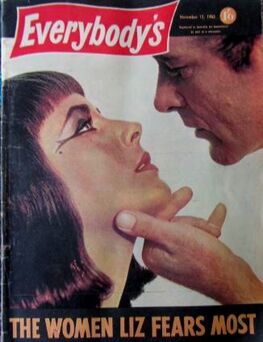
A vintage copy of the 1960's Australian 'Lifestyle' magazine, 'Everybody's', dating from November the 13th, 1963.
This issue features a wonderful cover portrait of Richard Burton and Elizabeth Taylor taken from a promotional photo-shoot from the 1963 Twentieth Century Fox production of 'Cleopatra'.
The 'Burton / Taylor' article which features in this edition is entitled, 'The Women Liz Fears', which was written by the magazine's special correspondent in Mexico, Truls Fagrell. The article, pictured below, features four more photographs from the 'Cleopatra' photo-shoot as well as some delightful candid shots of Richard Burton and Elizabeth Taylor.
Other articles included in this issue relate to Sydney Hospital, Australian actor, Richard Bentley, Sydney's Manly Beach oceanarium, ships of the Royal Navy and golfer, Arnold Palmer.
This early copy of 'Everybody's' was published by the Australian Consolidated Press Limited and was printed by Conpress Printing Limited, based in Alexandria, Sydney.
This issue features a wonderful cover portrait of Richard Burton and Elizabeth Taylor taken from a promotional photo-shoot from the 1963 Twentieth Century Fox production of 'Cleopatra'.
The 'Burton / Taylor' article which features in this edition is entitled, 'The Women Liz Fears', which was written by the magazine's special correspondent in Mexico, Truls Fagrell. The article, pictured below, features four more photographs from the 'Cleopatra' photo-shoot as well as some delightful candid shots of Richard Burton and Elizabeth Taylor.
Other articles included in this issue relate to Sydney Hospital, Australian actor, Richard Bentley, Sydney's Manly Beach oceanarium, ships of the Royal Navy and golfer, Arnold Palmer.
This early copy of 'Everybody's' was published by the Australian Consolidated Press Limited and was printed by Conpress Printing Limited, based in Alexandria, Sydney.
The 'Women Liz Fears Most' article from the November, 1963 issue of the Australian magazine, 'Everybody's'.
'Life' Magazine, Elizabeth Taylor Interview, December 1964
A vintage copy of the American 'Lifestyle and General Interest' weekly magazine, 'Life'.
This issue dates from the week commencing December the 18th,1964 and features a stunning front cover colour portrait of Elizabeth Taylor, which was photographed by her great friend and fellow actor, Roddy McDowall.
The article which is contained within the pages of this iconic American magazine features an in-depth and candid interview with Elizabeth Taylor, conducted by 'Life' Associate Editor, Richard Meryman.
Under the title of, 'Elizabeth Taylor : She takes a hard, utterly frank look at herself', she says what she really thinks about her image, her children, her reputation, her career and Richard Burton.
The article is further enhanced by an array of black and white candid photographs of Elizabeth Taylor, Richard Burton and her children, captured by Roddy McDowall,
This edition of 'Life' Magazine was numbered twenty-five of volume fifty-seven and was published by Time Incorporated, Chicago, Illinois.
This issue dates from the week commencing December the 18th,1964 and features a stunning front cover colour portrait of Elizabeth Taylor, which was photographed by her great friend and fellow actor, Roddy McDowall.
The article which is contained within the pages of this iconic American magazine features an in-depth and candid interview with Elizabeth Taylor, conducted by 'Life' Associate Editor, Richard Meryman.
Under the title of, 'Elizabeth Taylor : She takes a hard, utterly frank look at herself', she says what she really thinks about her image, her children, her reputation, her career and Richard Burton.
The article is further enhanced by an array of black and white candid photographs of Elizabeth Taylor, Richard Burton and her children, captured by Roddy McDowall,
This edition of 'Life' Magazine was numbered twenty-five of volume fifty-seven and was published by Time Incorporated, Chicago, Illinois.
The Elizabeth Taylor interview as it appears in the December, 1964 issue of 'Life' magazine.
'ABC Film Review' Magazine, March 1965
A copy of the monthly British film and entertainment magazine, 'ABC Film Review' dating from March, 1965.
This issue features an in-depth, two-page article relating to the 1964 Paramount production of the historical drama, 'Becket'.
The article, written by Vincent Firth, is basically a synopsis of the film and incorporates five still images, including two portraits of the main stars, Richard Burton as Thomas Becket and Peter O'Toole as Henry II.
This edition also features a full page black and white advertisment for 'Becket'.
The cover star for this issue was Ursula Andress, promoting the Hammer Seven Arts production of 'She'.
Other articles which feature in this edition relate to the films 'Dr. Terrors House of Horrors', 'Robinson Crusoe on Mars', 'None But The Brave' as well as celebrities including Morecambe and Wise, The Beatles, The Rolling Stones and Billy Fury.
This edition of 'ABC Film Review' was published by Associated British Cinemas Limited and was printed by Harrison and Sons Limited, London and at the time of publication cost sixpence.
This issue features an in-depth, two-page article relating to the 1964 Paramount production of the historical drama, 'Becket'.
The article, written by Vincent Firth, is basically a synopsis of the film and incorporates five still images, including two portraits of the main stars, Richard Burton as Thomas Becket and Peter O'Toole as Henry II.
This edition also features a full page black and white advertisment for 'Becket'.
The cover star for this issue was Ursula Andress, promoting the Hammer Seven Arts production of 'She'.
Other articles which feature in this edition relate to the films 'Dr. Terrors House of Horrors', 'Robinson Crusoe on Mars', 'None But The Brave' as well as celebrities including Morecambe and Wise, The Beatles, The Rolling Stones and Billy Fury.
This edition of 'ABC Film Review' was published by Associated British Cinemas Limited and was printed by Harrison and Sons Limited, London and at the time of publication cost sixpence.
The 'Becket' article which features in the March, 1965 issue of 'ABC Film Review'.
'ABC Film Review' Magazine, October 1965
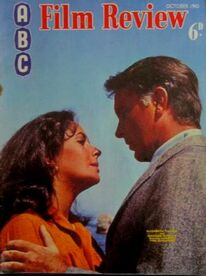
A copy of the British film and entertainment monthly magazine, 'ABC Film Review' dating from October, 1965.
This issue features a cover colour portrait of Richard Burton and Elizabeth Taylor taken from the Metro-Goldwyn-Mayer production of 'The Sandpiper', which also features in a double page article relating to the film written by ABC Film Review Journalist Peter S. Haigh. The article is accompanied by six black and white still images from the film.
ABC Film Review was published by Associated British Cinemas Limited, based in Golden Square, London and printed by Harrison and Sons Limited with Photo Litho provided by Taylowe Limited of Maidenhead, Berkshire.
The original price of this issue in 1965 was sixpence.
Other features which appear in this October edition include articles on the Dirk Bogarde and Julie Christie film, 'Darling', 'The Great Race', Jerry Lewis in 'The Disorderly Orderly', Sid James in 'The Big Job' and a beautiful colour portrait of Natalie Wood.
This issue features a cover colour portrait of Richard Burton and Elizabeth Taylor taken from the Metro-Goldwyn-Mayer production of 'The Sandpiper', which also features in a double page article relating to the film written by ABC Film Review Journalist Peter S. Haigh. The article is accompanied by six black and white still images from the film.
ABC Film Review was published by Associated British Cinemas Limited, based in Golden Square, London and printed by Harrison and Sons Limited with Photo Litho provided by Taylowe Limited of Maidenhead, Berkshire.
The original price of this issue in 1965 was sixpence.
Other features which appear in this October edition include articles on the Dirk Bogarde and Julie Christie film, 'Darling', 'The Great Race', Jerry Lewis in 'The Disorderly Orderly', Sid James in 'The Big Job' and a beautiful colour portrait of Natalie Wood.
The Richard Burton and Elizabeth Taylor 'Sandpiper' article from the October, 1965 issue of 'ABC Film Review'.
'ABC Film Review' Magazine, March 1967
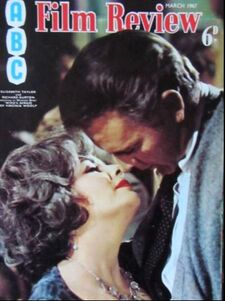
A vintage copy of the British film and entertainment monthly magazine, 'ABC Film Review'.
This issue dates from March, 1967 and features a colour photograph of Richard Burton and Elizabeth Taylor in a scene from the Award-winning, Warner Brothers film, 'Who's Afraid of Virginia Woolf?'
Featured inside this issue is an article relating to the film written by ABC Film Review journalist, Peter S. Haigh. Accompanying the article are several black and white still photographs from the film, also featuring George Segal and Sandy Dennis.
Other articles in this copy focus on Hywel Bennett, Natalie Wood in the film, 'Penelope', a feature on George Segal, Michael Caine as Harry Palmer and a colour full-page photograph of Natalie Wood.
This copy of 'ABC Film Review' was issue number three of volume seventeen, and at the time of publication in 1967 cost sixpence.
The magazine was published by Associated British Cinemas Limited and was printed by Harrison and Sons Limited based in Hayes, Middlesex.
This issue dates from March, 1967 and features a colour photograph of Richard Burton and Elizabeth Taylor in a scene from the Award-winning, Warner Brothers film, 'Who's Afraid of Virginia Woolf?'
Featured inside this issue is an article relating to the film written by ABC Film Review journalist, Peter S. Haigh. Accompanying the article are several black and white still photographs from the film, also featuring George Segal and Sandy Dennis.
Other articles in this copy focus on Hywel Bennett, Natalie Wood in the film, 'Penelope', a feature on George Segal, Michael Caine as Harry Palmer and a colour full-page photograph of Natalie Wood.
This copy of 'ABC Film Review' was issue number three of volume seventeen, and at the time of publication in 1967 cost sixpence.
The magazine was published by Associated British Cinemas Limited and was printed by Harrison and Sons Limited based in Hayes, Middlesex.
The two-page article relating to 'Who's Afraid of Virginia Woolf?' which features in the March, 1967 issue of ABC Film Review.
'Photoplay Film Monthly' Magazine, April 1969
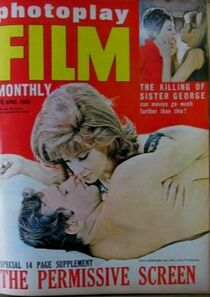
A vintage copy of 'Photoplay Film Monthly' dating from April, 1969 which features a cover image of Gina Lollobrigida and Juan-Louis Trintignant promoting the fourteen page supplement included with this issue entitled, 'The Permissive Screen'.
Part of this supplement includes a three page article focusing on the controversial 1969 Richard Burton and Rex Harrison film, 'Staircase'. The article includes an interview with Richard Burton as well as black and white still images from the film.
This issue of 'Photoplay' also includes a full page advertisment and a three-page article on the 1968 cult film, 'Candy', a film which featured a cameo performance by Richard Burton in the role of MacPhisto, an 'over-the-top' Welsh poet.
Other film stars of the day who feature in this issue include, Steve McQueen, Maggie Smith, Nicol Williamson, Oliver Reed, Glenda Jackson, Gregory Peck and Vanessa Redgrave.
This copy is illustrated throughout with colour and black and white photographs and includes articles, features and advertisments highly evocative of the era.
Part of this supplement includes a three page article focusing on the controversial 1969 Richard Burton and Rex Harrison film, 'Staircase'. The article includes an interview with Richard Burton as well as black and white still images from the film.
This issue of 'Photoplay' also includes a full page advertisment and a three-page article on the 1968 cult film, 'Candy', a film which featured a cameo performance by Richard Burton in the role of MacPhisto, an 'over-the-top' Welsh poet.
Other film stars of the day who feature in this issue include, Steve McQueen, Maggie Smith, Nicol Williamson, Oliver Reed, Glenda Jackson, Gregory Peck and Vanessa Redgrave.
This copy is illustrated throughout with colour and black and white photographs and includes articles, features and advertisments highly evocative of the era.
The Richard Burton and Rex Harrison 'Staircase' article which appears as part of 'The Permissive Society' feature in the April, 1969 issue of 'Photoplay Film Monthly'.
'Photoplay Film Monthly' Magazine, June 1969
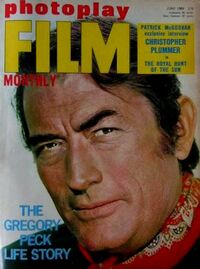
An original copy of 'Photoplay Film Monthly' magazine, dating from June, 1969.
This copy is issue number eight of volume twenty and features a colour cover portrait of Gregory Peck.
This copy of 'Photoplay' was published by The Argus Press Limited, based in London for The Illustrated Publications Company Limited and printed by Samuel Stephen Limited, London.
This issue contains a three page article entitled, 'The Yesterdays, Todays and Tomorrows of Richard Burton', which as well as including a brief summary of Richard Burton's beginnings in the acting profession also includes an interview with Richard Burton by journalist Steven Miller written especially for 'Photoplay' magazine. The article is illustrated with black and white still photographs from the 1969 film adaption of 'Staircase'.
Other articles included in this issue include features on Patrick McGoohan, Raquel Welch, Gene Kelly, George Lazenby, Christopher Plummer and Robert Stephens. The main cover photograph of Gregory Peck is in relation to an in-depth six page article on his life and career.
The magazine is illustrated throughout with colour and black and white photographs of the film stars of the day and includes fascinating advertisments for the new film releases and products highly evocative of the era.
This copy is issue number eight of volume twenty and features a colour cover portrait of Gregory Peck.
This copy of 'Photoplay' was published by The Argus Press Limited, based in London for The Illustrated Publications Company Limited and printed by Samuel Stephen Limited, London.
This issue contains a three page article entitled, 'The Yesterdays, Todays and Tomorrows of Richard Burton', which as well as including a brief summary of Richard Burton's beginnings in the acting profession also includes an interview with Richard Burton by journalist Steven Miller written especially for 'Photoplay' magazine. The article is illustrated with black and white still photographs from the 1969 film adaption of 'Staircase'.
Other articles included in this issue include features on Patrick McGoohan, Raquel Welch, Gene Kelly, George Lazenby, Christopher Plummer and Robert Stephens. The main cover photograph of Gregory Peck is in relation to an in-depth six page article on his life and career.
The magazine is illustrated throughout with colour and black and white photographs of the film stars of the day and includes fascinating advertisments for the new film releases and products highly evocative of the era.
The article from the June, 1969 issue of 'Photoplay Film Monthly' entitled 'The Yesterdays, Todays And Tomorrows of Richard Burton'.
'Photoplay Film Monthly' Magazine, October 1969
A copy of the vintage British film and entertainment magazine, 'Photoplay Film Monthly' dating from October 1969.
This issue features a beautifully written article by Photoplay journalist Peg Connor focusing on both Richard Burton and Elizabeth Taylor entitled, 'Those Romantic Roaming Burtons'.
Other articles which appear in this issue relate to; Brigitte Bardot, Vincent Price, Paul Newman and the film adaption of, 'The Battle of Britain starring Michael Caine, Christopher Plummer, Susannah York, Laurence Olivier and Ralph Richardson.
This issue of 'Photoplay Film Monthly' was published by the Argus Press Limited and was printed by Samuel Stephen Limited, London and was issue ten of volume twenty.
This issue features a beautifully written article by Photoplay journalist Peg Connor focusing on both Richard Burton and Elizabeth Taylor entitled, 'Those Romantic Roaming Burtons'.
Other articles which appear in this issue relate to; Brigitte Bardot, Vincent Price, Paul Newman and the film adaption of, 'The Battle of Britain starring Michael Caine, Christopher Plummer, Susannah York, Laurence Olivier and Ralph Richardson.
This issue of 'Photoplay Film Monthly' was published by the Argus Press Limited and was printed by Samuel Stephen Limited, London and was issue ten of volume twenty.
'Oyster' Welsh Poetry and Literary Booklets, 1969
Two original copies of the extremely rare Welsh 'contribution-based' poetry and literary booklets, 'Oyster'. These two editions are issue two and three and were published in 1969.
'Oyster' magazine, an anthology of superbWelsh poetry, was sponsored and part-funded by Philip Burton, Richard Burton and Elizabeth Taylor.
The booklets were beautifully presented and produced by Oyster Publications, which was based in Landaff, Cardiff, and the magazine was printed by Ronald Phipps and Company and at the time of publication in 1969 cost two shillings and sixpence.
'Oyster' magazine, an anthology of superbWelsh poetry, was sponsored and part-funded by Philip Burton, Richard Burton and Elizabeth Taylor.
The booklets were beautifully presented and produced by Oyster Publications, which was based in Landaff, Cardiff, and the magazine was printed by Ronald Phipps and Company and at the time of publication in 1969 cost two shillings and sixpence.
The list of contributors for these two early, Richard Burton sponsored, issues of 'Oyster' magazine.
'Photoplay Film Monthly' Magazine, August 1971
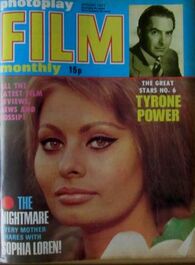
An original copy of the British monthly film magazine, 'Photoplay Film Monthly'.
This copy dates from August, 1971 and is issue number eight of volume twenty-two and features a colour cover photograph of Sophia Loren.
This issue features a 'Screen Scene' review of the 1971 MGM / EMI Richard Burton film, 'Villain', which was directed by Michael Tuchner.
The article, entitled, 'Burton as the Villain', includes black and white still photographs from the film as well as a partial cast-list.
Other articles included in this issue focus on Sophia Loren, Anthony Hopkins, Tyrone Power, Jane Fonda and Roman Polanski's screen version of 'Macbeth'.
The magazine also includes advertisments and news for all the latest film releases of the time and is illustrated throughout with colour and black and white photographs.
This copy of 'Photoplay' was published by The Argus Press Limited, London and printed by East Midland Litho Printers Limited based in Peterborough.
This copy dates from August, 1971 and is issue number eight of volume twenty-two and features a colour cover photograph of Sophia Loren.
This issue features a 'Screen Scene' review of the 1971 MGM / EMI Richard Burton film, 'Villain', which was directed by Michael Tuchner.
The article, entitled, 'Burton as the Villain', includes black and white still photographs from the film as well as a partial cast-list.
Other articles included in this issue focus on Sophia Loren, Anthony Hopkins, Tyrone Power, Jane Fonda and Roman Polanski's screen version of 'Macbeth'.
The magazine also includes advertisments and news for all the latest film releases of the time and is illustrated throughout with colour and black and white photographs.
This copy of 'Photoplay' was published by The Argus Press Limited, London and printed by East Midland Litho Printers Limited based in Peterborough.
The 'Burton As The Villain' article which features in the August, 1971 edition of 'Photoplay Film Monthly'.
'Radio Times' Richard Burton Cover, November 1971
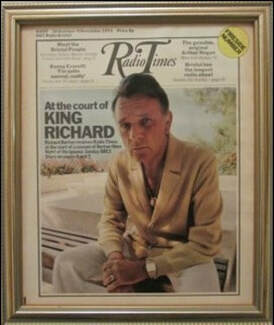
A later copy of the 'Radio Times' magazine, B.B.C. West edition, featuring the B.B.C. television and radio schedules for the week commencing the 30th of October and ending on the 5th of November, 1971.
This edition features a very striking cover portrait of Richard Burton.
This copy of the 'Radio Times' features an article on Richard Burton and the cover portrait was used to promote a short season of Richard Burton's films being shown on British television.
The 'Radio Times' is a British weekly television and radio listings magazine, first published by B.B.C. magazines in 1923 and was originally published to list all radio programmes broadcast by the B.B.C. At one time the 'Radio Times' had the largest circulation of any magazine in Europe.
This edition features a very striking cover portrait of Richard Burton.
This copy of the 'Radio Times' features an article on Richard Burton and the cover portrait was used to promote a short season of Richard Burton's films being shown on British television.
The 'Radio Times' is a British weekly television and radio listings magazine, first published by B.B.C. magazines in 1923 and was originally published to list all radio programmes broadcast by the B.B.C. At one time the 'Radio Times' had the largest circulation of any magazine in Europe.
'Films and Filming' Magazine, November 1971
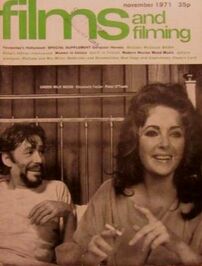
A copy of the monthly British film magazine, 'Films And Filming'.
This copy dates from November, 1971 and incorporates a Richard Burton related cover featuring Elizabeth Taylor and Peter O'Toole in an on-set candid moment during the filming of the 1972 Timon Films production of Andrew Sinclair's version of 'Under Milk Wood'.
Aside from the cover photograph, the 1972 film version of 'Under Milk Wood' only gets a brief mention within the pages of this edition relating to the Venice Film Festival of 1971 and a small black and photograph of Talfryn Thomas and Vivien Merchant, in the roles of Mr. and Mrs. Pugh, in a publicity still photograph from the film.
This copy of 'Films And Filming' was issue number 206 and was printed by S. R. Verstage and Sons Limited of Basingstoke on behalf of Hansom Books.
This copy dates from November, 1971 and incorporates a Richard Burton related cover featuring Elizabeth Taylor and Peter O'Toole in an on-set candid moment during the filming of the 1972 Timon Films production of Andrew Sinclair's version of 'Under Milk Wood'.
Aside from the cover photograph, the 1972 film version of 'Under Milk Wood' only gets a brief mention within the pages of this edition relating to the Venice Film Festival of 1971 and a small black and photograph of Talfryn Thomas and Vivien Merchant, in the roles of Mr. and Mrs. Pugh, in a publicity still photograph from the film.
This copy of 'Films And Filming' was issue number 206 and was printed by S. R. Verstage and Sons Limited of Basingstoke on behalf of Hansom Books.
'Photoplay Film Monthly' Magazine, September 1972
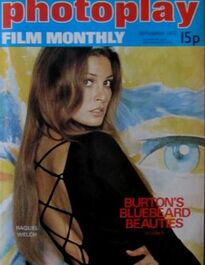
A copy of 'Photoplay Film Monthly' dating from September, 1972, which features a four-page article relating to Racquel Welch and her performance in the 1972 Edward Dmytryck production of 'Bluebeard'.
The article also features rather revealing colour portraits of Richard Burton's other co-stars from the film, Karin Schubert and Marilu Tolo. The article was written by 'Photoplay' journalist, William Hall.
This edition of 'Photoplay' was published by The Argus Press Limited and printed by East Midland Litho Printers Limited, based in Peterborough on behalf of The Illustrated Publications Company Limited.
Other film celebrities featured in this issue include Michael Douglas, Peter Sellers, Peter Finch, Susan George, Peter O'Toole and Jill St. John.
This edition is illustrated throughout with colour and black and white photographs and includes advertisments relating to the film stars of the day and new film releases.
A stunning portrait of Raquel Welch features on the cover for this September, 1972 edition of 'Photoplay Film Monthly'.
The article also features rather revealing colour portraits of Richard Burton's other co-stars from the film, Karin Schubert and Marilu Tolo. The article was written by 'Photoplay' journalist, William Hall.
This edition of 'Photoplay' was published by The Argus Press Limited and printed by East Midland Litho Printers Limited, based in Peterborough on behalf of The Illustrated Publications Company Limited.
Other film celebrities featured in this issue include Michael Douglas, Peter Sellers, Peter Finch, Susan George, Peter O'Toole and Jill St. John.
This edition is illustrated throughout with colour and black and white photographs and includes advertisments relating to the film stars of the day and new film releases.
A stunning portrait of Raquel Welch features on the cover for this September, 1972 edition of 'Photoplay Film Monthly'.
Raquel Welch's performance in 'Bluebeard' as featured in the September, 1972 issue of 'Photoplay Film Monthly'.
'Photoplay Film Monthly' Magazine, November 1973
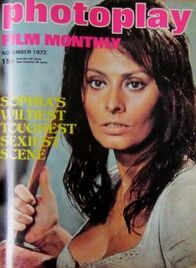
Sophia Loren again features as the cover star for this copy of 'Photoplay Film Monthly' in an issue dating from November, 1973.
Richard Burton features in a review of the 1972 film release of Joseph Losey's film adaption of 'The Assassination of Trotsky', in an article entitled, 'The Moment An Assassin Strikes'.
Other film stars of the day focused upon in this edition include Oliver Reed, Robert Redford, Robert Bolt, Al Pacino and Roger Moore.
This copy of 'Photoplay Film Monthly' is Illustrated throughout with colour and black and white photographs of film stars and advertisments of the day.
This copy of 'Photoplay Film Monthly' was published by The Argus Press Limited for Illustrated Publications Limited, London and printed by East Midland Litho Printers Limited, based in Peterborough.
Richard Burton features in a review of the 1972 film release of Joseph Losey's film adaption of 'The Assassination of Trotsky', in an article entitled, 'The Moment An Assassin Strikes'.
Other film stars of the day focused upon in this edition include Oliver Reed, Robert Redford, Robert Bolt, Al Pacino and Roger Moore.
This copy of 'Photoplay Film Monthly' is Illustrated throughout with colour and black and white photographs of film stars and advertisments of the day.
This copy of 'Photoplay Film Monthly' was published by The Argus Press Limited for Illustrated Publications Limited, London and printed by East Midland Litho Printers Limited, based in Peterborough.
Joseph Losey's 'The Assassination Of Trotsky' article entitled 'The Moment When An Assassin Strikes' which features in the November, 1973 issue of 'Photoplay Film Monthly' Magazine.
'Photoplay Film Monthly' Magazine, May 1973
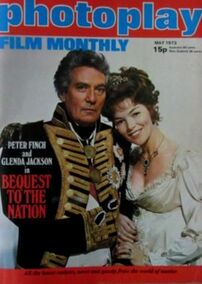
A copy of the May, 1973 issue of 'Photoplay Film Monthly' magazine, featuring a colour cover portrait of Peter Finch and Glenda Jackson promoting the 1973 film, 'Bequest To the Nation'.
This issue includes a four-page article and review of the 1972 Richard Burton film, 'Bluebeard', directed by Edward Dmytryck. The article, which was written by 'Photoplay' journalist Elizabeth Laurence, and subtitled, 'Why Did He Do It?', is illustrated with many still images from the film and includes a partial cast list.
Other film stars of the day featured in this issue include Paul Scofield, Paul Newman, Robert Shaw, George C. Scott, Michael York and Humphrey Bogart.
This copy is illustrated throughout with colour and black and white photographs, articles, reviews and advertisments for new and upcoming films for 1973.
As well as the 'Bluebeard' article, this issue also features a small photograph of Richard Burton in the 'upcoming' film release of 'Massacre In Rome', the title mistakenly called ''Via Rasella', in this early issue.
This copy of 'Photoplay' was published by The Argus Press Limited and printed by East Midland Litho Printers Limited, based in Peterborough.
This issue includes a four-page article and review of the 1972 Richard Burton film, 'Bluebeard', directed by Edward Dmytryck. The article, which was written by 'Photoplay' journalist Elizabeth Laurence, and subtitled, 'Why Did He Do It?', is illustrated with many still images from the film and includes a partial cast list.
Other film stars of the day featured in this issue include Paul Scofield, Paul Newman, Robert Shaw, George C. Scott, Michael York and Humphrey Bogart.
This copy is illustrated throughout with colour and black and white photographs, articles, reviews and advertisments for new and upcoming films for 1973.
As well as the 'Bluebeard' article, this issue also features a small photograph of Richard Burton in the 'upcoming' film release of 'Massacre In Rome', the title mistakenly called ''Via Rasella', in this early issue.
This copy of 'Photoplay' was published by The Argus Press Limited and printed by East Midland Litho Printers Limited, based in Peterborough.
The 'Burton's Bluebeard' article which features in the May, 1973 issue of 'Photoplay Film Monthly'.
'TV Times' Richard Burton and Elizabeth Taylor Cover
'A Night Of Stars', November 1975
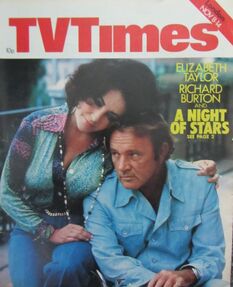
A copy of the British television listings magazine, 'TV Times' dating from the week commencing the 8th of November, 1975.
This issue features a lovely cover photograph of Richard Burton and Elizabeth Taylor.
The cover was used to advertise the screening of 'The Wednesday Night Special - The Evening News British Film Awards' which was being aired on the 12th of November, 1975 for which Burton and Taylor were due to attend.
Featured within the pages of this delightful vintage magazine is an in-depth article relating to the relationship between Richard Burton and Elizabeth Taylor entitled, 'A love story of the incompatible and the inseparable'. The article is illustrated with a wealth of black and white and colour photographic images showcasing the numerous marriages of both Taylor and Burton.
This edition of 'TV Times' magazine was published by Independent Television Publications Limited, based in the Tottenham Court Road, London and was printed by Eric Bemrose Limited, Liverpool.
This edition was number forty-six of volume eighty-one and at the time of publication cost ten pence.
This issue features a lovely cover photograph of Richard Burton and Elizabeth Taylor.
The cover was used to advertise the screening of 'The Wednesday Night Special - The Evening News British Film Awards' which was being aired on the 12th of November, 1975 for which Burton and Taylor were due to attend.
Featured within the pages of this delightful vintage magazine is an in-depth article relating to the relationship between Richard Burton and Elizabeth Taylor entitled, 'A love story of the incompatible and the inseparable'. The article is illustrated with a wealth of black and white and colour photographic images showcasing the numerous marriages of both Taylor and Burton.
This edition of 'TV Times' magazine was published by Independent Television Publications Limited, based in the Tottenham Court Road, London and was printed by Eric Bemrose Limited, Liverpool.
This edition was number forty-six of volume eighty-one and at the time of publication cost ten pence.
The Richard Burton and Elizabeth Taylor article which features in the November, 1975 edition of the 'TV Times'.
'Radio Times' Richard Burton 'Vivat Rex', February 1977
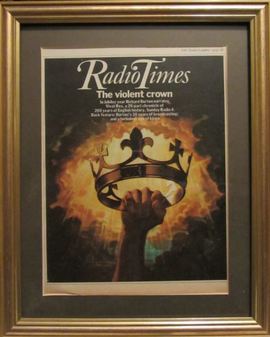
A copy of the Richard Burton related issue of 'Radio Times' dating from the 12th to the 18th of February, 1977.
The striking cover portrait was used to promote the B.B.C. Radio Four, twenty-six part, radio series entitled, 'Vivat Rex', which was written and especially broadcast for the Queen's Silver Jubilee Year.
The epic radio series, powerfully narrated by Richard Burton, was a chronicle of two hundred years of English history and featured the vocal talents of many of the leading actors and actresses of the day.
Also included in this issue is a Richard Burton article focusing on his thirty-year broadcasting relationship with the B.B.C.
This copy of the 'Radio Times' is the London area edition and was printed and published by BBC Publications, Marylebone High Street, London and is issue number 2779.
The striking cover portrait was used to promote the B.B.C. Radio Four, twenty-six part, radio series entitled, 'Vivat Rex', which was written and especially broadcast for the Queen's Silver Jubilee Year.
The epic radio series, powerfully narrated by Richard Burton, was a chronicle of two hundred years of English history and featured the vocal talents of many of the leading actors and actresses of the day.
Also included in this issue is a Richard Burton article focusing on his thirty-year broadcasting relationship with the B.B.C.
This copy of the 'Radio Times' is the London area edition and was printed and published by BBC Publications, Marylebone High Street, London and is issue number 2779.
The Richard Burton article entitled 'Cruel Hearts and Coronets' taken from the February, 1977 issue of the 'Radio Times'.
'Vivat Rex' B.B.C. Radio Four Publicity Booklet, 1977
To celebrate the major historical B.B.C Radio 4 series 'Vivat Rex', the twenty-six part dramatic chronicle of two-hundred years of the English Crown which was narrated by Richard Burton, the B.B.C. published this special companion booklet to accompany the series.
Written by Robert Cushman, who had previously worked for the B.B.C in the radio drama script department and who at that time was the theatre critic for The Observer, the booklet was published by the B.B.C. and was printed by Heffers Printers Limited based in Cambridge.
The booklet features chapters based on each of the twenty-six episodes as well as information on the cast and production team. This special booklet is also illustrated with black and white photographs as well as maps and a family tree tracing the history of the Royal Houses from the reigns of Edward II to Henry VIII.
The back cover oif the booklet features photographs of some of the cast members involved in the recording of 'Vivat Rex', including Richard Burton, John Hurt, Michael Redgrave, Robert Hardy, Derek Jacobi, Timothy West, Peggy Ashcroft, Nigel Stock, Paul Eddington and Keith Michell.
The booklet was published in 1977 and was issued with the ISBN 0-563-17259-2.
For extensive details on the B.B.C. Radio 4 drama series 'Vivat Rex' please visit the 'Burton At The BBC' and 'Recordings' pages on this website.
Written by Robert Cushman, who had previously worked for the B.B.C in the radio drama script department and who at that time was the theatre critic for The Observer, the booklet was published by the B.B.C. and was printed by Heffers Printers Limited based in Cambridge.
The booklet features chapters based on each of the twenty-six episodes as well as information on the cast and production team. This special booklet is also illustrated with black and white photographs as well as maps and a family tree tracing the history of the Royal Houses from the reigns of Edward II to Henry VIII.
The back cover oif the booklet features photographs of some of the cast members involved in the recording of 'Vivat Rex', including Richard Burton, John Hurt, Michael Redgrave, Robert Hardy, Derek Jacobi, Timothy West, Peggy Ashcroft, Nigel Stock, Paul Eddington and Keith Michell.
The booklet was published in 1977 and was issued with the ISBN 0-563-17259-2.
For extensive details on the B.B.C. Radio 4 drama series 'Vivat Rex' please visit the 'Burton At The BBC' and 'Recordings' pages on this website.
'Woman' Magazine Suzy Hunt Interview, September 1977
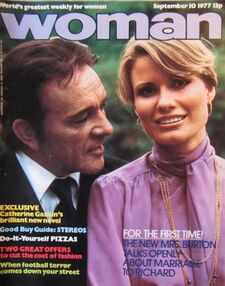
A vintage copy of the iconic women's 'Lifestyle' weekly magazine, 'Woman'.
This issue dates from the week commencing September the 10th, 1977.
The magazine features a lovely portrait of Richard Burton and his new wife Suzy Hunt on the cover, captured by 'Woman' magazine photographer, Brian Moody, and includes a wonderfully candid and in-depth interview with her inside.
The article, entitled, 'If you knew Suzy, like I know Suzy', was written by 'Woman' magazine journalist Romany Bain, the only writer invited by Suzy Hunt to talk exclusively about their sensational marriage.
The article is illustrated with six colour and black and white photographs.
'Woman' magazine was published by IPC Magazines Limited based at the King's Reach Tower, London and was printed by Odhams (Watford) Limited.
This particular edition of 'Woman' magazine was number 2093 of volume eighty-one.
At the time of publication the magazine cost thirteen pence.
This issue dates from the week commencing September the 10th, 1977.
The magazine features a lovely portrait of Richard Burton and his new wife Suzy Hunt on the cover, captured by 'Woman' magazine photographer, Brian Moody, and includes a wonderfully candid and in-depth interview with her inside.
The article, entitled, 'If you knew Suzy, like I know Suzy', was written by 'Woman' magazine journalist Romany Bain, the only writer invited by Suzy Hunt to talk exclusively about their sensational marriage.
The article is illustrated with six colour and black and white photographs.
'Woman' magazine was published by IPC Magazines Limited based at the King's Reach Tower, London and was printed by Odhams (Watford) Limited.
This particular edition of 'Woman' magazine was number 2093 of volume eighty-one.
At the time of publication the magazine cost thirteen pence.
The Suzy Hunt interview which features in the September, 1977 issue of the 'Lifestyle' magazine, 'Woman'.
'Films Illustrated' Magazine, September 1977
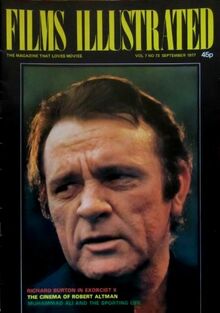
A copy of the British film magazine 'Films Illustrated' dating from September 1977.
Two interesting Richard Burton articles feature in this edition relating to possibly the worst and probably the best films of his career, namely, 'Exorcist II: The Heretic' and 'Equus'.
Both articles feature black and white still images from the two films.
The stunning colour cover portrait of Richard Burton was taken from the Columbia / Warner Bros. film, 'Exorcist II : The Heretic'.
Aside from the articles a full page advertisment for the premiere of 'Exorcist II : The Heretic' features in this edition.
Unrelated Richard Burton items in this copy of 'Films Illustrated' include articles on the Muhammed Ali biopic, 'The Greatest', Elliot Gould, Robert Altman and Norma Shearer.
'Films illustrated' was published by Independent Magazines Limited and was published by Exallprint Limited, Tunbridge Wells, Kent.
Two interesting Richard Burton articles feature in this edition relating to possibly the worst and probably the best films of his career, namely, 'Exorcist II: The Heretic' and 'Equus'.
Both articles feature black and white still images from the two films.
The stunning colour cover portrait of Richard Burton was taken from the Columbia / Warner Bros. film, 'Exorcist II : The Heretic'.
Aside from the articles a full page advertisment for the premiere of 'Exorcist II : The Heretic' features in this edition.
Unrelated Richard Burton items in this copy of 'Films Illustrated' include articles on the Muhammed Ali biopic, 'The Greatest', Elliot Gould, Robert Altman and Norma Shearer.
'Films illustrated' was published by Independent Magazines Limited and was published by Exallprint Limited, Tunbridge Wells, Kent.
The 'Exorcist II : The Heretic' and 'Equus' articles which feature in the September, 1977 issue of 'Films Illustrated'
'Sunday Express' Magazine, September 1984
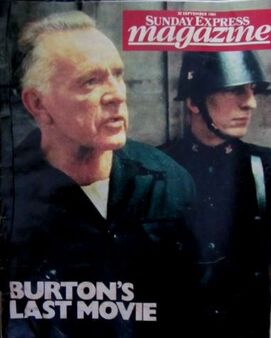
A copy of the British national newspaper weekend publication, the Sunday Express Magazine, dating from September the 30th, 1984. This edition features a still image of Richard Burton in his last screen role as the menacing interrogator O' Brien in Michael Radford's production of George Orwell's 'Nineteen Eighty-Four'.
The article which features in this issue, entitled 'Burton's Last Film', was written by Richard Burton and Dylan Thomas biographer, Paul Ferris, and includes colour images from the film.
The magazine was published and printed by Express Newspapers PLC, Fleet Street, London.
The article which features in this issue, entitled 'Burton's Last Film', was written by Richard Burton and Dylan Thomas biographer, Paul Ferris, and includes colour images from the film.
The magazine was published and printed by Express Newspapers PLC, Fleet Street, London.
A Selection of Film Related Paperback Novels
James Maurice Scott, 'Sea Wife'
Crest Books, First Edition Paperback Copy, 1957
A first edition American paperback edition, with a 'movie tie-in' cover, of the James Maurice Scott novel, 'Sea Wife'. The novel was originally published in hardback, under the title, 'Sea-Wyf and Biscuit' by E. P. Dutton and Company in 1955.
This paperback edition was published by Crest Books, a division of Fawcett Publications Incorporated in March, 1957 with a cover featuring Richard Burton and Joan Collins from the Twentieth Century Fox production, 'Sea Wife'.
Reviews of the original novel read;
"The most compelling and inescapable start I have encountered in a suspense novel in some years...He has launched his book so superbly that we doubt if you'll be able to refrain from reading right through to the end."...The New York Times
"A Thrilling and melodramatic sea story...All the melodrama that could be packed into a tale of the sea will be found in this unusual story which packs a hidden wallop at the end. If you're looking for action and suspense, danger and high romance, 'Seawife' is your dish."...The Pittsburgh Press
"The book has everything necessary to an armchair excursion into the unusual. It has an ending that would do credit to a well-constructed mystery story...the writing is brilliant. The result is a book you should not miss."...The Springfield Daily News
"It would not be fair to the reader of this tempestuous and absorbing book to reveal the secret, but Mr. Scott manages with astonishing dexterity to sustain the suspense to the last sentence, an accomplishment which proves he is one of England's best storytellers."...The Saturday Review
"Any story about fourteen weeks spent by three men and a woman on a raft in the Indian Ocean has all the makings of drama, but in the hands of J. M. Scott it proves to be a tale of suspense and human reactions seldom equalled."...Fort Wayne News Sentinel.
This paperback edition was published by Crest Books, a division of Fawcett Publications Incorporated in March, 1957 with a cover featuring Richard Burton and Joan Collins from the Twentieth Century Fox production, 'Sea Wife'.
Reviews of the original novel read;
"The most compelling and inescapable start I have encountered in a suspense novel in some years...He has launched his book so superbly that we doubt if you'll be able to refrain from reading right through to the end."...The New York Times
"A Thrilling and melodramatic sea story...All the melodrama that could be packed into a tale of the sea will be found in this unusual story which packs a hidden wallop at the end. If you're looking for action and suspense, danger and high romance, 'Seawife' is your dish."...The Pittsburgh Press
"The book has everything necessary to an armchair excursion into the unusual. It has an ending that would do credit to a well-constructed mystery story...the writing is brilliant. The result is a book you should not miss."...The Springfield Daily News
"It would not be fair to the reader of this tempestuous and absorbing book to reveal the secret, but Mr. Scott manages with astonishing dexterity to sustain the suspense to the last sentence, an accomplishment which proves he is one of England's best storytellers."...The Saturday Review
"Any story about fourteen weeks spent by three men and a woman on a raft in the Indian Ocean has all the makings of drama, but in the hands of J. M. Scott it proves to be a tale of suspense and human reactions seldom equalled."...Fort Wayne News Sentinel.
Marvin H. Albert, 'The V.I.P.s'
Mayflower Bell Books, First Edition Paperback Copy, 1963
A first edition copy, in paperback, of the Marvin H. Albert novel, 'The V.I.P.s'
This edition was published by Mayflower Bell Books Limited, Vauxhall Bridge Road, London in 1963 and features a 'movie tie-in' cover featuring Richard Burton and Elizabeth Taylor in the roles of Paul and Frances Andros from the Metro-Goldwyn-Mayer film of the same name.
This paperback edition was printed by Hunt, Barnard and Company, based in Aylesbury, Buckinghamshire.
The cover notes for this edition read;
Very Important Persons. The World's richest shipping magnate...His beautiful American wife...A jet-set playboy...A self-made tycoon and his ever-present secretary...A famous movie star and the producer who created her. Some very special, very influential persons suddenly thrown together in a London airport for a few explosive hours that would change all of them for all time.
This edition was published by Mayflower Bell Books Limited, Vauxhall Bridge Road, London in 1963 and features a 'movie tie-in' cover featuring Richard Burton and Elizabeth Taylor in the roles of Paul and Frances Andros from the Metro-Goldwyn-Mayer film of the same name.
This paperback edition was printed by Hunt, Barnard and Company, based in Aylesbury, Buckinghamshire.
The cover notes for this edition read;
Very Important Persons. The World's richest shipping magnate...His beautiful American wife...A jet-set playboy...A self-made tycoon and his ever-present secretary...A famous movie star and the producer who created her. Some very special, very influential persons suddenly thrown together in a London airport for a few explosive hours that would change all of them for all time.
John Le Carre, 'The Spy Who Came In From The Cold'
Pan Books, Paperback Edition, Fourth Impression, 1965
A copy of the U.K. paperback edition of John Le Carre's Cold War spy thriller, 'The Spy Who Came In From The Cold'.
Previously published by Victor Gollancz Limited, this edition was published by Pan Books Limited, Headfort Place, London and printed by The Chaucer Press, based in Suffolk, in 1965.
This fourth edition copy features a 'movie tie-in' cover, incorporating colour photographs of Richard Burton, Claire Bloom and Oskar Werner from the Paramount Pictures / Salem films production of the film of the same name.
The price of this edition on publication in 1965 was five shillings.
'The Spy Who Came In From The Cold' was the third novel from award-winning author, John Le Carre, a former operative of the British Intelligence Services, MI5 and MI6.
The book itself has won many awards since it's first publication, including a 'Gold Dagger Award' from the British Crime Writers Association in 1963 and an 'Edgar' award from the Mystery Writers of America in 1965.
In 2005 the book was awarded the 'Dagger of Daggers' and was also voted as one of the 'All Time One-Hundred Novels' by Time Magazine.
Contemporary reviews included in this 1965 Pan Books edition read;
"This is really it - the spy story that stands quite alone, on a peak of achievement so remote from contemporary writing in the genre that any comparisons would be irrelevant. It is also a serious novel of political importance. There is a chilling authenticity about it; one feels that here truly are the monstrous realities behind the news paragraphs which record the shifts and tensions of the Cold War...The climax combines chair-edge excitements with Leamas's last moving gesture of affirmation for the only loyalty left." The Scotsman.
"Mr.John Le Carre has a remarkable gift for evoking, sustaining and communicating to his readers the moods of deep despair and high suspense. His new novel is a topical and terrible story of an English agent...This is the bare framework of Mr.Le Carre's complex and fearful tale, which he tells with a skill which seems to me to be unique in this sphere. He can set the mood of a city, a library or a prison so that each is as clear as a film set. He can communicate emotion, from sweating fear to despairing love, with terse and compassionate conviction. Above all, he can tell a tale. Formidable equipment for a rare and disturbing writer." The Sunday Times.
"We have heard a great deal about modern methods of espionage. The singular beastliness of the whole affair hits one as with a hammer in the last pages of this truly terrible story about an unsuccessful British agent...The trial scene is magnificent, and the real fiendishness of the plot came to me as a horrifying surprise. The cold of these pages really freezes me." The Illustrated London News.
J. B. Priestley was to write of John Le Carre's novel,'The Spy Who Came In From The Cold';
"Superbly constructed, with the atmosphere of chilly hell".
Previously published by Victor Gollancz Limited, this edition was published by Pan Books Limited, Headfort Place, London and printed by The Chaucer Press, based in Suffolk, in 1965.
This fourth edition copy features a 'movie tie-in' cover, incorporating colour photographs of Richard Burton, Claire Bloom and Oskar Werner from the Paramount Pictures / Salem films production of the film of the same name.
The price of this edition on publication in 1965 was five shillings.
'The Spy Who Came In From The Cold' was the third novel from award-winning author, John Le Carre, a former operative of the British Intelligence Services, MI5 and MI6.
The book itself has won many awards since it's first publication, including a 'Gold Dagger Award' from the British Crime Writers Association in 1963 and an 'Edgar' award from the Mystery Writers of America in 1965.
In 2005 the book was awarded the 'Dagger of Daggers' and was also voted as one of the 'All Time One-Hundred Novels' by Time Magazine.
Contemporary reviews included in this 1965 Pan Books edition read;
"This is really it - the spy story that stands quite alone, on a peak of achievement so remote from contemporary writing in the genre that any comparisons would be irrelevant. It is also a serious novel of political importance. There is a chilling authenticity about it; one feels that here truly are the monstrous realities behind the news paragraphs which record the shifts and tensions of the Cold War...The climax combines chair-edge excitements with Leamas's last moving gesture of affirmation for the only loyalty left." The Scotsman.
"Mr.John Le Carre has a remarkable gift for evoking, sustaining and communicating to his readers the moods of deep despair and high suspense. His new novel is a topical and terrible story of an English agent...This is the bare framework of Mr.Le Carre's complex and fearful tale, which he tells with a skill which seems to me to be unique in this sphere. He can set the mood of a city, a library or a prison so that each is as clear as a film set. He can communicate emotion, from sweating fear to despairing love, with terse and compassionate conviction. Above all, he can tell a tale. Formidable equipment for a rare and disturbing writer." The Sunday Times.
"We have heard a great deal about modern methods of espionage. The singular beastliness of the whole affair hits one as with a hammer in the last pages of this truly terrible story about an unsuccessful British agent...The trial scene is magnificent, and the real fiendishness of the plot came to me as a horrifying surprise. The cold of these pages really freezes me." The Illustrated London News.
J. B. Priestley was to write of John Le Carre's novel,'The Spy Who Came In From The Cold';
"Superbly constructed, with the atmosphere of chilly hell".
Edward Albee, 'Who's Afraid Of Virginia Woolf?'
Penguin Books Limited, 1967
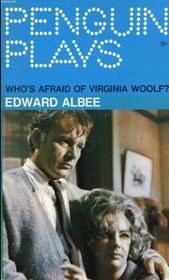
An early edition of the text to Edward Albee's controversial 1962 play, 'Who's Afraid Of Virginia Woolf?'
This paperback edition was issued with a colour 'movie tie-in' cover featuring Richard Burton and Elizabeth Taylor in the roles of George and Martha from the Ernest Lehman 1966 film adaption.
This copy of the text to 'Who's Afraid Of Virginia Woolf?' was published in 1967 by Penguin Books Limited, based in Harmondsworth, Middlesex, in conjunction with Jonathan Cape as part of their 'Penguin Plays' series of paperbacks.
This edition was printed by the Western Printing Services Limited based in Bristol.
Contemporary reviews included in this edition include;
"It has established Albee in the world's mind as the proper successor to Tennessee Williams and Arthur Miller." Bamber Gascoigne writing in the Observer Weekend Review
"Has an intensity, a demoniac misery, a ferocious humour, an ability to rend and tear and crucify to a degree unfamiliar in the English theatre...no one can remain indifferent to its power, its resilience of ideas and its range of language". Harold Hobson writing in the Sunday Times Weekend Review.
This paperback edition was issued with a colour 'movie tie-in' cover featuring Richard Burton and Elizabeth Taylor in the roles of George and Martha from the Ernest Lehman 1966 film adaption.
This copy of the text to 'Who's Afraid Of Virginia Woolf?' was published in 1967 by Penguin Books Limited, based in Harmondsworth, Middlesex, in conjunction with Jonathan Cape as part of their 'Penguin Plays' series of paperbacks.
This edition was printed by the Western Printing Services Limited based in Bristol.
Contemporary reviews included in this edition include;
"It has established Albee in the world's mind as the proper successor to Tennessee Williams and Arthur Miller." Bamber Gascoigne writing in the Observer Weekend Review
"Has an intensity, a demoniac misery, a ferocious humour, an ability to rend and tear and crucify to a degree unfamiliar in the English theatre...no one can remain indifferent to its power, its resilience of ideas and its range of language". Harold Hobson writing in the Sunday Times Weekend Review.
Alistair MacLean, 'Where Eagles Dare'
Fawcett Crest Books, Second Impression Paperback, 1969
Originally published in 1967 by Cymbeline Productions Limited, this is a second edition in paperback format of the Alistair MacLean, World War II thriller entitled, 'Where Eagles Dare'.
This copy was published in America by Fawcett Crest Books in April, 1969 and printed by the Fawcett World Library based in New York.
This edition features a 'Movie tie-in' cover complete with details of the Metro-Goldwyn-Mayer film, 'Where Eagles Dare', and includes black and white photographs of Richard Burton, Clint Eastwood and Mary Ure on the reverse of the cover.
Alistair MacLean was a Scottish author, born in 1922, who was best known for the thrillers 'The Guns Of Navarone', 'Ice Station Zebra', 'The Satan Bug' and 'When Eight Bells Toll'.
'Where Eagles Dare' was written both as a screenplay and a novel at the same time, and was personally commissioned by Richard Burton.
Alistair MacLean died in Munich in 1987 and is buried just a few yards from Richard Burton's headstone in the small graveyard located in Celigny, Switzerland.
This copy was published in America by Fawcett Crest Books in April, 1969 and printed by the Fawcett World Library based in New York.
This edition features a 'Movie tie-in' cover complete with details of the Metro-Goldwyn-Mayer film, 'Where Eagles Dare', and includes black and white photographs of Richard Burton, Clint Eastwood and Mary Ure on the reverse of the cover.
Alistair MacLean was a Scottish author, born in 1922, who was best known for the thrillers 'The Guns Of Navarone', 'Ice Station Zebra', 'The Satan Bug' and 'When Eight Bells Toll'.
'Where Eagles Dare' was written both as a screenplay and a novel at the same time, and was personally commissioned by Richard Burton.
Alistair MacLean died in Munich in 1987 and is buried just a few yards from Richard Burton's headstone in the small graveyard located in Celigny, Switzerland.
Alistair MacLean, 'Where Eagles Dare'
Collins / Fontana Books, First Edition Paperback, 1969
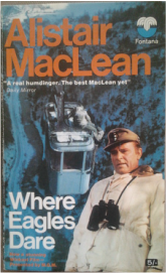
A first edition copy, published in paperback by Collins / Fontana Books, of the Alistair MacLean thrilling World War II novel, 'Where Eagles Dare'.
The book was first published in this format by Collins / Fontana Books and was printed in the U.K. by Cymbeline Productions Limited in 1969.
This edition features a 'movie tie-in' cover which includes two photographs of Richard Burton taken from the 1969 film.
Two contemporary reviews of the book version of 'Where Eagles Dare' are reproduced on the back cover of this paperback edition, from the New York Times and the Liverpool Echo respectively;
"There is a splendid audacity about Where Eagles Dare in which a handful of British agents invade an 'impenetrable' Gestapo command post...MacLean offers a real dazzler of a thriller, with vivid action. fine set pieces of suspense, and a virtuoso display of startling plot twists."
"Alistair MacLean has done it again; produced another king-sized thriller of tremendous pace and excitement. The tension is almost unbearable at times, but you can't stop turning the pages in a feverish desire to know what happens next."
The publishers short synopsis of the book, included in the front-end papers, reads;
"One winter night seven men and a girl are parachuted on to a mountainside in wartime Germany. Their objective? An apparently inaccessible castle, headquarters of the Gestapo, to which a crashed VIP American general has been taken for interrogation. Or is this audacious rescue the sole reason for the expedition?
'Where Eagles Dare' has all the ingenuity, physical excitement (literally, this time) cliff-hanging suspense that one has come to expect from a top-flight Alistair MacLean."
The book was first published in this format by Collins / Fontana Books and was printed in the U.K. by Cymbeline Productions Limited in 1969.
This edition features a 'movie tie-in' cover which includes two photographs of Richard Burton taken from the 1969 film.
Two contemporary reviews of the book version of 'Where Eagles Dare' are reproduced on the back cover of this paperback edition, from the New York Times and the Liverpool Echo respectively;
"There is a splendid audacity about Where Eagles Dare in which a handful of British agents invade an 'impenetrable' Gestapo command post...MacLean offers a real dazzler of a thriller, with vivid action. fine set pieces of suspense, and a virtuoso display of startling plot twists."
"Alistair MacLean has done it again; produced another king-sized thriller of tremendous pace and excitement. The tension is almost unbearable at times, but you can't stop turning the pages in a feverish desire to know what happens next."
The publishers short synopsis of the book, included in the front-end papers, reads;
"One winter night seven men and a girl are parachuted on to a mountainside in wartime Germany. Their objective? An apparently inaccessible castle, headquarters of the Gestapo, to which a crashed VIP American general has been taken for interrogation. Or is this audacious rescue the sole reason for the expedition?
'Where Eagles Dare' has all the ingenuity, physical excitement (literally, this time) cliff-hanging suspense that one has come to expect from a top-flight Alistair MacLean."
Edward Fenton, 'Anne Of The Thousand Days'
Signet Books, Third Impression Paperback, 1970
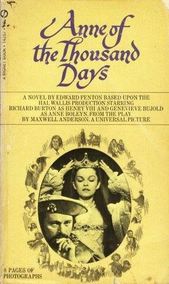
An American paperback copy of the novel by Edward Fenton based on the screenplay, originally written by John Hale and Bridget Boland, of the 1970 Award-winning film adaption of 'Anne Of The Thousand Days'.
"He was the King, and he wanted her. He vowed she would be Queen of England. She swore she would give him a son to follow him as King. It was a contract of passion, written in blood - an arrangement of love that shook England and changed the world."
The original screenplay was itself based on the play written by Maxwell Anderson.
This third impression, American copy, of Edward Fenton's novel was published in April 1970 by Signet Books, a division of the New American Library, New York, and was published by arrangement with Universal Pictures, the distributors for the Hal Wallis production of the film which starred Richard Burton, Genevieve Bujold and Anthony Quayle.
This copy features a 'Movie tie-in' cover featuring Richard Burton and Genevieve Bujold as well as eight pages of black and white images taken directly from the film adaption.
The back cover to this American publication features the famous line from the film;
"I've stabbed and fought and clawed...I've looted and plundered...ripped and torn the bodies of my friends...to find the heart of the woman I love."
"He was the King, and he wanted her. He vowed she would be Queen of England. She swore she would give him a son to follow him as King. It was a contract of passion, written in blood - an arrangement of love that shook England and changed the world."
The original screenplay was itself based on the play written by Maxwell Anderson.
This third impression, American copy, of Edward Fenton's novel was published in April 1970 by Signet Books, a division of the New American Library, New York, and was published by arrangement with Universal Pictures, the distributors for the Hal Wallis production of the film which starred Richard Burton, Genevieve Bujold and Anthony Quayle.
This copy features a 'Movie tie-in' cover featuring Richard Burton and Genevieve Bujold as well as eight pages of black and white images taken directly from the film adaption.
The back cover to this American publication features the famous line from the film;
"I've stabbed and fought and clawed...I've looted and plundered...ripped and torn the bodies of my friends...to find the heart of the woman I love."
James Barlow, 'The Burden Of Proof' / 'Villain'
Pan Books Limited, Paperback Second Edition, 1971
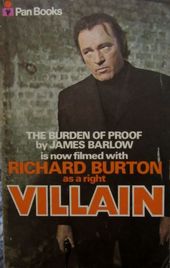
First published in 1968 by Hamish Hamilton Limited under the original title of 'The Burden Of Proof', this is the second printing of the Pan Books Limited paperback edition of James Barlow's gritty London gangster novel, re-titled 'Villain' to tie-in with the 1971 Metro-Goldwyn-Mayer film adaption.
This copy was published by Pan Books Limited, Tothill Street, London and printed by Cox and Wyman, based in Reading, Berkshire in 1971 and was issued by Pan Books with the ISBN 0-330-02574-0.
This edition features a colour image of Richard Burton on the front cover taken from the 1971 Metro-Goldwyn-Mayer film, 'Villain', plus four small photographic 'still' images from the film on the reverse.
Contemporary reviews for the novel include such high praise as;
"A wild and dizzy tale of crime and vice". The New Yorker.
"Violent and highly sensational". Punch.
"One of the best crime stories I have ever read - ingeniously plotted, fast-moving, written with insight, sympathy and uncanny authenticity... studded with horrific close-ups of vicious beatings-up". The Sunday Telegraph.
The screenplay for the film, adapted directly from this novel, was written by Dick Clement and Ian La Frenais, best known for their collaboration on scripts for such classic television shows as 'The Likely Lads', 'The Two Ronnies', 'Porridge', and the acclaimed, 'Auf Wiedersehen, Pet'.
James Barlow, the author of thirteen novels and one work of non-fiction, was born in Birmingham in 1921. Travelling extensively during his childhood, including some years spent in Wales due to his father's work, he eventually settled back in The Midlands where he attended college before joining the R.A.F. during the Second World War as a rear-gunner before being invalided-out due to contracting tuberculosis. During his convalescence he discovered a talent for writing, primarily for aircraft magazines, before moving on to the gritty, realistic, contemporary novels he became known for. His first novel which was entitled, 'The Protagonists' drew heavily on his formative years in Wales and his recovery from T.B.
James Barlow wrote prolifically during the years 1960 until 1971, during which time he moved with his family to Tasmania before finally settling in Ireland. 'The Burden Of Proof' was to be his last novel as James Barlow died suddenly in Cork on the 30th of January 1973 aged just fifty-one years old.
'The Spectator' was to write of the author;
"James Barlow is one of the most able thriller writers in the business, with an alarmingly acute eye for the degenerate quirks of society."
This copy of the 'Villain' edition of 'The Burden Of Proof' was kindly donated to the Richard Burton Museum by Jeff Towns, Christmas, 2015.
This copy was published by Pan Books Limited, Tothill Street, London and printed by Cox and Wyman, based in Reading, Berkshire in 1971 and was issued by Pan Books with the ISBN 0-330-02574-0.
This edition features a colour image of Richard Burton on the front cover taken from the 1971 Metro-Goldwyn-Mayer film, 'Villain', plus four small photographic 'still' images from the film on the reverse.
Contemporary reviews for the novel include such high praise as;
"A wild and dizzy tale of crime and vice". The New Yorker.
"Violent and highly sensational". Punch.
"One of the best crime stories I have ever read - ingeniously plotted, fast-moving, written with insight, sympathy and uncanny authenticity... studded with horrific close-ups of vicious beatings-up". The Sunday Telegraph.
The screenplay for the film, adapted directly from this novel, was written by Dick Clement and Ian La Frenais, best known for their collaboration on scripts for such classic television shows as 'The Likely Lads', 'The Two Ronnies', 'Porridge', and the acclaimed, 'Auf Wiedersehen, Pet'.
James Barlow, the author of thirteen novels and one work of non-fiction, was born in Birmingham in 1921. Travelling extensively during his childhood, including some years spent in Wales due to his father's work, he eventually settled back in The Midlands where he attended college before joining the R.A.F. during the Second World War as a rear-gunner before being invalided-out due to contracting tuberculosis. During his convalescence he discovered a talent for writing, primarily for aircraft magazines, before moving on to the gritty, realistic, contemporary novels he became known for. His first novel which was entitled, 'The Protagonists' drew heavily on his formative years in Wales and his recovery from T.B.
James Barlow wrote prolifically during the years 1960 until 1971, during which time he moved with his family to Tasmania before finally settling in Ireland. 'The Burden Of Proof' was to be his last novel as James Barlow died suddenly in Cork on the 30th of January 1973 aged just fifty-one years old.
'The Spectator' was to write of the author;
"James Barlow is one of the most able thriller writers in the business, with an alarmingly acute eye for the degenerate quirks of society."
This copy of the 'Villain' edition of 'The Burden Of Proof' was kindly donated to the Richard Burton Museum by Jeff Towns, Christmas, 2015.
Edward Albee, 'Who's Afraid Of Virginia Woolf?'
Penguin Books 'Plays Edition', 1981
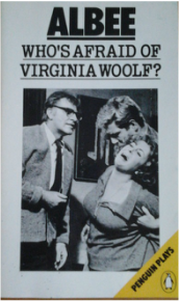
Originally published in 1962, this is a much later paperback edition of Edward Albee's play, 'Who's Afraid Of Virginia Woolf?', which dates from 1981 and features a 'movie tie-in' cover photograph of Richard Burton, Elizabeth Taylor and George Segal taken from the 1966 Warner Brothers film of the same name.
This edition was published by Penguin Books and printed by Cox and Wyman Limited, based in Reading, Berkshire.
This copy was published as part of the 'Penguin Plays' series of paperback editions.
The play, written by Pulitzer Prize winning dramatist Edward Albee, won the 1963 Tony Award as well as The New York Drama Critics Circle Award for 1962-'63.
A review, written by Harold Hobson of The Sunday Times, stated that;
"(The play), has an intensity, a demonic misery, a ferocious humour...no one can remain indifferent to its power, its resilience of ideas and its range of language."
Alan Brien, writing for The Sunday Telegraph, went on to say of the text;
"A frighteningly well-observed picture of a matrimonial corrida, with the scarred and bloody husband at last taking the cow by the horns after a long, liquor-logged evening."
This edition was published by Penguin Books and printed by Cox and Wyman Limited, based in Reading, Berkshire.
This copy was published as part of the 'Penguin Plays' series of paperback editions.
The play, written by Pulitzer Prize winning dramatist Edward Albee, won the 1963 Tony Award as well as The New York Drama Critics Circle Award for 1962-'63.
A review, written by Harold Hobson of The Sunday Times, stated that;
"(The play), has an intensity, a demonic misery, a ferocious humour...no one can remain indifferent to its power, its resilience of ideas and its range of language."
Alan Brien, writing for The Sunday Telegraph, went on to say of the text;
"A frighteningly well-observed picture of a matrimonial corrida, with the scarred and bloody husband at last taking the cow by the horns after a long, liquor-logged evening."
Miscellaneous Richard Burton Related Books
Gethin Matthews, 'Richard Burton - Seren Cymru'
The Gomer Press, First Edition, 2002
A first edition copy, published in paperback, of the Gethin Matthews Welsh language biography entitled, 'Richard Burton - Seren Cymru', (Richard Burton - Star of Wales).
This edition was first published by The Gomer Press based in Llandysul, Ceredigion, Wales in 2002 and issued with the ISBN 1-84323-060-7.
This edition is published entirely in Welsh.
This edition is illustrated with some lovely, rare photographs including an image of the front cover of an autographed programme for 'Gallows Glorious' which was staged by The Port Talbot Secondary School in November, 1942 and which is probably the first amateur acting production Richard Jenkins was involved with, under the supervision and guidance of Philip Burton.
Also included are some lovely family photographs, supplied by the Jenkins family, as well as various photographs which appear courtesy of Harlech Television which includes a wonderful image of Richard Burton with Hugh Griffith in Stratford-Upon-Avon in 1951 as well as images of an older Burton on return visits to Pontrhydyfen and Taibach with Elizabeth Taylor and Suzy Hunt in 1968 and 1976 respectively.
The early Richard Burton autograph which appears on this facsimile of the 1942 'Gallows Glorious' programme is located just above the title of the play, signed as Richard Jenkins.
This edition was first published by The Gomer Press based in Llandysul, Ceredigion, Wales in 2002 and issued with the ISBN 1-84323-060-7.
This edition is published entirely in Welsh.
This edition is illustrated with some lovely, rare photographs including an image of the front cover of an autographed programme for 'Gallows Glorious' which was staged by The Port Talbot Secondary School in November, 1942 and which is probably the first amateur acting production Richard Jenkins was involved with, under the supervision and guidance of Philip Burton.
Also included are some lovely family photographs, supplied by the Jenkins family, as well as various photographs which appear courtesy of Harlech Television which includes a wonderful image of Richard Burton with Hugh Griffith in Stratford-Upon-Avon in 1951 as well as images of an older Burton on return visits to Pontrhydyfen and Taibach with Elizabeth Taylor and Suzy Hunt in 1968 and 1976 respectively.
The early Richard Burton autograph which appears on this facsimile of the 1942 'Gallows Glorious' programme is located just above the title of the play, signed as Richard Jenkins.
Christopher Downing, 'Burton Stories'
Futura Publications, First Edition, 1990
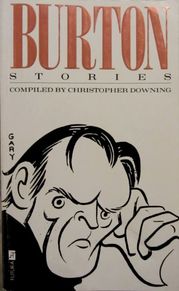
A first edition paperback which comprises of a delightful collection of anecdotes, stories, reminiscences and recollections told by, or relating to, Richard Burton. This collection was meticulously compiled by actor and writer, Christopher Downing.
Included in this charming and extremely amusing book are reviews which relate to both Richard Burton's earliest triumphant theatrical performances and his later, less successful, film roles.
The chapters included in this book are devoted to such topics as; Childhood, Acting, Alcohol, Elizabeth Taylor and Cleopatra, Success and Critics.
This first edition copy was published in 1990 by Futura Publications, a division of Macdonald and Company Limited which is based in London and Sydney.
This edition was printed by BPCC Hazell Books based in Aylesbury, Buckinghamshire and issued with the ISBN 0-0788-4551-7.
The front cover caricature of Richard Burton was drawn by Daily Mail and Sunday Times cartoonist, Gary Smith.
The introduction to this collection, written by Christopher Downing, reads;
"It is a truth universally acknowledged that a Welshman in possession of an audience of at least one, a pint of best and a complete set of vocal chords can never be in want of something to say. Richard Burton was as Welsh as they come and loved to tell stories. his large, but exhaustible, fund featured fellow actors, Hollywood producers, West End directors, tales of Welsh childhood, political leaders, and members of the Royal Family. Embroidered over the years, they underwent a subtle evolution, occasionally changing emphasis completely by the tenth or twelfth year of telling.
A slavish adherence to cold fact rarely got in the way of a good yarn. He regaled an interviewer on board his yacht, 'Kalizma' with the story of how his father lost a leg in a mining accident underground but nevertheless carried on cutting coal until retirement and remained as strong as a pit pony and an awesome drinker. Fellow countryman and actor Stanley Baker, also a guest on board, listened with mounting annoyance and disbelief until he burst out; "That wasn't your father, you bastard - that was mine!"
Burton turned to him and said calmly; "What does it matter whose father it was?" The interview continued as if nothing had happened.
Burton fostered a wealth of anecdotes featuring his own wide-screen, technicolour, life-story. He was a gift to any reporter with nous enough to sit him down with a drink in his hand and switch on the tape recorder. He delighted in words and wallowed in his ability to entertain, amuse and shock. Brenda Maddox in her book 'Who's Afraid Of Elizabeth Taylor?' comments that, 'it is not really fair to quote Richard Burton because he is so eloquent and garrulous that he can be found to have said almost anything'. Fair or not, his words appear frequently because he was so eminently quotable, on anything from the magnificence of Elizabeth Taylor's breasts to the nature of Winston Churchill's crimes in the class war.
The Burton industry is extensive, particularly if the relevant parts of the Elizabeth Taylor story are appended. The inner workings of the boy from the valleys made spectacularly good continue to fascinate many, partly because stars just don't seem to exist in the same mould anymore - or, if they do, they receive nothing like same amount of publicity. At the height of fame during the early years of his marriage to Elizabeth Taylor, Burton generated more headlines than international affairs of state. He was quoted in the press, on television and, such was his notoriety after the Cleopatra scandal, questions were raised in the Senate in a bid to revoke his visa as an undesirable and corrupting influence on American society.
It is worth emphasising that Burton was not simply an over-publicised member of the jet-set. For all the scathing notices the vast majority of his films received, he was an extremely talented actor of huge promise. Six years after his first professional job, he became, at twenty-three, one of the youngest ever Hamlets at the Old Vic. He has been compared with Edmund Kean, Laurence Olivier, John Gielgud, Paul Schofield and, revealingly, John Barrymore. For, like Barrymore, he is seen as a man who squandered his exceptional ability in a quagmire of good living, fame and alcohol.
Success came quickly and in very large measure. Perhaps Burton had it too easy. In the early days, he was tipped as the natural heir to Laurence Olivier's mantle as the greatest living actor. His delighted astonishment at the huge fees he could command in Hollywood for work he despised gradually gave way to an urgent need to make as much as possible before he lost his Midas touch. He then drifted inexorably into a fantastically lucrative filmic mediocrity which, in the end, eroded his talent. It is sad that he is now principally remembered for his two marriages to Elizabeth Taylor, his wealth and, lastly, his voice.
This volume of stories seeks in no way to replace any of the existing literature. Burton deliberately courted fame and controversy, and this book is a compendium of the public aspects of a complex personality. Those with an interest in the complete picture of Richard Burton could do no better than Melvyn Bragg's biography, 'Rich'. This includes unique material from the Burton notebooks, reflecting the private side of a man whose life was lived, for the most part, under the arc lights of popular scrutiny.
Anecdotes of the like that appear in this book are impossible to authenticate. Some exist in several forms, with differences ranging from the odd detail of time or place to a major change of cast. Where this is the case, I have chosen the one that makes the best story, regardless of any factual considerations. Just as paranoiacs sometimes have enemies, apocryphal can often be true. As Philip Burton, Richard's foster father, says of a story in his book, 'Early Doors - My Life in the Theatre', "Whether it is apocryphal I don't know, but it deserves to be true because it is so illuminating."
An further extract of the publishers text from the cover notes reads;
"Richard Burton is often remembered more for his phenomenal drinking and womanising, his extravagant wealth and his tempestuous marriage to Elizabeth Taylor than for his brilliant acting and his marvellous voice. All aspects are covered in this wonderful collection of anecdotes, sayings and impressions of the most fascinating and charismatic actor of our times."
Included in this charming and extremely amusing book are reviews which relate to both Richard Burton's earliest triumphant theatrical performances and his later, less successful, film roles.
The chapters included in this book are devoted to such topics as; Childhood, Acting, Alcohol, Elizabeth Taylor and Cleopatra, Success and Critics.
This first edition copy was published in 1990 by Futura Publications, a division of Macdonald and Company Limited which is based in London and Sydney.
This edition was printed by BPCC Hazell Books based in Aylesbury, Buckinghamshire and issued with the ISBN 0-0788-4551-7.
The front cover caricature of Richard Burton was drawn by Daily Mail and Sunday Times cartoonist, Gary Smith.
The introduction to this collection, written by Christopher Downing, reads;
"It is a truth universally acknowledged that a Welshman in possession of an audience of at least one, a pint of best and a complete set of vocal chords can never be in want of something to say. Richard Burton was as Welsh as they come and loved to tell stories. his large, but exhaustible, fund featured fellow actors, Hollywood producers, West End directors, tales of Welsh childhood, political leaders, and members of the Royal Family. Embroidered over the years, they underwent a subtle evolution, occasionally changing emphasis completely by the tenth or twelfth year of telling.
A slavish adherence to cold fact rarely got in the way of a good yarn. He regaled an interviewer on board his yacht, 'Kalizma' with the story of how his father lost a leg in a mining accident underground but nevertheless carried on cutting coal until retirement and remained as strong as a pit pony and an awesome drinker. Fellow countryman and actor Stanley Baker, also a guest on board, listened with mounting annoyance and disbelief until he burst out; "That wasn't your father, you bastard - that was mine!"
Burton turned to him and said calmly; "What does it matter whose father it was?" The interview continued as if nothing had happened.
Burton fostered a wealth of anecdotes featuring his own wide-screen, technicolour, life-story. He was a gift to any reporter with nous enough to sit him down with a drink in his hand and switch on the tape recorder. He delighted in words and wallowed in his ability to entertain, amuse and shock. Brenda Maddox in her book 'Who's Afraid Of Elizabeth Taylor?' comments that, 'it is not really fair to quote Richard Burton because he is so eloquent and garrulous that he can be found to have said almost anything'. Fair or not, his words appear frequently because he was so eminently quotable, on anything from the magnificence of Elizabeth Taylor's breasts to the nature of Winston Churchill's crimes in the class war.
The Burton industry is extensive, particularly if the relevant parts of the Elizabeth Taylor story are appended. The inner workings of the boy from the valleys made spectacularly good continue to fascinate many, partly because stars just don't seem to exist in the same mould anymore - or, if they do, they receive nothing like same amount of publicity. At the height of fame during the early years of his marriage to Elizabeth Taylor, Burton generated more headlines than international affairs of state. He was quoted in the press, on television and, such was his notoriety after the Cleopatra scandal, questions were raised in the Senate in a bid to revoke his visa as an undesirable and corrupting influence on American society.
It is worth emphasising that Burton was not simply an over-publicised member of the jet-set. For all the scathing notices the vast majority of his films received, he was an extremely talented actor of huge promise. Six years after his first professional job, he became, at twenty-three, one of the youngest ever Hamlets at the Old Vic. He has been compared with Edmund Kean, Laurence Olivier, John Gielgud, Paul Schofield and, revealingly, John Barrymore. For, like Barrymore, he is seen as a man who squandered his exceptional ability in a quagmire of good living, fame and alcohol.
Success came quickly and in very large measure. Perhaps Burton had it too easy. In the early days, he was tipped as the natural heir to Laurence Olivier's mantle as the greatest living actor. His delighted astonishment at the huge fees he could command in Hollywood for work he despised gradually gave way to an urgent need to make as much as possible before he lost his Midas touch. He then drifted inexorably into a fantastically lucrative filmic mediocrity which, in the end, eroded his talent. It is sad that he is now principally remembered for his two marriages to Elizabeth Taylor, his wealth and, lastly, his voice.
This volume of stories seeks in no way to replace any of the existing literature. Burton deliberately courted fame and controversy, and this book is a compendium of the public aspects of a complex personality. Those with an interest in the complete picture of Richard Burton could do no better than Melvyn Bragg's biography, 'Rich'. This includes unique material from the Burton notebooks, reflecting the private side of a man whose life was lived, for the most part, under the arc lights of popular scrutiny.
Anecdotes of the like that appear in this book are impossible to authenticate. Some exist in several forms, with differences ranging from the odd detail of time or place to a major change of cast. Where this is the case, I have chosen the one that makes the best story, regardless of any factual considerations. Just as paranoiacs sometimes have enemies, apocryphal can often be true. As Philip Burton, Richard's foster father, says of a story in his book, 'Early Doors - My Life in the Theatre', "Whether it is apocryphal I don't know, but it deserves to be true because it is so illuminating."
An further extract of the publishers text from the cover notes reads;
"Richard Burton is often remembered more for his phenomenal drinking and womanising, his extravagant wealth and his tempestuous marriage to Elizabeth Taylor than for his brilliant acting and his marvellous voice. All aspects are covered in this wonderful collection of anecdotes, sayings and impressions of the most fascinating and charismatic actor of our times."
Aubrey Malone, 'Welsh Drinkers'
Y Lolfa Cyf, Paperback First Edition, 2009
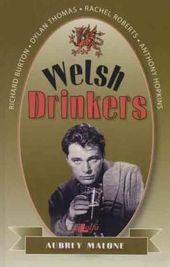
An entertaining and very much a 'tongue-in-cheek', Richard Burton related book which focuses on four Welsh celebrities, all well known for their hard drinking; Dylan Thomas, Anthony Hopkins, Rachel Roberts and of course, Richard Burton.
This edition was published and printed by Y Lolfa Cyf, based in Talybont, Ceredigion, Wales in 2009 and issued with the ISBN 978-1-84771-059-8.
This first edition paperback copy includes four individual chapters focusing on each of the celebrity names and features a black and white portrait photograph of each subject.
The publishers, in the cover notes, in outlining the subject matter of the book, write;
"it has been said that Welsh livers and kidneys are quite unlike those of the rest of the human race - which is just as well, because drinking is as much a Welsh institution as rugby and music.
This book features four famous Welsh tipplers whose lives fell apart - Richard Burton, Dylan Thomas, Rachel Roberts and Sir Anthony Hopkins, who was the only one of them that managed to conquer his addiction.
Alcoholism is the only disease that tells you that you don't have a problem - and when you're an actor or a poet, you can't turn the problem into something beautiful. This book examines how they coped with celebrity as their lives became ruled by the demon drink."
This edition was published and printed by Y Lolfa Cyf, based in Talybont, Ceredigion, Wales in 2009 and issued with the ISBN 978-1-84771-059-8.
This first edition paperback copy includes four individual chapters focusing on each of the celebrity names and features a black and white portrait photograph of each subject.
The publishers, in the cover notes, in outlining the subject matter of the book, write;
"it has been said that Welsh livers and kidneys are quite unlike those of the rest of the human race - which is just as well, because drinking is as much a Welsh institution as rugby and music.
This book features four famous Welsh tipplers whose lives fell apart - Richard Burton, Dylan Thomas, Rachel Roberts and Sir Anthony Hopkins, who was the only one of them that managed to conquer his addiction.
Alcoholism is the only disease that tells you that you don't have a problem - and when you're an actor or a poet, you can't turn the problem into something beautiful. This book examines how they coped with celebrity as their lives became ruled by the demon drink."
Robert Sellers, 'Hellraisers'
Preface Publishing, Paperback First Edition, 2009
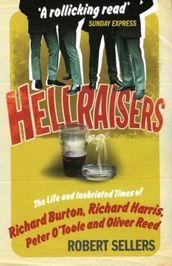
Subtitled as, 'The Life and Inebriated Times of Richard Burton, Richard Harris, Peter O'Toole and Oliver Reed', this is a first edition copy, published in paperback, of Robert Sellers' intimate biography of the four original 'Hellraisers' of the 1960's.
This edition was published by Preface Publishing, an imprint of the Random House Group based in Queen Anne's Gate, London, in 2009 and printed and bound by CPI Bookmarque, Croydon. This edition was issued with the ISBN 978-84809-018-7.
This copy is illustrated with four sections of black and white photographs featuring images from each of the subject's life and career.
The text from the cover notes,written by the publishers, reads;
"Hellraisers is the story of four of the greatest boozers who ever walked, or staggered, off a film set and into a pub. Richard Burton, Richard Harris, Peter O'Toole and Oliver Reed. It's a tale of drunken binges, parties, orgies, broken marriages, riots and wanton sexual conquests. Robert Sellers traces the intertwining lives and careers of these four actors in a celebratory catalogue of their miscreant deeds, told with humour and affection and not an ounce of moralising. Enjoy it. They bloody well did!"
This edition was published by Preface Publishing, an imprint of the Random House Group based in Queen Anne's Gate, London, in 2009 and printed and bound by CPI Bookmarque, Croydon. This edition was issued with the ISBN 978-84809-018-7.
This copy is illustrated with four sections of black and white photographs featuring images from each of the subject's life and career.
The text from the cover notes,written by the publishers, reads;
"Hellraisers is the story of four of the greatest boozers who ever walked, or staggered, off a film set and into a pub. Richard Burton, Richard Harris, Peter O'Toole and Oliver Reed. It's a tale of drunken binges, parties, orgies, broken marriages, riots and wanton sexual conquests. Robert Sellers traces the intertwining lives and careers of these four actors in a celebratory catalogue of their miscreant deeds, told with humour and affection and not an ounce of moralising. Enjoy it. They bloody well did!"
Jerry Vermilye & Mark Ricci, 'The Films of Elizabeth Taylor'
Carol Publishing Group, Revised Edition, 1989
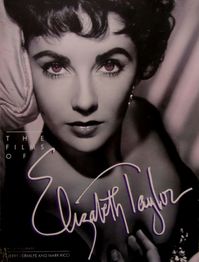
A revised and updated edition of the Jerry Vermilye and Mark Ricci large pictorial film biography entitled, 'The Films Of Elizabeth Taylor'.
Originally published in 1976, this 1989 edition was published by the Carol Publishing Group and Communications, Madison Avenue, New York, on behalf of Citadel Press Books as part of their series of 'Citadel Stars' collection.
This copy was printed and bound in the United States and was issued with the ISBN 0-8065-1151-6.
This film biographical volume is illustrated throughout with black and white photographs spanning the whole of Elizabeth Taylor's film career from the dates 1942-1989, and includes many images featuring Richard Burton taken from the eleven films they made with each other, namely, Cleopatra, The V.I.P.s, The Sandpiper, Who's Afraid Of Virginia Woolf?, The Taming Of The Shrew, Doctor Faustus, The Comedians, Boom!, Under Milk Wood, Hammersmith Is Out and finally the American two-part television drama, Divorce His: Divorce Hers.
Originally published in 1976, this 1989 edition was published by the Carol Publishing Group and Communications, Madison Avenue, New York, on behalf of Citadel Press Books as part of their series of 'Citadel Stars' collection.
This copy was printed and bound in the United States and was issued with the ISBN 0-8065-1151-6.
This film biographical volume is illustrated throughout with black and white photographs spanning the whole of Elizabeth Taylor's film career from the dates 1942-1989, and includes many images featuring Richard Burton taken from the eleven films they made with each other, namely, Cleopatra, The V.I.P.s, The Sandpiper, Who's Afraid Of Virginia Woolf?, The Taming Of The Shrew, Doctor Faustus, The Comedians, Boom!, Under Milk Wood, Hammersmith Is Out and finally the American two-part television drama, Divorce His: Divorce Hers.
Donald Spoto, 'Elizabeth Taylor'
Little, Brown & Company, First Edition, 1995
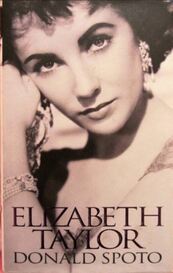
A first edition copy, in hardback, of the 1995 Donald Spoto biography of Elizabeth Taylor.
This edition was published in the U.K. by Little, Brown and Company in arrangement with Harper / Collins Publishers Incorporated and printed and bound by Clays Limited, based in St. Ives and issued with the ISBN 0-316-91451-7.
This copy is complete with the original dust-jacket and is illustrated with black and white photographs, many featuring Richard Burton, and features a beautiful sepia portrait of a young Elizabeth Taylor on the dust-jacket.
Donald Spoto is an American author and theologian and best-selling biographer of many Hollywood celebrities such as Alfred Hitchcock, Laurence Olivier, Ingrid Bergman, Grace Kelly, Marlene Dietrich, Marilyn Monroe and Audrey Hepburn.
As well as film and theatre, Donald Spoto is also the author of an in-depth history of the House of Windsor, from Queen Victoria through to Diana, Princess of Wales, as well as a book focusing on Francis of Assisi, which was made into a television documentary entitled, 'Reluctant Saint'. A native of New York, at one time he was a visiting lecturer at the British Film Institute and the National Film Theatre in London.
This edition was published in the U.K. by Little, Brown and Company in arrangement with Harper / Collins Publishers Incorporated and printed and bound by Clays Limited, based in St. Ives and issued with the ISBN 0-316-91451-7.
This copy is complete with the original dust-jacket and is illustrated with black and white photographs, many featuring Richard Burton, and features a beautiful sepia portrait of a young Elizabeth Taylor on the dust-jacket.
Donald Spoto is an American author and theologian and best-selling biographer of many Hollywood celebrities such as Alfred Hitchcock, Laurence Olivier, Ingrid Bergman, Grace Kelly, Marlene Dietrich, Marilyn Monroe and Audrey Hepburn.
As well as film and theatre, Donald Spoto is also the author of an in-depth history of the House of Windsor, from Queen Victoria through to Diana, Princess of Wales, as well as a book focusing on Francis of Assisi, which was made into a television documentary entitled, 'Reluctant Saint'. A native of New York, at one time he was a visiting lecturer at the British Film Institute and the National Film Theatre in London.
C. David Heymann, 'Liz'
William Heinemann Limited, First Edition, 1995
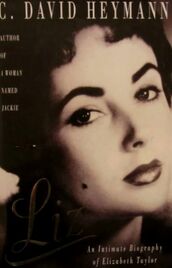
A first edition copy, published in hardback, of C. David Heymann's intimate and well-researched biography of Elizabeth Taylor simply entitled, 'Liz'.
This edition was published by William Heinemann Limited, an imprint of Reed Consumer Books Limited, London in 1995 and printed and bound by Clays Limited, based in St.Ives and issued with the ISBN 0-434-32938-X.
This copy is illustrated with black and white photographs, some featuring Richard Burton, and is complete with the original dust-jacket.
The text from the cover notes reads;
"In this long anticipated biography, C. David Heymann, author of the record-breaking number one bestseller, 'A Woman Named Jackie', tells the story of Elizabeth Taylor's remarkable life as no one else has done before.
Child-star in 'National Velvet', youthful object of desire who was controlled by her mother and MGM, Oscar-winning actress in 'Butterfield 8' and 'Who's Afraid Of Virginia Woolf?', seductress and eight-time wife, champion of funding for AIDS research, intimate of celebrities and billionaire tycoons - for more than six decades, Elizabeth Taylor has played most completely, beautifully, scandalously, flamboyantly and cunningly her greatest role of all; that of herself.
Based on more than a thousand interviews with stars, directors, producers, designers, friends, family, business associates, employees and others, and on extensive research and never-before published studio documentation,'Liz: An Intimate Biography Of Elizabeth Taylor' portrays Taylor's entire life in absorbing, fascinating and often surprising detail. Her most intimate moments, her very public escapades; readers see Liz through the eyes and voices of those who have known her best.
From the highs and lows of her movie career, to her marriages to Nicky Hilton, Michael Wilding, Mike Todd, Eddie Fisher, Richard Burton, Senator John Warner, and Larry Fortensky; from friendships with leading men Montgomery Cliff and Rock Hudson to those with eccentrics Malcolm Forbes and Michael Jackson; from countless illnesses and injuries and weight swings to battles against drug and alcohol dependencies; from sexual escapades and diamond-studded luxury to tumultuous relationships with husbands and lovers; from playing sex-symbol to becoming the grand dame of licensed perfumes and jewellery -
C. David Heymann was an American author whose previous highly-acclaimed, but controversial biographies have included studies on Jackie Kennedy, Barbara Hutton, the poet Ezra Pound and Robert Kennedy.
C. David Heymann died in 2012 at the age of sixty-seven.
This edition was published by William Heinemann Limited, an imprint of Reed Consumer Books Limited, London in 1995 and printed and bound by Clays Limited, based in St.Ives and issued with the ISBN 0-434-32938-X.
This copy is illustrated with black and white photographs, some featuring Richard Burton, and is complete with the original dust-jacket.
The text from the cover notes reads;
"In this long anticipated biography, C. David Heymann, author of the record-breaking number one bestseller, 'A Woman Named Jackie', tells the story of Elizabeth Taylor's remarkable life as no one else has done before.
Child-star in 'National Velvet', youthful object of desire who was controlled by her mother and MGM, Oscar-winning actress in 'Butterfield 8' and 'Who's Afraid Of Virginia Woolf?', seductress and eight-time wife, champion of funding for AIDS research, intimate of celebrities and billionaire tycoons - for more than six decades, Elizabeth Taylor has played most completely, beautifully, scandalously, flamboyantly and cunningly her greatest role of all; that of herself.
Based on more than a thousand interviews with stars, directors, producers, designers, friends, family, business associates, employees and others, and on extensive research and never-before published studio documentation,'Liz: An Intimate Biography Of Elizabeth Taylor' portrays Taylor's entire life in absorbing, fascinating and often surprising detail. Her most intimate moments, her very public escapades; readers see Liz through the eyes and voices of those who have known her best.
From the highs and lows of her movie career, to her marriages to Nicky Hilton, Michael Wilding, Mike Todd, Eddie Fisher, Richard Burton, Senator John Warner, and Larry Fortensky; from friendships with leading men Montgomery Cliff and Rock Hudson to those with eccentrics Malcolm Forbes and Michael Jackson; from countless illnesses and injuries and weight swings to battles against drug and alcohol dependencies; from sexual escapades and diamond-studded luxury to tumultuous relationships with husbands and lovers; from playing sex-symbol to becoming the grand dame of licensed perfumes and jewellery -
C. David Heymann was an American author whose previous highly-acclaimed, but controversial biographies have included studies on Jackie Kennedy, Barbara Hutton, the poet Ezra Pound and Robert Kennedy.
C. David Heymann died in 2012 at the age of sixty-seven.
James Christopher, 'Elizabeth Taylor - The Illustrated Biography'
Andre Deutsch Limited, First Edition, 1999
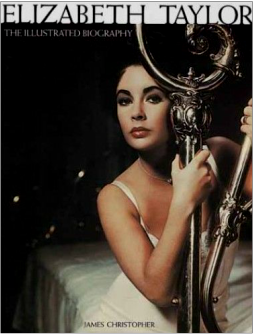
A first edition hardback copy of a large illustrated biography of Elizabeth Taylor.
This edition was published in 1999 by Andre Deutsch Limited, Dean Street, London and printed by G.E.P. S.p.A. in Italy.
The text was written by the film critic for 'The Times' newspaper, James Christopher, and the book was designed by Neal Townsend for Essential Publications and issued with the ISBN 0-233-99620-6.
This copy is illustrated throughout with stunning colour and black and white photographs, many featuring Richard Burton, which span the whole of Elizabeth Taylor's life and career.
This copy is complete with the original dust-jacket.
The cover notes of this pictorial biography read;
"From Hampstead Garden Suburb to 'International Velvet', from child star to sex siren, from 'Anthony and Cleopatra' to Michael Jackson's best friend, the story of Elizabeth Taylor's life is so extraordinary that not even the most fervently imaginative blockbuster novelist could have ever made it up.
Liz Taylor was, besides Judy Garland, the only child film star to successfully make the transition to adult star and like Garland, Taylor's life was subsequently troubled. But Liz made it through the hard times, beating alcohol addiction, some terrible fashion disasters, Richard Burton and even cancer to stand, in 1999, as the most famous woman in the world.
This book tells the full, unexpurgated story of how she made it from middle England to the top of the world - and how she tumbled down a few times, only to climb back up. Illustrated with an astonishing array of colour and stunning black and white images, this is the ultimate illustrated biography of Elizabeth Taylor.
The text, taken from the reverse of the original dust-jacket, reads;
"Elizabeth Taylor is one of the most famous people of the twentieth century. She is also one of the most beautiful. Her life has been a rollercoaster ride of highs and lows. From humble English suburban beginnings to the apex of the Hollywood Hills, Liz Taylor has known great love, great sorrow, basked in the admiration of millions of film fans and attempted to hide from the unforgiving glare of paparazzi photographers as she battled addictions, illnesses and weight problems.
Her every step, every stumble along the gilded pathway to film and television glory has been captured on film and in print. This book presents a no-holds barred look at the life and turbulent times of Elizabeth Taylor - film star, seven times wife, recovering alcoholic, cancer sufferer and idol to millions.
Illustrated with over one hundred classic and rare images of one of the world's most beautiful women".
This edition was published in 1999 by Andre Deutsch Limited, Dean Street, London and printed by G.E.P. S.p.A. in Italy.
The text was written by the film critic for 'The Times' newspaper, James Christopher, and the book was designed by Neal Townsend for Essential Publications and issued with the ISBN 0-233-99620-6.
This copy is illustrated throughout with stunning colour and black and white photographs, many featuring Richard Burton, which span the whole of Elizabeth Taylor's life and career.
This copy is complete with the original dust-jacket.
The cover notes of this pictorial biography read;
"From Hampstead Garden Suburb to 'International Velvet', from child star to sex siren, from 'Anthony and Cleopatra' to Michael Jackson's best friend, the story of Elizabeth Taylor's life is so extraordinary that not even the most fervently imaginative blockbuster novelist could have ever made it up.
Liz Taylor was, besides Judy Garland, the only child film star to successfully make the transition to adult star and like Garland, Taylor's life was subsequently troubled. But Liz made it through the hard times, beating alcohol addiction, some terrible fashion disasters, Richard Burton and even cancer to stand, in 1999, as the most famous woman in the world.
This book tells the full, unexpurgated story of how she made it from middle England to the top of the world - and how she tumbled down a few times, only to climb back up. Illustrated with an astonishing array of colour and stunning black and white images, this is the ultimate illustrated biography of Elizabeth Taylor.
The text, taken from the reverse of the original dust-jacket, reads;
"Elizabeth Taylor is one of the most famous people of the twentieth century. She is also one of the most beautiful. Her life has been a rollercoaster ride of highs and lows. From humble English suburban beginnings to the apex of the Hollywood Hills, Liz Taylor has known great love, great sorrow, basked in the admiration of millions of film fans and attempted to hide from the unforgiving glare of paparazzi photographers as she battled addictions, illnesses and weight problems.
Her every step, every stumble along the gilded pathway to film and television glory has been captured on film and in print. This book presents a no-holds barred look at the life and turbulent times of Elizabeth Taylor - film star, seven times wife, recovering alcoholic, cancer sufferer and idol to millions.
Illustrated with over one hundred classic and rare images of one of the world's most beautiful women".
J. Randy Taraborrelli, 'Elizabeth'
Pan Books, First Edition Softback Edition, 2006
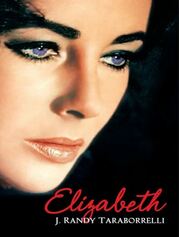
A first edition copy of the paperback edition of J. Randy Taraborrelli's detailed and in-depth biography of Elizabeth Taylor simply entitled, ''Elizabeth'.
The biography was first published in 2006 by Warner Books in America, this however is the U.K. first edition paperback copy which was published by Pan Books, a division of Macmillan Publishers Limited, based in Basingstoke and Oxford.
This edition was printed and bound by MacKays of Chatham, issued with the ISBN 978-0-330-43390-7 and illustrated with black and white photographs, many featuring Richard Burton together with Elizabeth Taylor.
The text, written by the publishers, from the cover notes reads;
"A legendary screen icon, the epitome of beauty, Elizabeth Taylor has long been surrounded by the aura of fame and notoriety. Now acclaimed biographer J. Randy Taraborrelli describes how she evolved from a dazzling but manipulated child star to a woman in her own right.
Taraborrelli brings to life the people around her and her stunning rise in 1940's Hollywood. He examines her eight marriages to seven men, including her abusive relationship with Nicky Hilton, her attraction to swashbuckling Mike Todd, and the complex, incendiary Taylor-Burton love affair that continued for decades and never truly died.
Finally, Taraborrelli chronicles what may be Elizabeth Taylor's most bravura performance of all. Despite the broken marriages and the highly public battles with substance abuse and chronic illness, Elizabeth achieved what few celebrities ever do; she found new success and sustenance in family, friendships and philanthropy.
'Elizabeth' is the brilliantly rendered, touching and bracingly honest story of a woman you thought you knew - and can now finally begin to understand".
Christopher Silvester of 'The Sunday Times' commented in his review of 'Elizabeth';
"Taraborelli keeps the story moving and persuades us that Taylor is a more complex, courageous and likeable person than her pampered celebrity image suggests. He has unearthed plenty of new sources.
The biography was first published in 2006 by Warner Books in America, this however is the U.K. first edition paperback copy which was published by Pan Books, a division of Macmillan Publishers Limited, based in Basingstoke and Oxford.
This edition was printed and bound by MacKays of Chatham, issued with the ISBN 978-0-330-43390-7 and illustrated with black and white photographs, many featuring Richard Burton together with Elizabeth Taylor.
The text, written by the publishers, from the cover notes reads;
"A legendary screen icon, the epitome of beauty, Elizabeth Taylor has long been surrounded by the aura of fame and notoriety. Now acclaimed biographer J. Randy Taraborrelli describes how she evolved from a dazzling but manipulated child star to a woman in her own right.
Taraborrelli brings to life the people around her and her stunning rise in 1940's Hollywood. He examines her eight marriages to seven men, including her abusive relationship with Nicky Hilton, her attraction to swashbuckling Mike Todd, and the complex, incendiary Taylor-Burton love affair that continued for decades and never truly died.
Finally, Taraborrelli chronicles what may be Elizabeth Taylor's most bravura performance of all. Despite the broken marriages and the highly public battles with substance abuse and chronic illness, Elizabeth achieved what few celebrities ever do; she found new success and sustenance in family, friendships and philanthropy.
'Elizabeth' is the brilliantly rendered, touching and bracingly honest story of a woman you thought you knew - and can now finally begin to understand".
Christopher Silvester of 'The Sunday Times' commented in his review of 'Elizabeth';
"Taraborelli keeps the story moving and persuades us that Taylor is a more complex, courageous and likeable person than her pampered celebrity image suggests. He has unearthed plenty of new sources.
John Gielgud, 'An Actor and His Time'
Sidgewick & Jackson, First Edition, 1979
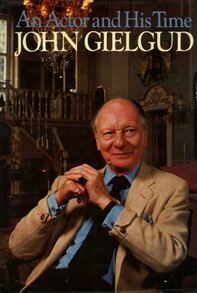
A first edition copy, published in hardback, of Sir John Gielgud's detailed and fascinating memoir which he entitled, 'An Actor And His Time'.
Written in collaboration with John Miller and John Powell, this absorbing personal account of John Gielgud's life in the theatre was published by Sidgwick And Jackson, Bloomsbury Way, London and printed by The Garden City Press, based in Letchworth, Hertfordshire in 1979.
This edition is Illustrated throughout with colour and black and white photographs tracing the full and remarkable theatrical career of Sir John Gielgud.
Richard Burton's performances in 'The Lady's Not For Burning' and John Gielgud's own production of 'Hamlet' are highlighted and commented on by Gielgud in this excellent and detailed autobiography.
This edition was issued with the ISBN 0-283-98573-9 and is complete with the original dust-jacket.
The text from the cover notes, written by the publishers, begins with Sir John's own words and reads;
"Like all professions, acting has terrible drawbacks. It can be fearfully boring, fearfully unglamorous, filming or theatre or radio, or anything else, but what is fun about the theatre and about our profession is we do get our prizes while we are alive to enjoy them. we have the pleasure of the audience's reaction, we have the applause, we have the publicity, we have the tribute and the honours and whatever it may be, much more than probably we deserve..."
In 1921, the Old Vic production of 'Henry V' was marked by the professional debut of a seventeen year-old actor playing the Herald, John Gielgud. Then he had only one line. Over the six decades since, he has become recognised as one of the great classic actors of our times.He has not only played most of the leading Shakespearean parts, but has also created roles in plays by David Storey, Edward Bond and Harold Pinter, and has taken many varied roles in film, television and radio productions.
In this book, John Gielgud tells the story of his life in the theatre, of the plays he starred in, and directed, of the actors and actresses he worked with - from Mrs.Patrick Campbell to Richard Burton - and of the theatres in which he has played - from New York to Rangoon. He also tells of the theatre he knew as a young man, the theatre that was run by the great actor / managers, men like Tree and du Maurier, and of the star actresses whose name alone could fill a theatre - Eleonora Duse, Sarah Bernhardt and, of course, his own great-aunt, Ellen Terry.
With the aid of many photographs from his own collection, Sir John Gielgud has made this book not only a fascinating account of his own life, but also a well documented record of the last fifty years of the British theatre".
A more thorough history of the role John Gielgud played in the early theatrical success of Richard Burton, as well as a detailed biography of Gielgud can be found on the 'Burton In The Theatre' and 'Burton People' pages of this website.
Written in collaboration with John Miller and John Powell, this absorbing personal account of John Gielgud's life in the theatre was published by Sidgwick And Jackson, Bloomsbury Way, London and printed by The Garden City Press, based in Letchworth, Hertfordshire in 1979.
This edition is Illustrated throughout with colour and black and white photographs tracing the full and remarkable theatrical career of Sir John Gielgud.
Richard Burton's performances in 'The Lady's Not For Burning' and John Gielgud's own production of 'Hamlet' are highlighted and commented on by Gielgud in this excellent and detailed autobiography.
This edition was issued with the ISBN 0-283-98573-9 and is complete with the original dust-jacket.
The text from the cover notes, written by the publishers, begins with Sir John's own words and reads;
"Like all professions, acting has terrible drawbacks. It can be fearfully boring, fearfully unglamorous, filming or theatre or radio, or anything else, but what is fun about the theatre and about our profession is we do get our prizes while we are alive to enjoy them. we have the pleasure of the audience's reaction, we have the applause, we have the publicity, we have the tribute and the honours and whatever it may be, much more than probably we deserve..."
In 1921, the Old Vic production of 'Henry V' was marked by the professional debut of a seventeen year-old actor playing the Herald, John Gielgud. Then he had only one line. Over the six decades since, he has become recognised as one of the great classic actors of our times.He has not only played most of the leading Shakespearean parts, but has also created roles in plays by David Storey, Edward Bond and Harold Pinter, and has taken many varied roles in film, television and radio productions.
In this book, John Gielgud tells the story of his life in the theatre, of the plays he starred in, and directed, of the actors and actresses he worked with - from Mrs.Patrick Campbell to Richard Burton - and of the theatres in which he has played - from New York to Rangoon. He also tells of the theatre he knew as a young man, the theatre that was run by the great actor / managers, men like Tree and du Maurier, and of the star actresses whose name alone could fill a theatre - Eleonora Duse, Sarah Bernhardt and, of course, his own great-aunt, Ellen Terry.
With the aid of many photographs from his own collection, Sir John Gielgud has made this book not only a fascinating account of his own life, but also a well documented record of the last fifty years of the British theatre".
A more thorough history of the role John Gielgud played in the early theatrical success of Richard Burton, as well as a detailed biography of Gielgud can be found on the 'Burton In The Theatre' and 'Burton People' pages of this website.
Jonathan Croall, 'Gielgud - A Theatrical Life 1904 - 2000'
Continuum Publishing, American First Edition, 2001
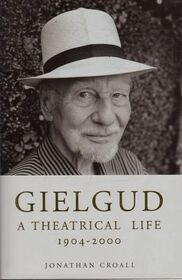
An American, hardback first edition copy, of Jonathan Croall's detailed and intimate biography entitled 'Gielgud - A Theatrical Life 1904-2000'.
This edition was published and printed by The Continuum International Publishing Group Incorporated, Lexington Avenue, New York in 2001 and was issued with the ISBN 0-8264-1333-1.
Illustrated with black and white photographs, this fascinating biography features many passages relating to Richard Burton with regard to John Gielgud's association with him during such theatrical productions as,'The Lady's Not For Burning','The Boy With A Cart' and 'Hamlet' as well as film collaborations which included 'Becket' in 1964 and 'Wagner' in 1983.
A passage concerning Richard Burton's performance in Christopher Fry's 'The Boy With A Cart', reads;
'Written for a local amateur festival in 1938, the play concerned the early life of St. Cuthman. Burton, in the title-role, gave a moving performance; Gielgud thought him 'spell-binding'. Fry remembers that he rehearsed Burton with tears running down his cheeks, working hard 'trying to get him loosened up'. Beaumont noticed that he was getting Burton to lose some of his rough edges, and allowing his natural charm to surface.As a result of his performance, Burton was offered the parts of Prince Hal and Henry V in Stratford's Festival of Britain offering of the 'Henry' plays. His career then went into spectacular orbit. Gielgud remained Burton's idol for life.'
This first edition copy is complete with the original dust-jacket.
The cover notes, which also feature part of a contemporary review which appeared in 'The Publishers Weekly', read;
"On his death John Gielgud was widely acclaimed as the greatest classical actor of the twentieth century, and the finest interpreter of Shakespeare. This biography is the first to cover in full an astonishing career, spanning nearly eighty years in films, radio, television and the theatre.
For his entertaining, critical and widely researched book Jonathan Croall talked in detail to more than two hundred friends and colleagues who worked with Gielgud. They include actors such as Alec Guinness, John Mills, Dorothy Tutin, Dirk Bogarde, Sarah Miles, Peter Ustinov, Virginia McKenna, Richard Briers, Anna Carteret and Michael Pennington; the playwrights Edward Albee, Christopher Fry, David Storey and Charles Wood; directors such as Peter Brook, William Gaskill and John Schlesinger; and the designers Tanya Moiseiwitsch, Jocelyn Herbert, and Margaret Harris of Motley.
The book vividly captures Gielgud's childhood among his famous Terry relations, his early struggles as a young actor and his triumphs in Shakespeare at the Old Vic under Lilian Baylis. It highlights his trailblazing as a director and actor-manager in the 1930s and 1940s, and looks at the influence on his work of key figures such as J. B. Fagen, Nigel Playfair, Theodore Komisarjevsky, Michael Saint-Denis and, above all, Harley Granville-Barker. It reveals how he courageously overcame a humiliating scandal to re-invent himself in the work of the new playwrights of the 1960s and 1970s, and ends with a fascinating account of his late flowering as an Oscar-winning movie star.
It also provides a revealing picture of his celebrated rivalry with Laurence Olivier, his deep friendship with Ralph Richardson, his scintillating stage partnerships with Peggy Ashcroft and Edith Evans, and his profound influence on younger actors such as Alec Guinness, Michael Redgrave and Paul Schofield.
Gielgud emerges as a man of conflicting qualities: proud and modest, sensitive and tactless, ambitious and unselfish, daring and insecure. His wit, humanity and dedication to the theatre shine through this compelling portrait of a remarkable and much-loved man."
'The Publishers Weekly', in their review wrote;
"An elegant, finely researched biography, Croall has done tremendously thorough and sensitive work, making extensive use of his interviews with more than a hundred of Gielgud's co-stars and colleagues, and selectively using such sources as memoirs, journals and press-clippings, never substituting them for his own interpretations or observations.
Although Croall is most interested in Gielgud's professional accomplishments, he also provides well-observed sense of the actor's personal life, including his long-term relationship with the handsome and reclusive Martin Hensler. Other biographies of Gielgud will no doubt be forthcoming, but Croall has set a high standard".
The Daily Telegraph was to add;
"Jonathan Croall honours what was best in Gielgud..his modesty, his dedication to his craft and his generosity towards his fellow actors. He captures the essence of the man, not least his endearing gift for self-mockery".
This edition was published and printed by The Continuum International Publishing Group Incorporated, Lexington Avenue, New York in 2001 and was issued with the ISBN 0-8264-1333-1.
Illustrated with black and white photographs, this fascinating biography features many passages relating to Richard Burton with regard to John Gielgud's association with him during such theatrical productions as,'The Lady's Not For Burning','The Boy With A Cart' and 'Hamlet' as well as film collaborations which included 'Becket' in 1964 and 'Wagner' in 1983.
A passage concerning Richard Burton's performance in Christopher Fry's 'The Boy With A Cart', reads;
'Written for a local amateur festival in 1938, the play concerned the early life of St. Cuthman. Burton, in the title-role, gave a moving performance; Gielgud thought him 'spell-binding'. Fry remembers that he rehearsed Burton with tears running down his cheeks, working hard 'trying to get him loosened up'. Beaumont noticed that he was getting Burton to lose some of his rough edges, and allowing his natural charm to surface.As a result of his performance, Burton was offered the parts of Prince Hal and Henry V in Stratford's Festival of Britain offering of the 'Henry' plays. His career then went into spectacular orbit. Gielgud remained Burton's idol for life.'
This first edition copy is complete with the original dust-jacket.
The cover notes, which also feature part of a contemporary review which appeared in 'The Publishers Weekly', read;
"On his death John Gielgud was widely acclaimed as the greatest classical actor of the twentieth century, and the finest interpreter of Shakespeare. This biography is the first to cover in full an astonishing career, spanning nearly eighty years in films, radio, television and the theatre.
For his entertaining, critical and widely researched book Jonathan Croall talked in detail to more than two hundred friends and colleagues who worked with Gielgud. They include actors such as Alec Guinness, John Mills, Dorothy Tutin, Dirk Bogarde, Sarah Miles, Peter Ustinov, Virginia McKenna, Richard Briers, Anna Carteret and Michael Pennington; the playwrights Edward Albee, Christopher Fry, David Storey and Charles Wood; directors such as Peter Brook, William Gaskill and John Schlesinger; and the designers Tanya Moiseiwitsch, Jocelyn Herbert, and Margaret Harris of Motley.
The book vividly captures Gielgud's childhood among his famous Terry relations, his early struggles as a young actor and his triumphs in Shakespeare at the Old Vic under Lilian Baylis. It highlights his trailblazing as a director and actor-manager in the 1930s and 1940s, and looks at the influence on his work of key figures such as J. B. Fagen, Nigel Playfair, Theodore Komisarjevsky, Michael Saint-Denis and, above all, Harley Granville-Barker. It reveals how he courageously overcame a humiliating scandal to re-invent himself in the work of the new playwrights of the 1960s and 1970s, and ends with a fascinating account of his late flowering as an Oscar-winning movie star.
It also provides a revealing picture of his celebrated rivalry with Laurence Olivier, his deep friendship with Ralph Richardson, his scintillating stage partnerships with Peggy Ashcroft and Edith Evans, and his profound influence on younger actors such as Alec Guinness, Michael Redgrave and Paul Schofield.
Gielgud emerges as a man of conflicting qualities: proud and modest, sensitive and tactless, ambitious and unselfish, daring and insecure. His wit, humanity and dedication to the theatre shine through this compelling portrait of a remarkable and much-loved man."
'The Publishers Weekly', in their review wrote;
"An elegant, finely researched biography, Croall has done tremendously thorough and sensitive work, making extensive use of his interviews with more than a hundred of Gielgud's co-stars and colleagues, and selectively using such sources as memoirs, journals and press-clippings, never substituting them for his own interpretations or observations.
Although Croall is most interested in Gielgud's professional accomplishments, he also provides well-observed sense of the actor's personal life, including his long-term relationship with the handsome and reclusive Martin Hensler. Other biographies of Gielgud will no doubt be forthcoming, but Croall has set a high standard".
The Daily Telegraph was to add;
"Jonathan Croall honours what was best in Gielgud..his modesty, his dedication to his craft and his generosity towards his fellow actors. He captures the essence of the man, not least his endearing gift for self-mockery".
'Gielgud's Letters' Edited by Richard Mangan
Weidenfeld And Nicolson, First Edition, 2004
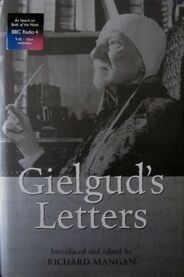
Published by Weidenfeld and Nicolson, a division of the Orion Publishing Group Limited and printed and bound by Butler and Tanner Limited, based in Frome and London, this is the 2004 first edition, published in hardback, of 'Gielgud's Letters'.
This incredibly well-researched and absorbing collection of letters, dating from as early as 1912 and continuing through the decades up until just before his death in May 2000 was edited by Richard Mangan, the administrator of the Raymond Mander and Joe Mitchenson Theatre Collection, based in Greenwich.
This edition contains many chapters relating to both the theatrical and film careers of Richard Burton and is illustrated with colour and black and white photographs from Sir John Gielgud's own personal collection.
A nice example of a Richard Burton related letter is this, written to Emlyn Williams during rehearsals for 'Hamlet' in 1964;
"Richard is at his most agreeable - full of charm and quick to take criticism and advice - but he does put away the drink, and looks terribly coarse and heavy - gets muddled and fluffy and then loses all his nimbleness and attack. But he has given one or two really beautiful rehearsals, and I have a wonderfully good and enthusiastic company, so I live in hope."
Another letter, written to Richard Burton himself and dated the 26th of May 1983, concerns Tony Palmer's nine-hour, epic biopic, 'Wagner' in which Burton played the lead;
"I sat through six and a half hours of 'Wagner' - very sad that all the beauty and many good performances are nullified by the length and endless abstract shots which slow everything up just as one is getting interested in the story and characters. And the soundtrack is abominable - overwhelming musical background, all snippets from the operas but much of them repeated far too often - and one hears heavy breathing and crackles all the time. I can't think they will ever manage to sell it. It was agony to sit through but as I was next to Tony Palmer's mother, I tried to conceal my weariness and irritation."
A final, rather poignant, Burton related letter was written to Claire Bloom late August of 1984 and reads;
"I am very sad about Richard, but the razzmatazz since he died is really rather embarrassingly overstated, and I can't help feeling very sorry for Elizabeth, of whom Martin and I both became very fond when we saw a good deal of her over the American Hamlet. She has been so persistently pursued and harassed, and I think has behaved unexpectedly tactfully in keeping as far away as possible. We have the Memorial Service on the 30th at St. Martin's, where I have to read some Shakespeare, with Emlyn to speak the address and Paul Scofield also taking part. I dread the crowds and reporters as you can imagine. I saw a good deal of Richard three years ago, when we were both making Wagner, (which turned out a terrible mess, cost millions and no channel would touch it either in England or America). He was looking terribly ravaged - was between wives, (though he married the continuity girl afterwards) and we lunched every day together in his caravan, a nice elderly lady looking after him and a therapist-masseur coping with his back and arms, both of which were giving him trouble. He dined with me the last evening of my work in Vienna and insisted on giving me a most lavish present - nine silver wine coasters. Then almost a year later, he suddenly rang me up at the Dorchester where I was filming a short scene. He had had quite a big operation, had married the new girl, and seemed in terrific form, looking really well again - off the drink, presumably - and so smart, in a beautiful Palm Beach suit. Ah well!"
This copy of 'Gielgud's Letters' was published by Weidenfeld and Nicolson and issued with the ISBN 0-297-82989-0 and is complete with the original dust-jacket.
The publisher's cover notes describe this fascinating collection of correspondence as follows;
"John Gielgud wrote letters almost every day of his adult life. Whether at home in London and later in Buckinghamshire, or acting abroad or on location, he delighted in sitting down each day and recounting what had been going on and what he felt about events around him.
Not long before his death aged ninety-six in May 2000, he was still writing in an increasingly idiosyncratic and minuscule hand, which he confessed even he required a magnifying glass to read.
Through the letters, which began with those to his mother, we meet a man who delights in gossip, in describing what he sees and experiences.
Here for the first time - and not previously available to biographers - are some of Gielgud's love letters. They show that he was not shy in expressing the intimacies of personal relationships.
Gielgud had a reputation for speaking his mind, and this is evident as he writes about his contemporaries, including the great actors of the period: Olivier, Richardson, Redgrave, Peggy Ashcroft, Edith Evans and the like.
Here is a rich life seen through eighty years of letter-writing before the age of e-mail".
This incredibly well-researched and absorbing collection of letters, dating from as early as 1912 and continuing through the decades up until just before his death in May 2000 was edited by Richard Mangan, the administrator of the Raymond Mander and Joe Mitchenson Theatre Collection, based in Greenwich.
This edition contains many chapters relating to both the theatrical and film careers of Richard Burton and is illustrated with colour and black and white photographs from Sir John Gielgud's own personal collection.
A nice example of a Richard Burton related letter is this, written to Emlyn Williams during rehearsals for 'Hamlet' in 1964;
"Richard is at his most agreeable - full of charm and quick to take criticism and advice - but he does put away the drink, and looks terribly coarse and heavy - gets muddled and fluffy and then loses all his nimbleness and attack. But he has given one or two really beautiful rehearsals, and I have a wonderfully good and enthusiastic company, so I live in hope."
Another letter, written to Richard Burton himself and dated the 26th of May 1983, concerns Tony Palmer's nine-hour, epic biopic, 'Wagner' in which Burton played the lead;
"I sat through six and a half hours of 'Wagner' - very sad that all the beauty and many good performances are nullified by the length and endless abstract shots which slow everything up just as one is getting interested in the story and characters. And the soundtrack is abominable - overwhelming musical background, all snippets from the operas but much of them repeated far too often - and one hears heavy breathing and crackles all the time. I can't think they will ever manage to sell it. It was agony to sit through but as I was next to Tony Palmer's mother, I tried to conceal my weariness and irritation."
A final, rather poignant, Burton related letter was written to Claire Bloom late August of 1984 and reads;
"I am very sad about Richard, but the razzmatazz since he died is really rather embarrassingly overstated, and I can't help feeling very sorry for Elizabeth, of whom Martin and I both became very fond when we saw a good deal of her over the American Hamlet. She has been so persistently pursued and harassed, and I think has behaved unexpectedly tactfully in keeping as far away as possible. We have the Memorial Service on the 30th at St. Martin's, where I have to read some Shakespeare, with Emlyn to speak the address and Paul Scofield also taking part. I dread the crowds and reporters as you can imagine. I saw a good deal of Richard three years ago, when we were both making Wagner, (which turned out a terrible mess, cost millions and no channel would touch it either in England or America). He was looking terribly ravaged - was between wives, (though he married the continuity girl afterwards) and we lunched every day together in his caravan, a nice elderly lady looking after him and a therapist-masseur coping with his back and arms, both of which were giving him trouble. He dined with me the last evening of my work in Vienna and insisted on giving me a most lavish present - nine silver wine coasters. Then almost a year later, he suddenly rang me up at the Dorchester where I was filming a short scene. He had had quite a big operation, had married the new girl, and seemed in terrific form, looking really well again - off the drink, presumably - and so smart, in a beautiful Palm Beach suit. Ah well!"
This copy of 'Gielgud's Letters' was published by Weidenfeld and Nicolson and issued with the ISBN 0-297-82989-0 and is complete with the original dust-jacket.
The publisher's cover notes describe this fascinating collection of correspondence as follows;
"John Gielgud wrote letters almost every day of his adult life. Whether at home in London and later in Buckinghamshire, or acting abroad or on location, he delighted in sitting down each day and recounting what had been going on and what he felt about events around him.
Not long before his death aged ninety-six in May 2000, he was still writing in an increasingly idiosyncratic and minuscule hand, which he confessed even he required a magnifying glass to read.
Through the letters, which began with those to his mother, we meet a man who delights in gossip, in describing what he sees and experiences.
Here for the first time - and not previously available to biographers - are some of Gielgud's love letters. They show that he was not shy in expressing the intimacies of personal relationships.
Gielgud had a reputation for speaking his mind, and this is evident as he writes about his contemporaries, including the great actors of the period: Olivier, Richardson, Redgrave, Peggy Ashcroft, Edith Evans and the like.
Here is a rich life seen through eighty years of letter-writing before the age of e-mail".
This page was updated on the 24th of April, 2022

